
- Exploring Chiapas, Mexico: Your Ultimate Travel Guide

Here is your Chiapas Travel Guide, for a land of breathtaking beauty and rich cultural heritage. In this comprehensive Chiapas travel guide, we invite you to embark on an extraordinary journey through some of the region’s most captivating destinations. From the colonial charm of San Cristobal de las Casas to the ancient ruins of Palenque and Yaxchilán, and the natural wonders of Agua Azul and Misol-ha, Chiapas offers a wealth of experiences waiting to be discovered.


San Cristobal de las Casas: Colonial Charm and Indigenous Culture
Nestled in the highlands of Chiapas, San Cristobal de las Casas delights visitors. It has a lovely vibe with its cobblestone streets, colorful facades, and vibrant markets. Explore the historic city center, home to landmarks such as the San Cristobal Cathedral and the lively Mercado de Santo Domingo. Immerse yourself in the local culture and traditions. Don’t miss the opportunity to sample traditional Chiapanecan cuisine. While in San Cris, don´t miss a day trip to the nearby town of San Juan Chamula. It has a fascinating church that is well worth the visit. You probably will never see anything like the inside of this church with very unique indigenous decorations and practices.
Where to Stay in San Cristobal de las Casas:
La Abuelita is a really nice and centrally located. Hostel and El Mirador is a backpackers hostel where it´s easy to meet fellow travelers.

Related Posts
Top destinations in panama: san blas islands, valle de antón, panama city and playa venao.
- Must visit places in Mexico
- Oaxaca Travel Guide
Write A Comment Cancel Reply
Save my name, email, and website in this browser for the next time I comment.
- Democratic republic of congo
- Philippines
- Aruba on a Budget
- The Dominican Republic on a Budget
- Israel Palestine
- Discovering the Vibrant Soul of Cali, Colombia: Unveiling the Top 10 Experiences
- Palomino, Mendihuaca & Minca
- Visiting Caño Cristales in Colombia: The most beautiful river in the world
- Visiting Lago de Tota in Boyacá, Colombia
- Visiting Santander, Colombia
- Visiting San Basilio de Palenque
- The Huasteca Potosina: Complete Travel Guide
- The State of Querétaro: Mexico’s Hidden Gem
- Photography and Artwork
- Work with Me
- Accommodation
- Essential Gear
- Transportation
- Travel Insurance
- Volunteer / Work Abroad
- Search Please fill out this field.
- Manage Your Subscription
- Give a Gift Subscription
- Newsletters
- Sweepstakes
- Destinations
Chiapas Is the Key to Understanding Mexico's Rich Indigenous Heritage
Steeped in Mayan heritage, the country’s southernmost state is Mexico at its most unexpected.
As I stood outside the Iglesia de San Juan de Bautista in the village of San Juan Chamula in Chiapas, Mexico, I marveled at the artistry of the traditional dress worn by the congregants filing in. Women of every age showed off ornately embroidered black sheepskin skirts and sashes and blouses the color of Easter eggs. It was a reminder of Chamula's status as a stronghold of ancient Tzotzil and Tzeltal Mayan culture — and the resilience of its native communities , which were exploited and displaced after the arrival of the Spanish in the 16th century.
Shyly, I poked my head inside the church. The haze of copal incense smoke, flickering candlelight, and the low hum of prayer drew me in. At first, the religious cues felt familiar enough. Worshippers knelt amid thousands of candles as rays of morning light streaked through windows into the cavernous space. But as my eyes adjusted to the dim glow, I realized everything else was unfamiliar. There were no pews, no formal mass, no crucifixes. Instead, saints with the iconographic power of Mayan deities lined the walls. Sewn onto their clothing were mirrors, which are thought to reflect the sins of onlookers and to serve as gateways to the spirit world for true believers.
Like most Indigenous groups in the largely agrarian southern state of Chiapas, the Chamulans believe they live at the center of the earth. Their religion, Mexican syncretism, worships the forces of nature, the animals of the jungle, and the planets in the sky. It's combined with a form of Catholicism that places John the Baptist above Christ. From my position at the back of the church, I watched a middle-aged shaman attend to a young boy whose head was wrapped in white gauze. Rocking back and forth, she took his pulse as his parents hovered, their eyes closed in prayer.
Chiapas is almost entirely forested, rising gently, and then precipitously, from the Pacific coastal jungles to the central highlands, before reaching 13,850 feet at the peak of the Sierra Madre de Chiapas. More than 25 percent of the state's roughly four million inhabitants are Indigenous, and most of its 12 ethnic groups trace their roots to pre-Columbian Mayan peoples.
Following Mexico's independence in 1821, a small landowning elite replaced the colonial rulers, and most of the farmers (except those who joined farming collectives) transitioned from slavery to serfdom. Linked with Guatemala during the colonial era, Chiapas only became part of Mexico in 1824 and never attracted the kind of investment in industry and infrastructure of other, more mineral-rich states.
Today Chiapas is, on paper, the country's poorest state, and yet I didn't come across a single panhandler — only a handful of vendors who asked for a "donation" when they hadn't succeeded in closing a sale. Nor did I encounter a single unreturned smile. Unlike in densely populated cities to the north, I saw an almost familial sense of community everywhere I looked.
For travelers, Chiapas' isolation and rugged landscape are both a gift and a curse (there are no direct flights from the U.S., so most visitors connect through Mexico City ). There's also a lingering wariness due to the legacy of the Zapatista anti-globalization uprising that paralyzed the Mexican government in 1994, for which the region has become synonymous.
But now, with more travelers interested in understanding Mexico's Indigenous heritage (and thanks to a few truly excellent hotels and restaurants), the region is being recognized for its cultural and creative offerings. In Chiapas, travelers will find a bewitching mix of ancient and modern culture that's distinct from any other in the country.
Planning a Trip
If it's your first time in Chiapas, you'll need five to seven days to cover the region's dizzying trifecta of craftsmanship, nature, and archaeology — and have enough hang time in dreamy San Cristóbal de Las Casas, the state's third-largest (and arguably most beautiful) city. Plan to spend the first three or four nights in the San Cristóbal highlands, where you can take half and full-day trips to visit weavers, ceramists, and markets. You can also witness ceremonies in the Indigenous municipalities of Zinacantán, Chamula, and Tenejapa.
San Cristóbal's historic center, meanwhile, offers abundant shopping, eating, and cultural experiences. It can also be a base for day trips to national parks and natural attractions like El Chiflón waterfall, where the main cascade drops 393 feet. It's hard to wrap your head around the region's extreme microclimates: on the same day, you might need a puffer jacket in the morning as you set out from the San Cristóbal highlands and end up sweating through a tank top in the afternoon as you hike through the waterfall mist in El Arcotete National Park. You'll also want to make pilgrimages to the spectacular archaeological sites of Toniná and Palenque.
Though I had fantasies of renting a car and crisscrossing the region on my own , I quickly realized there was too much ground to cover. Even if you speak Spanish and trust your navigational skills, you will want the political, cultural, and historic context a skilled guide can offer. That's why I enlisted the tour operator Journey Mexico, both for the deep knowledge of their seasoned local guides and for their help with logistics. Here's my suggested itinerary, broken down into regions.
Tuxtla Gutiérrez
You will likely connect through Mexico City by plane to Chiapas's state capital, Tuxtla Gutiérrez, but will probably want to stay in the region's de facto cultural capital, San Cristóbal de Las Casas (about an hour's drive away). Take an early flight so you can hit the awe-inspiring — if touristy — Sumidero Canyon en route to San Cristóbal. Formed 35 million years ago by cracks in the earth's crust and erosion by the Grijalva River, Sumidero is a showstopper on a par with Yosemite's El Capitan. If you have the energy after your flight, you can even hire a boat for a two-hour ride from Chiapa de Corzo along the Grijalva — the waters of which reach eerie depths of up to 860 feet — to the Chicoasen Dam and back. A welcome reprieve from the heat, the boat trip takes you within arm's length of waterfalls, spider monkeys, ocelots, and crocodiles sunning themselves along the riverbanks.
Chiapa de Corzo, about 30 minutes east of Tuxtla, is an iconic Spanish colonial town that's also worth a quick lap. The colonnaded square centers on a 459-year-old fountain that's dedicated to a group of Indigenous resistance fighters who are said to have jumped to their deaths in Sumidero Canyon rather than surrender to the invading Spanish army.
San Cristóbal de las Casas
The city, which was a Spanish stronghold against Mayan freedom fighters in 1528, is quickly nipping at Oaxaca 's heels as Mexico's artisan capital. With a growing number of stylish boutique hotels and destination restaurants, the place has graduated from a backpacker haven to a destination for the creative arts. Its colonial-style buildings, with their wooden colonnades and red-tiled roofs, as well as its cobblestoned pedestrian streets, have also helped to draw its growing community of artistic expats (as well as its left-leaning politics). In Chiapas, there's nowhere else like it.
San Cristóbal is easily navigated on foot, and I ducked in and out of museums, stores, and cafes without much planning. At night, the streets, bars, and restaurants came to life with locals and tourists. It felt like a college town, only for grown-ups, with its mix of tradition, political charge, and sense of optimism.
On my second day, I met Margarita Cantu while she was replenishing some pieces from her clothing line at the beautiful boutique inside Hotel Bo. The 40-year-old Monterrey, Mexico-born artist and designer works with some 150 weavers from nearby communities for her women's clothing and home goods line, Omorika. After starting her career in fashion in New York City, she arrived in San Cristóbal 12 years ago for a month-long stint to learn traditional weaving techniques — and never left. She told me it was "the mix of conflicts and traditions that make every day interesting" that kept her in town.
Walk Through the Ancient Mayan City of Calakmul | Walk with Travel + Leisure | Travel + Leisure
Amatenango del valle and zinacantán.
About an hour's drive south of San Cristóbal I visited the small town of Amatenango del Valle. It's where Juana "Juanita" Gómez Ramírez has her studio showroom, Taller y Galería Artesanal. She is something of a celebrity ceramist, known for her intricately painted sculptures of jaguars and fish, and her operation is a big source of employment in the community.
And in Zinacantán the next day, I visited the home of Catalina Pérez Hernández, who weaves textiles using the traditional backstrap loom (appointments with her are offered exclusively through Journey Mexico). Her shop has an impressive selection of embroidered textiles from the area, and for 100 pesos (about $5), she will invite you back for lunch in her kitchen, where her sister makes the most delicious corn tortillas I have ever eaten. She serves them with bowls of black beans, salsa, and raw onions, and each one is covered with embroidered linen. As in most places in the region, tortillas are made in the traditional manner, a laborious process that involves drying the maize on the husk and then cooking it overnight in lime water.
Toniná and Palenque
One of my favorite parts of this trip was the drive from San Cristóbal to Toniná en route to Palenque. As I was winding my way down from evergreen forests to sultry jungles, the pine trees competed with banana trees for position along the road, the temperature rose, and every once in a while, I was left stunned by the dramatic views.
The truly spectacular Toniná is an archaeological site etched into a hillside. The stepped pyramid presides over the lush Ocosingo Valley; inside, the ceremonial core features a labyrinth used in religious rituals.
Palenque, meanwhile, is a magnificent Mayan city of the Late Classic Period (around A.D. 600–900) that was designated a UNESCO World Heritage site in 1987. Its temples and palaces were abandoned after the ninth century. You'll see the delicate craftsmanship that went into the mythological reliefs in the Temple of Inscriptions; the building ingenuity of the elaborate civic, religious, and residential complex; and the architectural innovation of the palace's pointed vaults.
After you've walked the site for a couple of hours, head to the parking lot. You can hire a guide to take you deeper into the jungle, where smaller, lesser-known temples are hidden among the flora. Seeing the sophisticated relics of Mayan civilization emerge from these wild, impossibly verdant surroundings is enough to take your breath away.
Exploring Chiapas
Bookmark these favorite places across Chiapas, from San Cristóbal de las Casa to Palenque, to plan your own trip through this beautiful Mexican state. You will find our favorite restaurants, hotels, and must-see things to do.
- Casa Lum : This hotel's restaurant is worth a visit for the octopus with cauliflower and chorizo.
- Centro Cultural de los Altos : Occupying an old convent, the city's main museum traces regional history from the pre-Hispanic era to the evangelization of the Indigenous people.
- Eklektik : This shop has a nicely curated selection of local pottery and textiles, including women's and men's shirts, scarves, shawls, and bags.
- El Tacoleto : Locals consider this the best taqueria in town. It's ideal for a quick lunch of tacos al pastor.
- Hotel Bo : With its handmade furniture and local textiles, this hotel is one of those gems that puts a city on the map.
- Hotel Guayaba Inn : This tastefully appointed property feels traditionally Mexican, with its timbered ceilings and stucco construction, four-poster beds, and tile-lined bathrooms.
- Maho Japones : In the historic center, you'll find the Esquina San Agustín, a food-hall-style collection of stylish restaurants and bars, including this outstanding sushi spot.
- Museo Jtatik Samuel : In addition to celebrating the life of Samuel Ruiz, the bishop of the Diocese of San Cristóbal de Las Casas, who championed land and human rights of Indigenous people, this museum houses some of the finest examples of textiles from the Oxchuc region of Chiapas.
- Nostalgia : Go for a Michelada — prepared with a homemade tamarind mixture — at cocktail hour on the patio overlooking the public library.
- Tarumba ; A small menu from chef Jorge Gordillo — who comes from a neighboring village — is served at Hotel Sombra del Agua .
- Tierra y Cielo : Chef Marta Zepeda gives her elevated spin on the classics, such as quesadilla de tinga, in a chic dining room.
- Xut El Restaurante : Casual Chiapan dishes like chile relleno and chicharrón de queso are served with flair, as is a regional take on a tuna tartare.
Amatenango del Valle
- Taller y Galería Artesanal: Juana Gómez Ramírez and her team of artisans produce some of the best ceramics in the country. They are known for their depictions of jaguars, which still populate the jungles of Chiapas.
- El Huachinango Feliz : Seafood is made into phenomenal ceviche and soup and served in an airy dining room.
- Quinta Chanabnal : Run by an Italian-German scholar of Mayan hieroglyphics, this hotel gets high marks for its warm service and excellent food. Doubles from $139.
How to Book
This trip was planned by Journey Mexico , which has a network of expert local guides and can arrange all the logistics for a customized itinerary. five-day trips from $2,000 per person.
Related Articles
Your Ultimate Guide to Chiapas, Mexico
04/13/2021 by Emily Becker 2 Comments

There’s something about Chiapas that gives my heart that little pitter-patter. Maybe it’s the landscapes, the incredible coffee, or the plentiful opportunities for adventure. Between the thick jungles, remote beaches, and high mountain peaks, this state in Mexico has so much to offer.
If you’re not convinced to come to Chiapas yet, here’s a better idea of what’s in store:
Table of Contents
Waterfalls You’ll Fall in Love With
You may have seen the waterfalls of Chiapas posted all over Instagram and Pinterest . Crystal clear pools nestled in the mountainous jungles, oh my! What you see online about these waterfalls is the real deal. The areas where you can find these magnificent falls are protected by both governmental and non-governmental organizations and it shows. Here are a few that I personally recommend visiting:
Cascadas El Chiflón
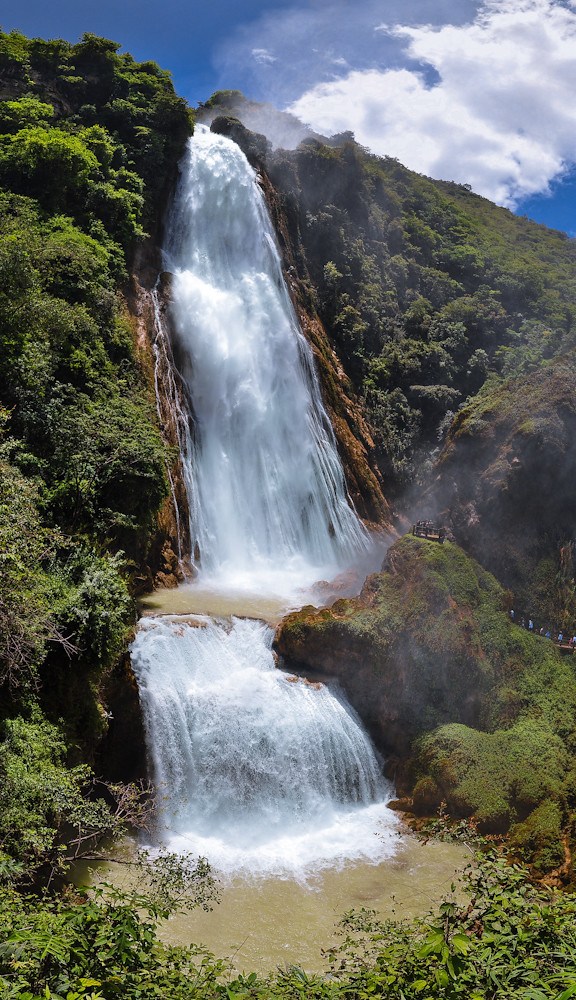
When you go to Chiapas, you cannot miss a trip to El Chiflón. It’s one of the most beautiful places I’ve been to in Mexico and unlike any other waterfall I’ve seen before. It’s about 2 and a half hours away from both San Cristóbal de las Casas and Tuxtla and 45 minutes from Comitán by car. The distance makes it a great option for a day trip from any of those bigger cities.
As you enter the park, you’ll see a small river below with a trail leading to the waterfalls. Moving along the trail, the waterfalls get bigger until you finally reach the most impressive one, Velo de Novia (the bride’s veil). At the end of the trail, there’s an amazing view of the waterfall and the mist rising from below. From that point, you can see the other trails around the falls, which are awesome to explore as well.
As you make your way back, you can actually zipline over the falls as a fun shortcut. I found it was an exciting way to see everything from above. It costs 200 pesos (about $10 USD) to zipline.
The entrance to El Chiflón is 50 pesos (about $2.50 USD).
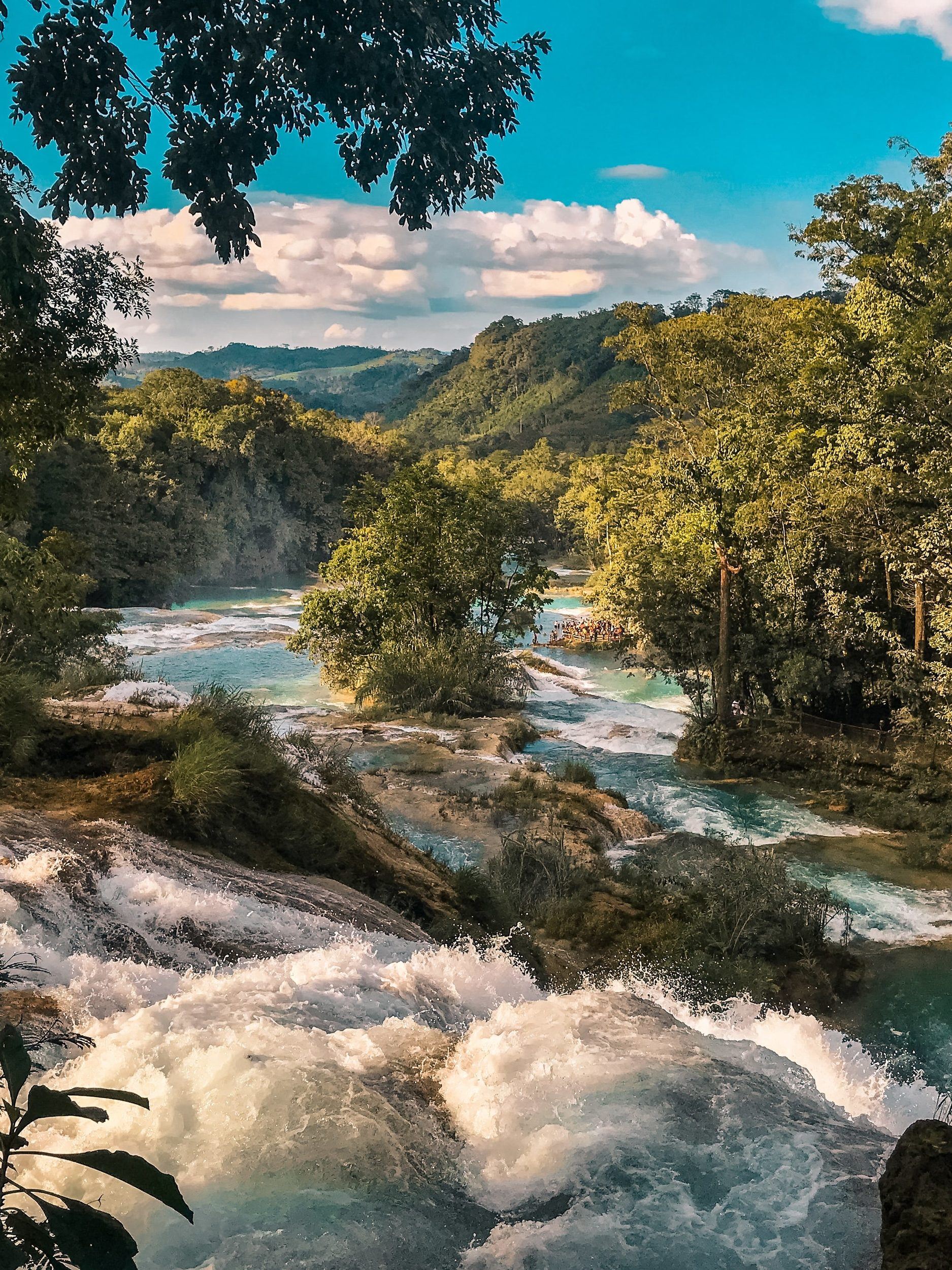
Since I arrived in Chiapas, everyone kept telling me I HAD to go to Agua Azul. After visiting, I understand the hype!
Agua Azul, gets its name from the intense turquoise pools both above and underneath the waterfall. It’s considered one of the best waterfalls in Chiapas because of its boisterous power and beauty.
However, I found Agua Azul to be crowded. There were so many food stalls, souvenir vendors, and large tour groups in such close proximity to the waterfall. It wasn’t a deal breaker for me, but it’s something to consider if you’re looking for a more low-key experience.
You can get to Agua Azul from San Cristóbal de las Casas, which is about 4 hours away. If you’re driving through Chiapas independently, it could be a great stop on your way to Palenque from San Cris or just as a quick day trip from Palenque. However, if you want to keep San Cris as your base, this tour picks you up from your hotel and will take you to both Agua Azul and Palenque in the same day.
Entrance to Agua Azul can be confusing. At the entrance to Salto de Agua ecopark (where Agua Azul is located), you have to pay a 10 pesos entrance fee. Then, you’ll have to pay again to actually access the falls, which will be another 20 pesos.
Cascadas Misol-Ha
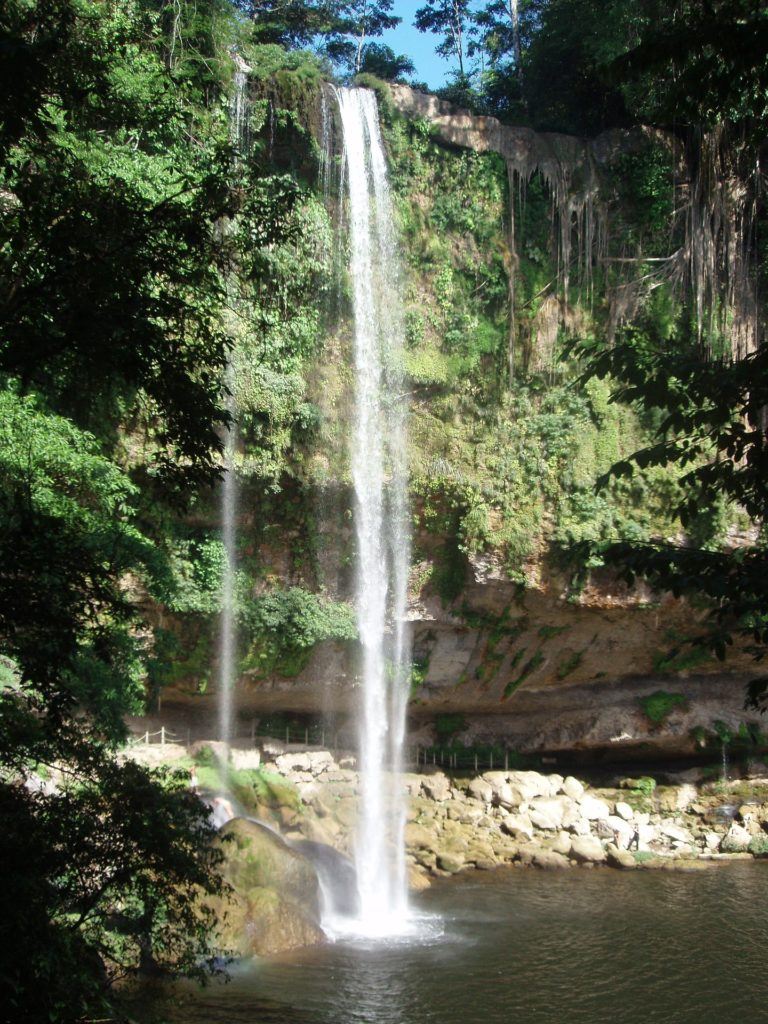
While the other waterfalls on this list are bright blue paradises, Misol-Ha has a totally different feel. Here you won’t find turquoise pools, but you will find a picturesque waterfall surrounded by bright green vegetation.
Misol-Ha is about 115 feet tall and towers above a pool that you can swim in. You can also follow a small trail that will take you right behind the mighty falls, which has a spectacular view.
This one is located close to Palenque. It’s about a 45-minute drive away and is often included on different tours going out from there. If you’re not into a tour, it’s easy to visit Misol-Ha from Palenque on your own.
This waterfall is another one where you have to pay twice to actually get to it. The first park entrance fee is 10 pesos, and then it’s another 10 pesos to access the falls.
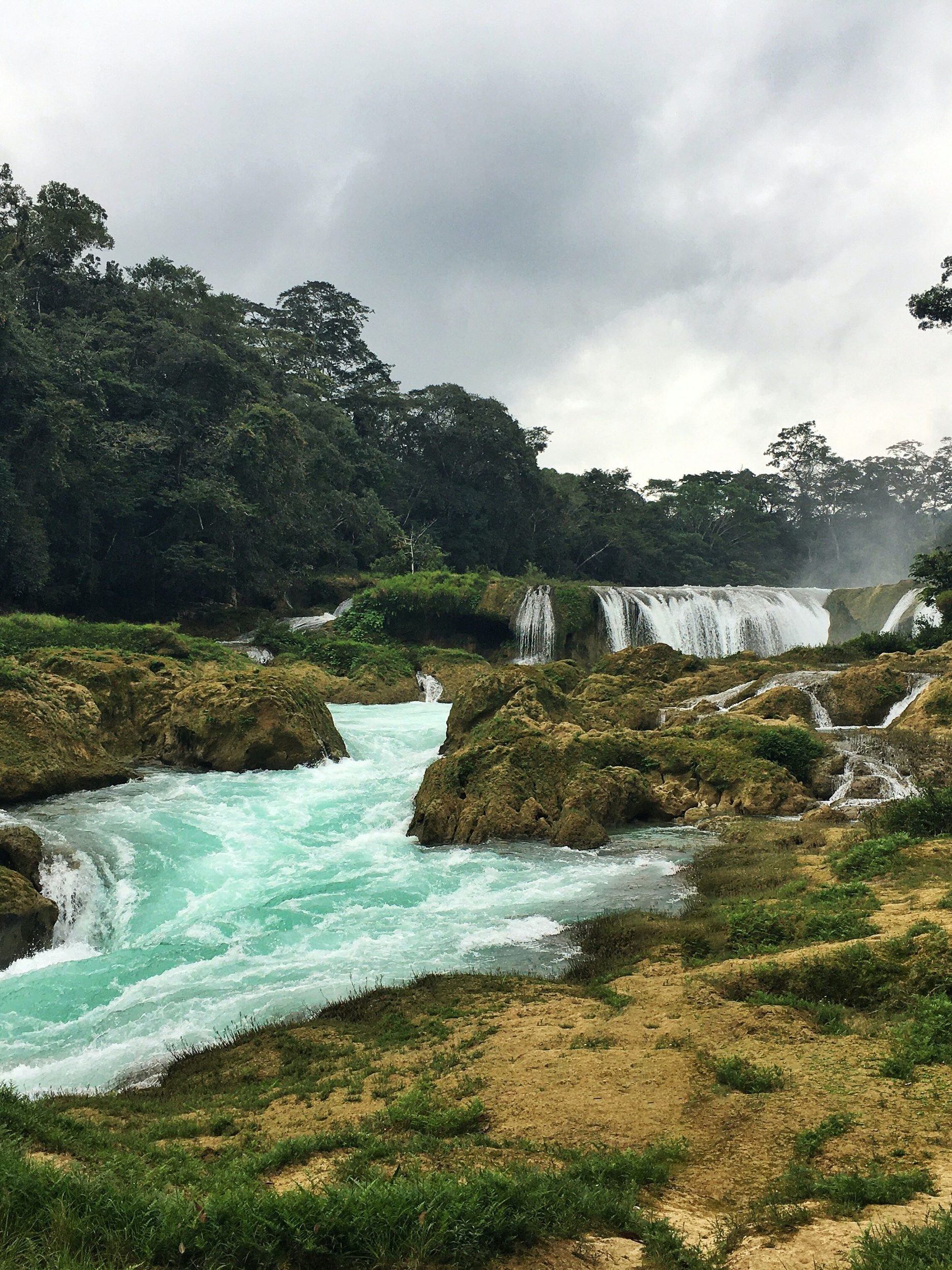
This stunning waterfall and waterway is much more remote than the others and is close to the Guatemalan border. It’s about a 5 hour drive from San Cristóbal de las Casas, but definitely worth the distance!
Las Nubes feels like you’re stepping into the garden of Eden. The lush greenery surrounding the brilliant blue waters with the round boulders above the cascades will take your breath away.
The best part of visiting Las Nubes is swimming in the blue pools above the falls. The water remains cool and refreshing year-round. It costs 30 pesos to enter the park. You can also rent a raft at the tourism center of the park for about $1,500 pesos (about $75 USD), which can fit up to 5 people.
Because of how far away Las Nubes is, I recommend spending a couple days exploring the area. You can easily camp around the park itself, or you can find other accommodation in Lagos de Montebello (see below). I camped nearby and enjoyed it, but another great option is this ecolodge which is right on the river.
Chiapas’ Best Archaeological Sites
Chiapas is located in southern Mexico, bordering Guatemala to the east. In fact, the general region of what is now known as Chiapas was part of Guatemala until 1824. This region of Mexico is known for being the most tied to its indigenous roots, which is evident in the local culture. You can often find local women wearing head-to-toe traditional clothing and there are many ceremonies and rituals that are still practiced here.
Chiapas is rich in indigenous culture and traditions that have been passed down for centuries. If you want a direct look into the past to better understand the roots of Mayan culture, take a trip to an archaeological site and dive head first into the beauty and mysticism of the ancient societies of Chiapas:
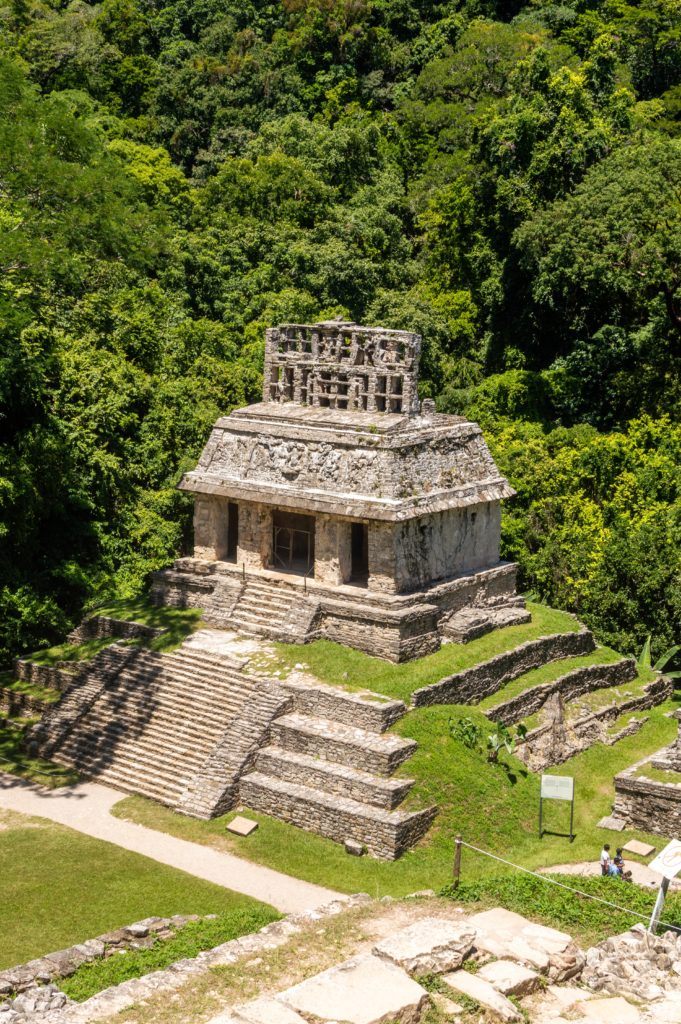
The first time I went to Palenque to explore the Mayan ruins there, I was speechless. I’ve been to my fair share of ruins and Palenque is by far my favorite.
The main temple on the grounds has a tomb inside, which used to house the deceased kings of the ancient city. You can go inside the dark, cavelike ruins and see where the kings used to lie. As you make your way through the ruins, I highly suggest hiring a guide. There are a lot of different symbols, sacred geometry, and even paintings which would be difficult to decipher without an expert present.
The city of Palenque has its own airport, which you can fly to from Mexico City. There isn’t a whole lot happening there, but it’s in the jungle and there are quite a few restaurants with traditional dishes to try. If you do go to Palenque, be prepared for humid weather and a lot of mosquitos!
Getting to the ruins from Palenque is as simple as driving there yourself or booking a tour once you get into town. These tours range from 300 to 1,000 pesos, depending on what is included. They are run out of local travel agencies, but you can also book one through GetYourGuide . The entrance fee for the ruins is 75 pesos, plus the 35 pesos fee to enter the surrounding national park where the ruins are.
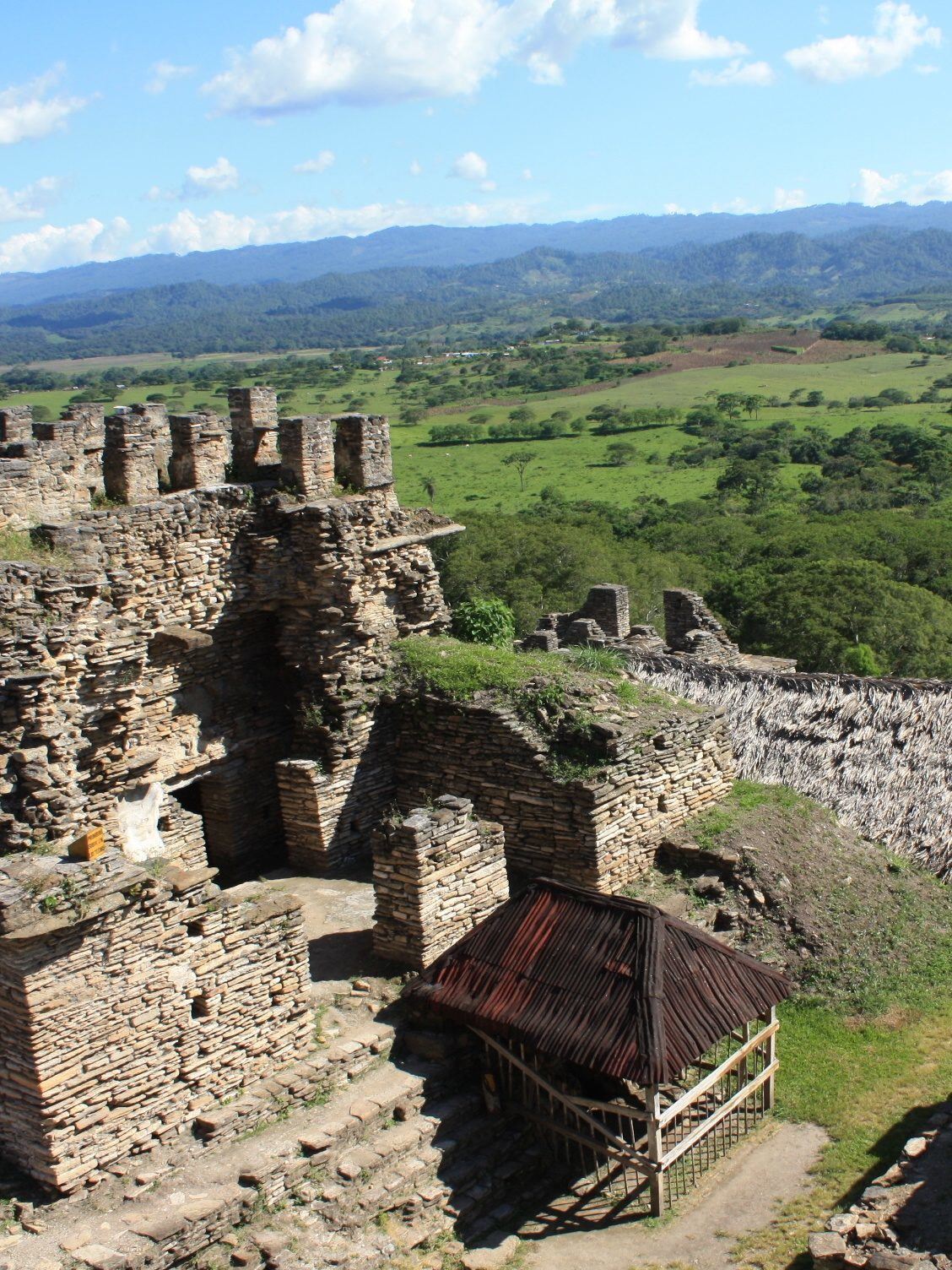
Meaning “House of Stone”, Toniná is the tallest archeological site in Mexico at 233 feet tall. If you’re ready for the climb of your life, you can trek up the stairs all the way to the top! I visited Toniná back in 2017 and was amazed at the view from the top of the main structure. With the gorgeous mountains in the background, it made the hike up totally worth it.
Toniná isn’t often crowded, and there’s a good chance you will have the site to yourself. It’s not a very well known archeological site yet, so it doesn’t have the same crowds you’d find at Palenque or other popular sites.
The entrance fee for Toniná is 46 pesos, which is cheaper than other big sites. Toniná is located just outside of the city of Ocosingo, which is about equidistant from San Cristóbal and Palenque, making it easily accessible from either of those cities. Tours to Toniná are often included in those which visit other archaeological sites, so it’s rare to find one that will just go there. One of those tours will cost around 500 pesos, which usually includes the park entrance fees.
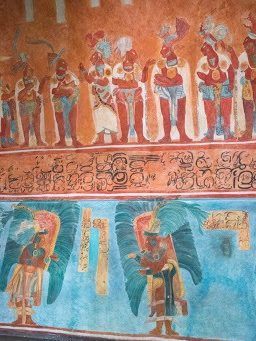
These ruins have the best preserved Mayan murals that have ever been found. When I saw them I couldn’t believe how old they were and it felt like I took a step back in time. The murals are the main focal point at Bonampak, and it’s worth hiring a guide to explain what they mean. There are some powerful images in the murals that give you an inside look at the ancient Mayan culture.
You can get to Bonampak from either San Cristóbal de las Casas, or more easily from Palenque. I recommend Palenque because it’s geographically closer and there are far more tours available. Taking a tour as opposed to tackling the ruins on your own won’t give you the same freedom of being on your own schedule, but it takes a lot of the pressure off.
If you decide to visit on your own, the park entrance fee to the park itself is 45 pesos, plus 25 pesos to enter the ruins themselves.
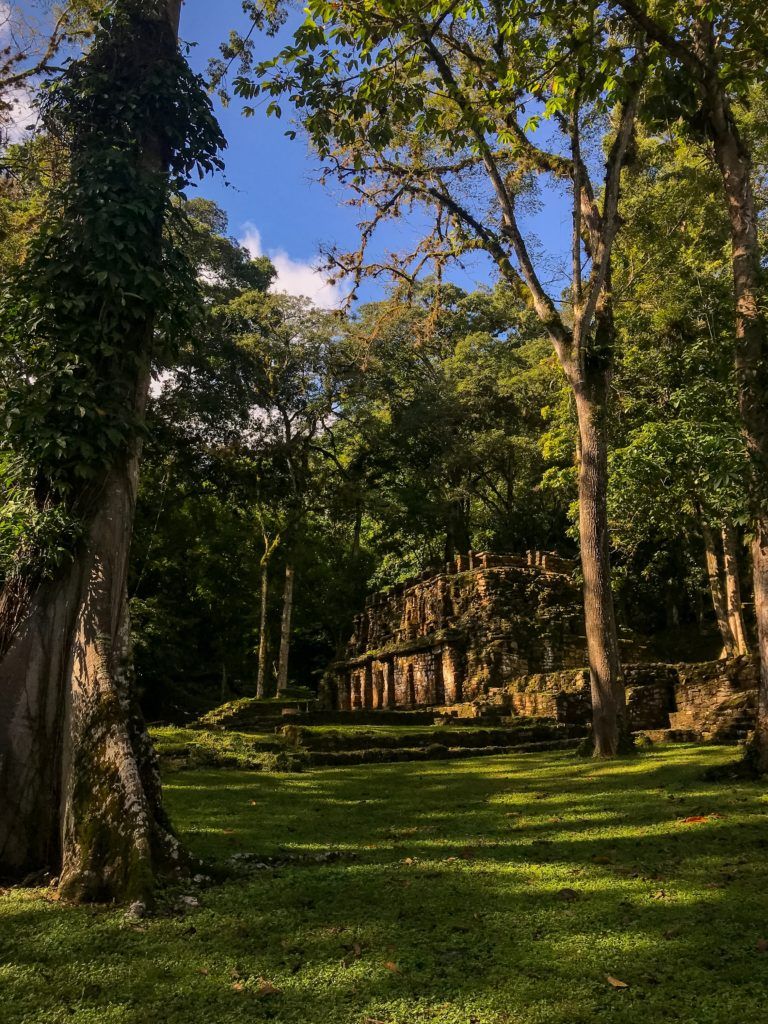
Located close to Bonampak, a trip to Yaxchilán will take you deeper into the jungle. The area around the ruins is one of the most sparsely populated places in all of Mexico, giving it some serious Indiana Jones vibes.
Yaxchilán is famous for the Maya hieroglyphs that are carved into the stones of the temples. These glyphs tell the story of the different dynasties of the ancient city. It’s fascinating to learn about these ancient civilizations and also interesting to ponder how much the world has changed since then!
Both Bonampak and Yaxchilán are off the beaten path and you won’t find the flocks of tourists like you will at many ruins in the Yucatan peninsula , for example. A tour that will take you to both of them from Palenque will cost around $40 USD, which doesn’t include a guide. Last time I went, I paid $10 USD at each place for a Spanish-speaking guide. If you don’t speak Spanish, you can ask for a guide who speaks English.
Getting to Yaxchilán is quite a journey and one you can take at your own risk. It involves crossing a river by boat, which can be expensive if you’re traveling alone. The entrance fee to the town itself is about 30 pesos, and there’s another fee to enter the ruins of about 30 pesos.
For ease, safety, and cost, I recommend doing a tour that will take you to both Yaxchilán and Bonampak which includes park fees and transportation.
Tenam Puente
Tenam Puente is just outside the small city of Comitan. The name literally translates to “defensive bridge” and was primarily used as a trading hub for nearly 1,000 years. You can climb the tallest temple there and get an awesome view of the scenery surrounding the site. There are also a few ball courts where the ancient Maya people used to play the sacred ball game.
One of my favorite things about visiting Tenam Puente was how empty it was when I went. Even though it was semana santa , or spring break, there were only a few groups of tourists in the entire site. It was at Tenam Puente that I felt much more connected to the spirit of the site and was able to sit with the peace and calm at this once-bustling city. If you can get a little bit of space, it’s cool to do a short meditation at the top of the temple.
The cost to enter the ruins is 45 pesos. If you’re curious about the Mayan ball game, consider hiring a guide who can take you through the courts and explain how it’s played.
Historic Towns
San cristóbal de las casas.
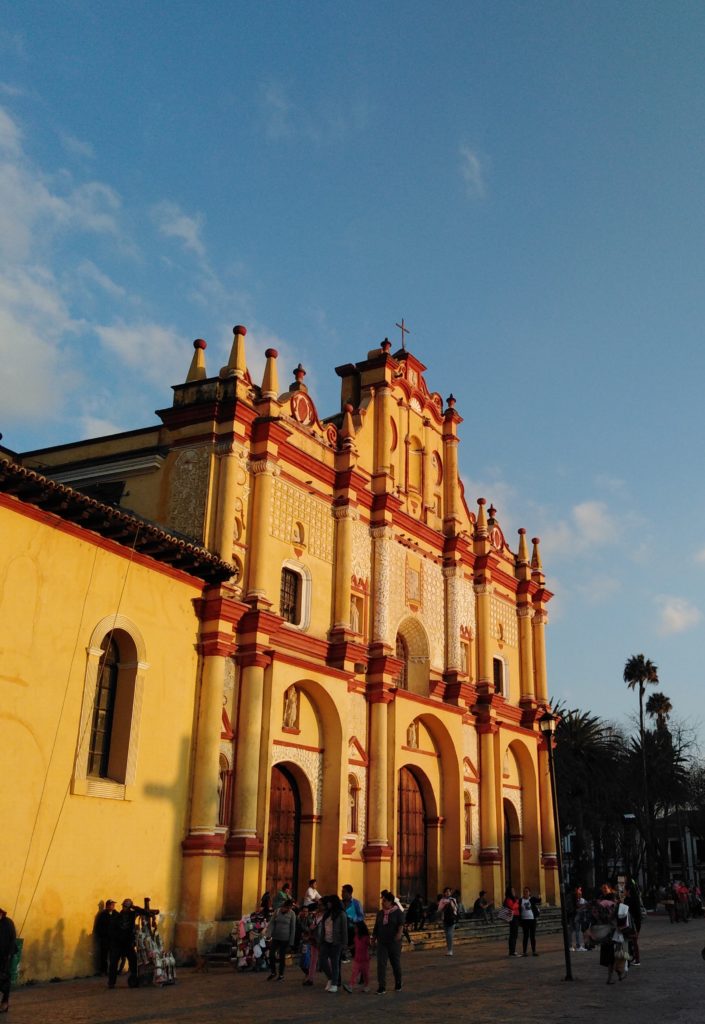
If you’ve read our post all about San Cristóbal de las Casas , you already know that San Cris has a very special place in my heart. It’s a charming colonial city high up in the mountains of Chiapas and a hub for artisans, yogis, and creative people of all kinds.
San Cris serves as a great base when visiting Chiapas because of how central it is. From here, you can easily take a day trip in any direction to visit ruins, waterfalls, and nature parks. Additionally, there is a wealth of history and culture here. With plenty of museums to visit and long pedestrian streets to stroll, you can spend a good amount of time here. I came here 4 years ago while traveling and I’ve just come back to stay – it has a magnetic quality!
San Cris is about an hour’s drive from the capital city Tuxtla Gutierrez, where the nearest airport is. If you’re renting a car to travel through Chiapas, I recommend doing so in Tuxtla as there is (literally) only one place in all of San Cris to rent a car. If you come during high season (around spring break and December), there is a chance that the rental company will be out of cars to rent.
San Juan Chamula
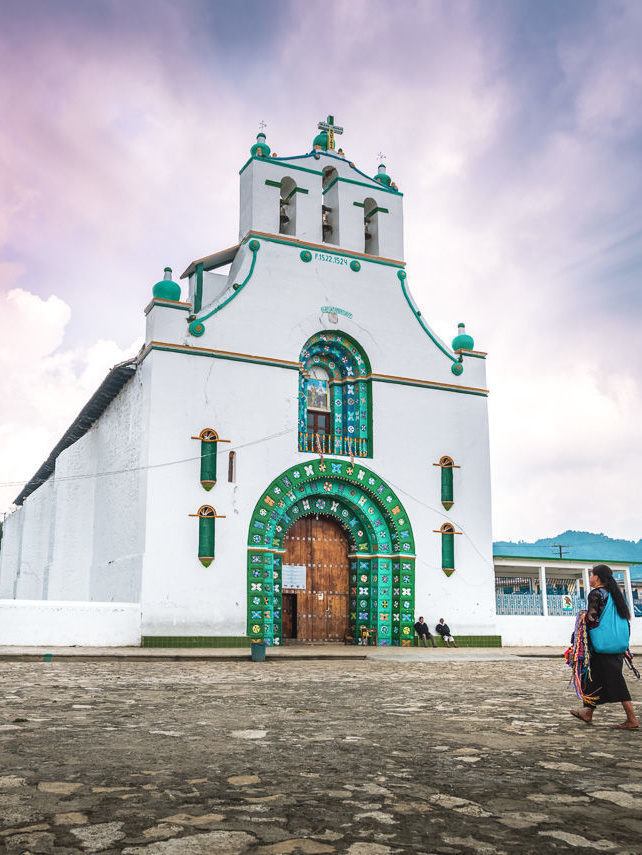
You’ll see signs all over the place about tours to visit San Juan Chamula as soon as you get to San Cris. This charming and mystical small town is only about a 20-minute drive from downtown San Cris and can be easily visited via taxi.
San Juan Chamula is known throughout the region as THE place to go to experience the heart of indigenous culture in Chiapas. The main attraction is an old church where priests, shamans, and local observers go to practice their sacred religious rituals. One of these rituals involves drinking Coca Cola and burping as a way of ridding the body of bad spirits. Yes, burping!
The cemeteries sprinkled throughout the town are a unique feature of Chamula. The grave sites at these cemeteries seem to pop up out of nowhere. In fact, it’s common practice in many indigenous communities here to bury loved ones in their own backyard. As buildings change hands or are knocked down, the graves remain.
It is important when visiting Chamula to be respectful of the local culture and customs. There is a very heavily-enforced rule at the church in Chamula that no phones or photography is permitted. There are signs outside that advertise this rule, and it applies to other sacred places there, too.
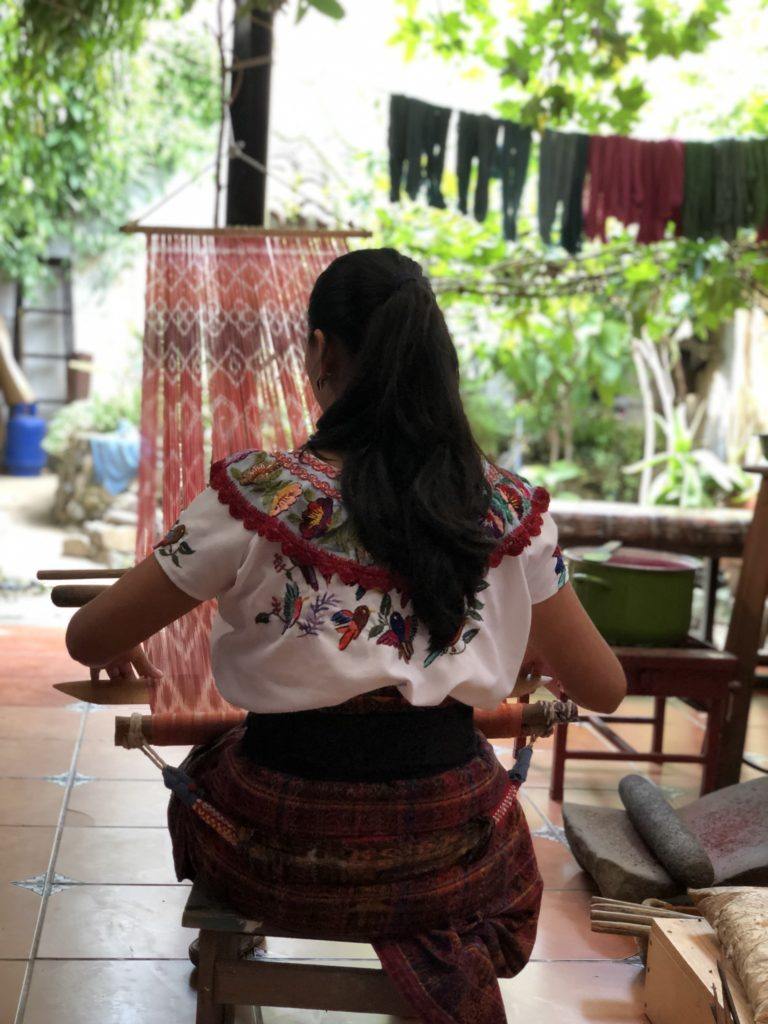
The first time I visited Zinacantán, I fell in love. This small town is best known for its handwoven textiles and traditional clothing. You’ll see women weaving fabrics by hand on a traditional waist loom. It’s fascinating to watch them carefully move the threads in and out of one another. It made me appreciate the meticulous care put into the garments. Read more about our favorite ways to support women when we travel here .
Most people in Zinacantán live off the textiles and clothing sold there, making it a great place to purchase souvenirs. That way, you can directly support the hard work of the artisans. The vibe of this town is much more laid back than San Juan Chamula, which made it easier to strike up a conversation with the locals.
There is a beautiful church in the center of Zinacantán that is definitely worth taking a peek at. During Catholic holidays, the church is filled with flowers which fills the space with a delightful floral aroma. There is no explicit “no pictures” policy at this church. However, it’s best to avoid taking pictures of people in their place of worship, no matter where you go. Stick to taking pictures of the architecture, the art, and the altars, but avoid snapping pictures of locals in the church.
You can easily go to both San Juan Chamula and Zinacantán in the same day on your own or with a tour. This one will bring you to both and even includes a traditional drink!
Chiapa de Corzo
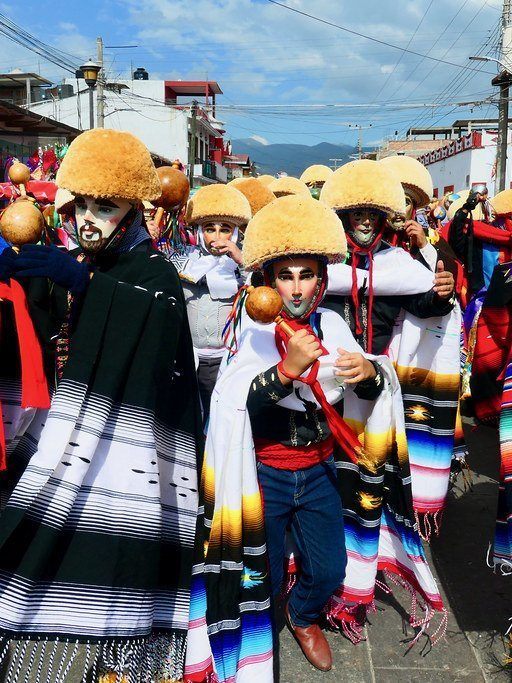
Do not, I repeat, do NOT go to Chiapas without going to Chiapa de Corzo! I might be partial to this magical town because of its delicious food, but there’s something for everyone there. If you want to get a taste of Mayan culture, this is the place.
Chiapa de Corzo is famous for its large festive celebrations including Dia de Los Muertos at the end of October as well as Christmas and Easter. Hang out in the main plaza and catch a glimpse of the dancers called parachicos moving together in synchronicity while wearing wooden masks and traditional wigs.
Beyond the cultural richness of the town, Chiapa de Corzo is located right next to Cañon del Sumidero. This canyon can be explored by boat while floating down the Sumidero river. There you might catch a glimpse of the crocodiles, monkeys, and birds that inhabit the area while you gaze up at the towering walls of rock. This tour includes both Chiapa de Corzo and Cañon del Sumidero and operates out of San Cristóbal, which is just a 45-minute drive away.
Comitán de Domínguez
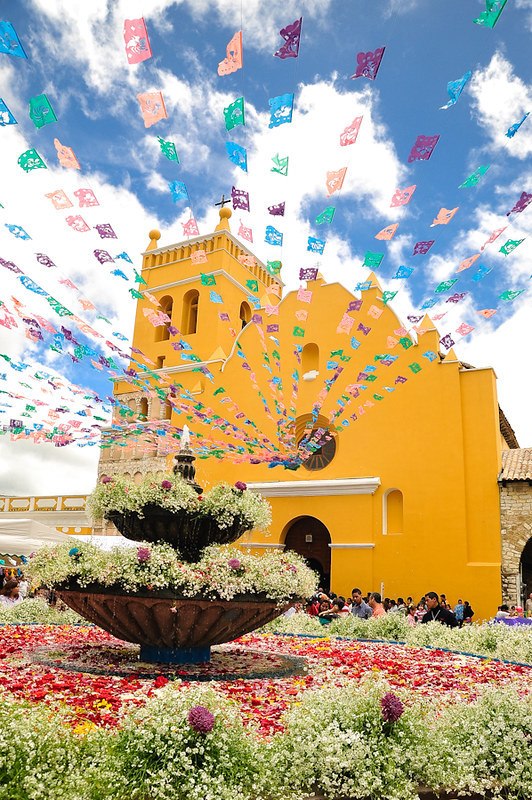
Comitán is the best base for exploring the wonders of southern Chiapas, as it is closer to many of the waterfalls mentioned above. This quaint town is known for its famous Christmas celebrations every year. The best part of visiting Comitán is how down-to-earth and non-touristy it is. Walking through the streets, you’ll likely see very few foreigners and not a whole lot of English happening in general, so be prepared if you don’t speak Spanish!
There also always seems to be music playing. The most common music to hear in the plaza is Marimba, which tends to illicit large crowds of dancing people. Join in if you can!
While you’re there, don’t miss the Rosario Castellanos Cultural Center, which hosts different art, music, and language workshops for the local community. It also has a theater, cafe, and bookstore inside and is right behind the Museo Arqueológico de Comitán. This museum is free and has some pretty neat artifacts from nearby ruins.
Coffee Farms
You don’t have to be a coffee connoisseur to know a great cup of coffee when you taste one. I’ve been ruined for life now because after tasting the coffee here in Chiapas, there is no going back. Whether you’re an expert on all things coffee or merely an enthusiast (like me!), here are a couple places where you can try some delicious brews and see where it all comes from:
This coffee farm is by far the most famous on the Ruta del Café here in Chiapas. It can be found about an hour north of Tapachula in southern Chiapas and has its own hotel and resort attached. The hotel is a bit of a splurge to stay at, but you can easily take a day trip there from Tapachula and just tour the farm. There is nothing quite like sipping the freshest coffee you’ve ever tasted with the backdrop of rolling green hills.
Finca Hamburgo

This coffee plantation is one of the oldest in Chiapas and was founded by a German family. The hotel on the grounds has some amazing views of the coffee plants and mountains, which are covered in green vegetation.
They also have tours of the facilities where you can learn about the coffee making process, the machinery, and the different varieties of plants on the farm. At the end of the tour, you’ll get to try some of the freshest brews directly from the farm itself. Sounds like a dream!
Finca Hamburgo is a bit more remote than Argovia at about two hours north of Tapachula in the heart of the coffee region. Both of these places would make an excellent day trip from Tapachula, but could also be made into a longer trip if you fancy staying for a while at one of the hotels.
A Beach Destination Unlike Any Other
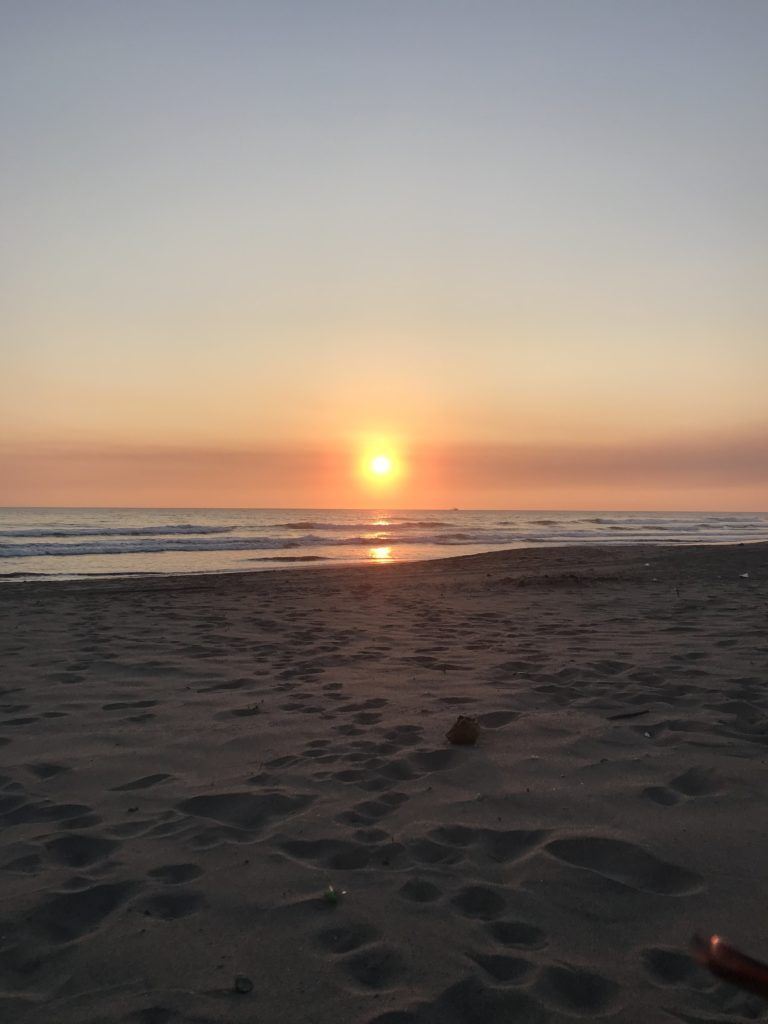
If you’re into the kind of destination that does NOT include big resorts and crowded beaches, the coast of Chiapas is for you. Boca del Cielo and Puerto Arista are the closest beaches to San Cristóbal de las Casas–about 4 hours away by car.
To get to the beach from San Cris, you will take the long and winding highway 190D for about 3 hours to reach Tonalá. This small city is the last place where you can find a grocery store and the best pit stop to stock up on snacks and drinks if you want to bring anything with you to the beach.
From there, you can drive (or take a taxi) to Puerto Arista where you’ll have to cross a lagoon by boat to get to the long strip of beach where you’ll find a few hotels spread out along the coast.
My favorite place to stay there is Entremares which has A-frame cabins and a geodesic dome. The rest of the buildings are built from earth and sand, which contributes to the overall eco-friendly vibe of the place.
The biggest draw of Puerto Arista and Boca del Cielo is the neat contrast of the lagoon with the mountains in the background and the grey beach on the other side of the isthmus. In this area you can take a dip in the lagoon and then walk for 5 minutes to then jump into the ocean. The best of both worlds!
Because of how remote this beach is, I recommend booking your accommodation ahead of time and clarifying with your host on how to get there. Boats that cross the lagoon are relatively cheap during the day (around $3 per person, per trip) but can increase at night.
Bonus: Lagos de Montebello
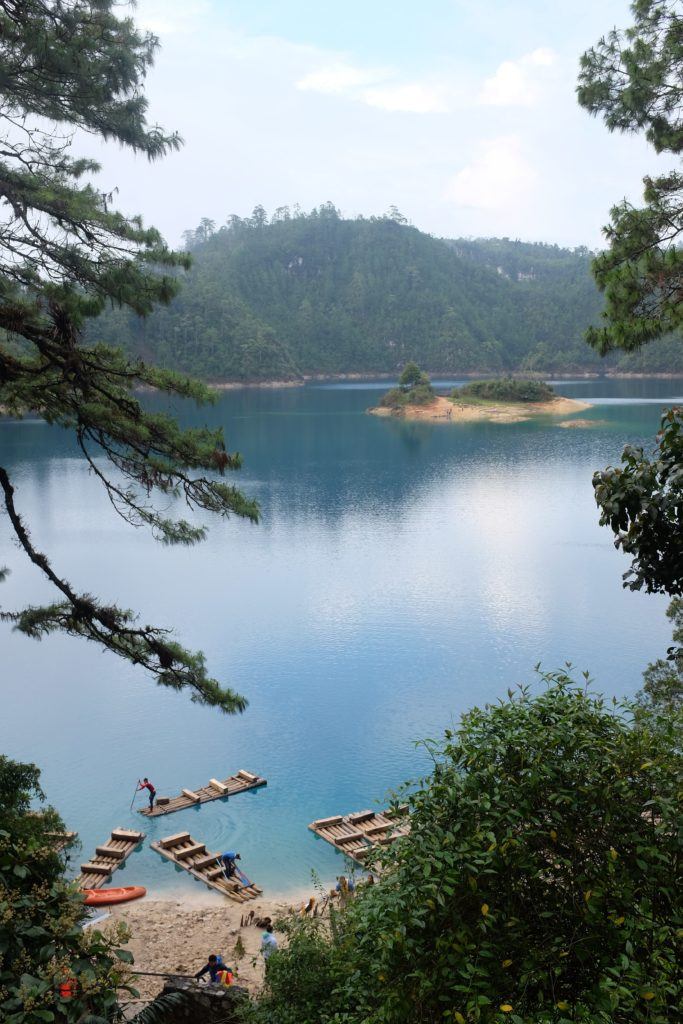
Imagine pulling up to a misty lake surrounded by pine-filled mountains after sleeping in the car for several hours only to realize you’ve stumbled upon paradise. That’s exactly what happened to me when I went to Lagos de Montebello while on a packed full-day tour.
This dreamy lake has a few small islands on it and is part of a chain of lakes along the Guatemalan border. Because of the altitude it gets quite chilly, especially during the winter months. I went in December when it was freezing cold outside! When the air is cold, the temperature of the water in the lake remains a few degrees warmer, creating steam above the lake.
The main activity at Montebello is floating around on a wooden boat, which are the same ones the Maya people used to cross the lake. From there, you’ll take a couple stops at different islands on the lake and you can even go for a swim!
Before You Go

Since Chiapas is still relatively off the beaten path, there are a few things to keep in mind before traveling there.
- Road Blockades: It’s commonplace to be driving on the highway in Chiapas and see that a road has been blocked by demonstrators. If you’re taking a road trip, be prepared to take an alternate route if you find yourself in a long traffic jam due to a blockade.
- Children Selling Souvenirs: You can expect to see many children selling trinkets, bracelets and other souvenirs in Chiapas. While some people feel called to purchase from those children, I don’t recommend it. Check out this article or do your own research before deciding for yourself.
- Photography: As I said above, please be mindful when taking photos in Chiapas. Many travelers feel inclined to take photos of or with local children without the parent’s consent. Here’s an article to provide some perspective.
- Language: While other places in Mexico may cater more to an English-speaking crowd, there are many places in Chiapas where it may be difficult to find an English speaker. Knowing a few key phrases goes a long way here, so no need to become absolutely fluent. Try downloading the offline Spanish-English and English-Spanish dictionary on the Google Translate app in case you need a translation in a pinch.
- Leave No Trace: The principle values of Leave No Trace are not limited to national parks in the USA. Organizations are working hard to keep the natural beauty of Chiapas free of pollution. Consider this while traveling and try to avoid single-use plastic whenever possible!
- Supporting Local Communities: Chiapas has plenty of opportunities to buy directly from artisans. That being said, there are plenty of big stores selling cheap dupes of local handicrafts. If you want to read more about supporting local women and artisans, check out our post about it.
Wondering how to fit all these sites into one trip? Here’s a map of each of the places mentioned so you can start planning:
Chiapas feels like it carries the heart and soul of what Mexico once was. Going out to these remote places to take in the natural beauty of the landscape brought me a lot of solace during a time when everything else felt like it was being turned upside down. Chiapas is often overlooked as travelers tend to favor the Caribbean and Pacific coasts, but that is what has allowed it to maintain its originality. Next time you get the itch to visit Mexico, consider coming to bask in the beauty of Chiapas.
About the author: Emily is a Mexico travel enthusiast based in San Cristóbal de las Casas, Chiapas. She is a part-time freelance writer for BMTM and part-time doula.
About Emily Becker
Emily Becker is a digital nomad based in Costa Rica. She's been traveling on and off since 2014 and has visited 15 countries—planning to tick many more off her bucket list. In addition to writing for BMTM, she works as a copywriter and project manager.
Leave a Reply Cancel reply
Your email address will not be published. Required fields are marked *
Save my name, email, and website in this browser for the next time I comment.
subscribe to our newsletter
This site uses Akismet to reduce spam. Learn how your comment data is processed .
03/08/2022 at 7:05 pm
Thanks for this detailed! I am planning to visit San Cristobal in November 2022 with my family. We want to visit Palenque as a day trip with a tour company. Do you feel this is safe to travel on highway 199? I have read some things that are giving me pause, and would love to hear from someone with more experience in the area.
03/10/2022 at 8:07 am
Hi Lily! How exciting that you’re planning to come to San Cristóbal. Visiting Palenque as a day trip from San Cris isn’t possible as the drive is about 6 hours (on a good day with no road blocks), so consider going for a few days at least. One day for travel each way, plus a full day to see the ruins, though I think two days with a guide is the best way to go if you have time.
Traveling on the highways here can be a bit of a wildcard. Right now I believe highway 199 might be a no-go because of some conflicts in one of the towns that it runs through. There are other routes that are safer, but they will take more time. If you want to get more info leading up to your trip, check out the San Cristobal Expats Community Facebook group, as people regularly update the page with their experiences traveling through the region.
I hope this is helpful and will give you some peace of mind about coming to Chiapas. I have lived here for about a year and a half and think it’s one of the most magical places in Mexico. Have a wonderful trip!

24 Best Things to Do in Chiapas Mexico: 2024 Local’s Guide
There are plenty of things to do in Chiapas, Mexico to warrant spending at least a week here. However, Mexico’s southernmost state is often overlooked from most people’s Mexico itineraries.
Word about Chiapas has only started getting out in recent years and most people that take the time to venture here only do so to experience the majestic ruins of Palenque or the colonial architecture of San Cristobal de Las Casas. For the most part, Chiapas remains largely untapped.
That isnt necessarily a bad thing though, as Chiapas, steeped in Mayan history, indigenous cultures, and gorgeous nature, offers a more authentic Mexico travel experience than you could ever obtain in places like Cancun or Tulum.
This guide to the best things to do in Chiapas has been written by a British Travel Writer based in the Yucatan. (Me!) I have explored Chiapas extensively over several visits to the state and have used my knowledge to create the most comprehensive Chiapas travel information you can find anywhere online.
Rest assured, you are in good hands here 😉

Table of Contents
24 Best Things to Do in Chiapas Mexico
Chiapas is a unique destination, quite unlike anywhere else in Mexico. After you have spent a while in Mexico, you will start to note that each of the country’s 32 states is like a little independent nation in itself, each with its own distinctive cultures, regional cuisine, etc.
Chiapas sits in the south of Mexico. It shares its borders with Guatemala to the south, the Mexican states of Oaxaca and Veracruz to its west, and Tabasco to the north. Chiapas is perhaps best known for its indigenous populations which help give the region a distinctly different culture than what you will find elsewhere.
There are 68 different indigenous groups in Mexico, that speak more than 350 different languages and dialects. More than 25% of Chiapas´ four-million-strong population belongs to an indigenous group, and there are 12 different ethnic groups that live in the state. (With the Tzotzil and Tzeltal Mayan being the largest and perhaps best known).
Chiapas is one of the poorest states in Mexico, but you shouldn’t let that concern you. Chiapas is safe for the most part , and the people here are among the friendliest in Mexico, eager to show travelers the beauty of their homeland.

Visit the Pueblo Magico of Chiapa de Corzo
The charming little town of Chiapa de Corzo is one of four Pueblo Magicos in the state of Chiapas. Pueblo Magicos are Mexican towns and settlements that have been recognized for their unique beauty, charm, culture, and gastronomy. Generally speaking, when you see that somewhere has been designated as a Pueblo Magico, you know that it is a worthwhile place to visit. Most people overlook Chiapa de Corzo when they are traveling through Chiapas, or they only stop by briefly as part of a day trip to the Sumidero Canyon.
However, the little town is well deserved of a day or two´s exploration in itself. This is one of the oldest towns in the Americas.
It dates back to 1528 and was one of the first places that the Spanish colonizers settled when they arrived in Chiapas. They later realized that the intense desert heat was too much for them and moved their main settlement to San Cristobal. However, they left many beautiful churches and structures in their wake.
Start your day in the Zocalo – the charming central square of Chiapa de Corzo surrounded by porticoed buildings and quaint cafes. The piece de resistance of the square is ¨La Pila¨ – a diamond-shaped fountain in its center.
An exploration of the unsuspecting side streets leads you to magnificent, centuries-old churches and thought-provoking street art. Stop for breakfast at Jardines de Chiapa Restaurant (Francisco I. Madero 395, San Jacinto, 29160) and stroll along the riverfront.
The hilltop ruins of the Templo de San Sebastian are not to be missed. From up here, you can enjoy spectacular panoramas of the town and wider Chiapas below.

Best Chiapa de Corzo tours
If you are traveling to Mexico in January , your time in Chiapa de Corzo will be particularly special. Every year, the Fiesta Grande is hosted here in honor of three Catholic saints.
The festival is famous for its Parachico dancers that wear traditional clothing and painted wooden masks as they dance their way through the town. This dance is so culturally important that it has even been recognized by UNESCO as an Intangible Cultural Heritage of Humanity.
Throughout the year, you may enjoy exploring Chiapa de Corzo with the aid of a guide who can give you more in-depth information about the town and its various districts. Several reputable Chiapa de Corzo tours are detailed below for your information.
- Chiapa de Corzo & Sumidero Canyon day tour from Tuxtla Gutierrez
- Sumidero Canyon, Chiapa de Corzo and San Cristobal tour
- Sumidero Canyon & Chiapa de Corzo tour from San Cristobal

Spend a long weekend in San Cristobal de Las Casas
San Cristobal de Las Casas is the main raison d’etre that most people decide to visit Chiapas. The town was founded in 1528 and named ¨Villa Real de Chiapa¨ Its name has changed various times over the centuries before being given its current name in 1848.
Spending three to four days here allows you enough time to explore the town itself, but you may want to base yourself here for as long as a week. San Cristobal is a convenient base for taking day trips out to other parts of Chiapas.
The free walking tour is a good way to get your bearings in the city. It departs at 10 am daily from the wooden cross in front of the cathedral in the Plaza de la Paz.
There are many gorgeous catholic churches scattered throughout San Cristobal which will take your breath away, even if you are not remotely religious. A fun way to explore the town is to mark different churches on your map and enjoy exploring the offbeat neighborhoods that they lead you through.
The beautiful white and yellow Iglesia del Cerro de Guadalupe is a charming 19th-century church perched on top of a hill. If you ascend the 79 steps to the church at the top, you will be rewarded with spectacular panoramas over the town.
Equally worthy of your attention is the Iglesia de San Cristobalito. The views from up here are unparalleled. However, conquering the hundreds of steps to the top is no mean feat.

Learn about the religious practices at San Juan Chamula Church
The San Juan Chamula Church is one of the most unique churches in the world. From the outside, it looks no different from any other Mexican catholic church.
Its crisp white facade is decorated with green fixtures and detailing, and colorful, intricate azulejo tiles. It is when you step inside the church that things get interesting.
Chiapas locals visit the San Juan Chamula church when they or their loved ones become sick. They light candles and pray to a saint of their choosing in the hope that their loved ones become better.
Generally, the more candles a person uses, the sicker they are. A lot of people here cannot afford access to modern medicine or they are suspicious of it. So, they turn to religion instead.
A blend of Catholic and indigenous practices is used during rituals here. Many indigenous people believe that they get sick as a result of people looking at them with envy or sending negative energy their way.
So, they sit and drink bottles upon bottles of fizzy drinks such as Coca-Cola as they pray and force themselves to burp as they believe that burping expels evil. Sometimes chickens are sacrificed in exchange for the person becoming better.
Best Chamula tours to take in 2023
You can take a Colectivo (shared minivan) from San Cristobal to Chamula. However, for the best experience, you should visit with a tour guide.
A number of reputable Chamula tours are detailed below for your consideration. It is advisable to reserve your spot online in advance as places do sell out! Most combine a trip to Chamula with a visit to nearby Zinacantan.
- Chamula & Zinacantan day trip from San Cristobal
- Indigenous villages of Chiapas day trip

Experience indigenous cultures in Zinacantan
Zinacantan is one of the best places to visit in Chiapas, particularly if you are interested in learning about indigenous cultures. The little town is home to around 45,000 inhabitants, many of whom are Tzotzil.
The town’s original name was ¨Tzinacantlān¨ which is of Nahuatl origin and means “land of bats”. However, it was modified to Zinacantan as the Spanish colonizers could not pronounce its original name.
Today, Zinacantan is home to several beautiful churches that use a blend of Catholic and indigenous practices in their worship. Stop by the Iglesia de San Lorenzo and the Capilla El Señor de Esquipulas.
This region is famous for growing flowers. Whenever you step inside any of the churches of Zinacantan, you will be met with the fragrant aroma of hundreds of colorful flowers and garlands that decorate every wall and ceiling.
Many stunning, vibrant textiles are also produced here. You may be interested in stopping by the indigenous women’s textile cooperative on the outskirts of town.
More than 60 women work together to create unique garments and the existence of this cooperative has helped to massively improve the lives of the residents of the village. They donate a portion of their earnings to fund the education of the younger generations.

Recommended Zinacantan tours

Take a boat tour of the magnificent Sumidero Canyon
Chiapas is home to some of the most diverse and beautiful natural scenery in Mexico. The Sumidero Canyon, set inside the national park of the same name, is a dramatic gorge that was formed more than 35 million years ago.
Start by taking a boat tour along the Río Grijalva where you will pass through areas surrounded by towering 1km high cliffs. It takes approximately 2 hours to sail along the 64km length of the river.
Many endangered species call the canyon home, along with crocodiles, spider monkeys, and many exotic, colorful birds. If you are lucky, you will see them as you sail around the canyon. There are also numerous hiking trails that weave around the scenery here and offer spectacular panoramas over the canyon, with Chiapa de Corzo and Tuxtla Gutierrez shimmering in the distance.
Recommended Sumidero Canyon Tours
It is very difficult to tour Sumidero Canyon independently. One of the best things to do in Chiapas is to take a Sumidero Canyon tour that starts in Chiapa de Corzo, Tuxtla Gutierrez, or San Cristobal.
Many tours include pick-up and drop-off from/to your hotel. This takes a lot of stress out of managing the logistics of how to get from A to B.
A number of reputable Sumidero Canyon tours are detailed below for your consideration. Book online in advance to secure your place.
- Sumidero Canyon full day trip from San Cristobal de las Casas
- Sumidero Canyon and San Cristobal de las Casas day trip from Tuxtla Gutierrez
- Tour of Sumidero Canyon, Chiapa de Corzo and San Cristobal de las Casas
- Sumidero Canyon and Chiapa de Corzo day trip from San Cristobal de las Casas

Visit a coffee plantation
An interesting fact about Mexico that you may not be aware of is that the country is the world’s largest producer of organic coffee. In general, Mexico is one of the largest coffee producers in the world.
Chiapas, along with Veracruz and Oaxaca, is one of the country’s largest coffee-growing regions. Mexican Chiapas coffee tends to have a strong, distinct taste and while it may be relatively unknown internationally, you will note that many cafes and restaurants across Mexico stock and serve it.
If you are a major coffee aficionado, one of the best things to do in Chiapas is to visit one of the coffee plantations in the area. Many plantations offer tours and tastings.
They often also have tourist accommodations on site where you can stay in gorgeous rural cabins in the mountains overlooking the plantations. Most Chiapas plantations are concentrated around Ocosingo and near the Sierra Madre mountains in the southern part of the state.
The Hamburgo plantation is a good choice, although it is tricky to reach unless you are renting a car in Mexico. It is located high in the Sierra Madre mountains, close to the town of Huixtla.
The plantation was founded in 1888 by German Arthur Edelman. It has been passed down through his family for more than 100 years and is currently managed by the fifth generation. There is also a spa and restaurant on-site.
Marvel at the spectacular Arco del Tiempo
The Arco del Tiempo del Río La Venta ” (Arch of Time of La Venta River )is a spectacular natural stone arch 180 meters high that is one of the tallest arches in the world. The arch is currently on the ¨tentative¨ list for UNESCO, to potentially be added as a natural wonder of the world. The breathtaking natural archway sits in the lush, dense jungles of the Reserva de la Biosfera Selva El Ocote in Northern Chiapas. It is about as off the beaten path as you can get in Chiapas, with less than a handful of tourists visiting the area each month.
The archway wasn’t even designated as a tourist destination at all until 2010, when a group of Italian travelers that had stumbled across the Arco del Tiempo and fell in love with the surrounding biosphere reserve, convinced the locals to build huts to promote ecotourism. The archway is more than 80 million years old and was formed by limestone dissolution and erosion by rain and wind. Petroglyphs (ancient wall carvings) created by the indigenous Zoque communities that lived here approximately 5,000 years ago can be found along the arch.
Getting to the Arco del Tiempo is no easy feat – doing so requires a 4-hour trek through the jungle with the help of a local guide. Rappelling, swimming, and kayaking are among the activities that you can enjoy when you arrive. Rather than heading back the same day, you can choose to camp in the grounds of the archway or in the jungle just above it.
Swim in the crystalline waters of Cenote de Chukumaltik
Most travelers to Mexico have never heard of Chukumaltik cenote and their trips often center around the ¨Instagram famous¨ cenotes in the Yucatan, such as Cenote Suytan and Cenote Ik Kil. But ask any Chiapas resident where the most beautiful place to go swimming is and chances are they will all give you the same answer: Cenote de Chukumaltik.
Cenote de Chukumaltik translates to mean ¨hidden beauty¨. This is a fitting title as this natural sinkhole awaits in the middle of nowhere, escaping the eyes and attention of most tourists.
The open cenote has a diameter of approximately 200 meters and a depth of 70 meters. You could easily spend a day swimming and snorkeling in its refreshing crystalline waters which are backed by the luscious green jungles of Chiapas. Chukumaltik awaits approximately 36 minutes (27km) south of the city of Comitan de Dominguez, not too far from the Mexico-Guatemala border. Not only is the cenote beautiful in itself, but even more treasures await beneath the surface of its warm waters – including a petrified forest, sulfur chimneys, and a submerged statue of the Virgen de los Dolores with her hands together in prayer. If you do not have access to a vehicle, the best way to get to Chukumaltik is to organize a taxi ride from Comitan. You can take the bus headed to Cascadas de Chiflón and get off at Chucumaltik junction but it is quite a ways from the cenote and you will have to wait by the side of the road for a while (which can be almost unbearable when it’s hot) and hitchhike or wait for a ride.
Explore the Toniná Ruins
The Toniná Ruins (meaning ¨House of Stone¨ in Tzeltel Maya is a pre-Colombian city that was built by the Ancient Mayans in the Mexican state of Chiapas. Although small, it is filled with impressive and well-preserved temples and pyramids and is believed to have been a rival city of Palenque.
Archeologists believe that Toniná originally went by the name of ¨Po¨. The Acropolis here is one of the tallest Mayan structures in Latin America and at a height of 241 feet, it is significantly higher than the famous ¨El Torre¨ at the ruins of Ek Balam , and the Ixmoja pyramid at the Coba Mayan ruins in the Yucatan.
Tonina/Po thrived during the Classic Period (400-900 CE). Notable structures to look out for here include the Pok-ta-Pok ball court at the Great Plaza, which contains ornately carved structures of Mayan lords that were captured by the city leaders, the Altar of Sacrifices, various tombs, and an ¨Altar of the Underworld¨.
The ¨Altar of the Underworld¨ contains a labyrinth that is extremely rare to find in Mayan cities. (There is one more at Oxkintok in the southern part of the Yucatan state ).
The entrance fee for visiting the Toniná Ruins is 70 MXN pesos and the site entrance includes admission to the Toniná museum which contains artifacts and statues recovered from the city and helps you to put the things you see here in more context.

Spend an afternoon in Tuxtla Gutiérrez
Tuxtla Gutiérrez is the bustling capital city of Chiapas and while it is no great beauty, it is worth stopping by here briefly on your way to/from Chiapas’ Ángel Albino International Airport if your schedule allows.
The Cristo de Copoya is a 62m high Catholic cross with an image of Jesus Christ carved out of its center. It sits on the top of Mactumactzá Hill in the southern part of the city, and you can enjoy sweeping vistas of Tuxtla and the wider region from the top.
As you make your way around the city, you will see it peeping out above the various structures. There is some great street art scattered around Tuxtla, even in the most unsuspecting industrial and residential neighborhoods and much of it is politically motivated and thought-provoking.
Stroll down Calzada de la Revolución, one of the city’s oldest streets, and stop at the Regional Museum of Anthropology and History of Chiapas to learn more about how Southern Mexico has developed through the decades. Traditional markets like the Mercado Juan Sabines or the Municipal Public Market are great places to people-watch, witness signs of traditional daily life, and sample Mexican cuisine. When the sunsets, you can head to the Parque de la Marimba to watch or join in with older Chiapas residents as they dance to traditional music played on the marimba. The marimba is often referred to as being ¨the ancestral voice of Chiapas¨.
You will no doubt hear it played over the radio in various taxis, restaurants, and coffee shops. If you want to learn more about the instrument and how it fits into local culture, you can stop by the Museo de la Marimba (Calle Novena Pte. Sur S/N, El Cerrito).

Sink your toes into the golden sands of Chiapas beaches
A lot of visitors to Chiapas aren’t even aware of the fact that the southernmost state offers dozens of beaches to choose from. The sheer mention of Chiapas is so synonymous with rugged outdoor adventures, waterfalls, and ruins that few people realize there are any beaches here at all!
In reality, the western coast of Chiapas features over 250km of undisturbed natural coastline, and gorgeous beaches and coves that boast soft, powdery-white sand, and clear cerulean waters. Puerto Arista Beach is one of the most popular.
It is backed by picturesque palm trees and mangroves and is considered one of the most critical places in Chiapas for the conservation of sea turtles. There are plenty of restaurants, cafes, and palapa-style huts here where you can sample the regional cuisine, fresh seafood dishes prepared with fish caught earlier the same day, or ice-cold micheladas.
If you prefer something a little quieter and more secluded, you will love Boca del Cielo (¨mouth of heaven¨ beach). This sleepy little fishing village is well worth the effort to get to and few people take the time to venture here.
It is backed by the clear blue waters of La Jolla Lake on one side and the endless horizons of the Pacific Ocean on the other. A trip here is more about relaxation than anything else, and having the opportunity to laze around on the beach in a hammock, watching gorgeous sunrises and sunsets, and simply admiring the view.

Explore the ruins at Palenque
The Palenque ruins are undoubtedly among the best Mayan ruins in Mexico. The site dates back to the Early Classic period (A.D. 200-600) and was also known as ¨Lakamha¨ in the Ancient Itza language. It flourished during the 7th century under the rule of Pakal.
Palenque sits in the heart of the Tumbalá mountains. You can climb the ruins here and for your efforts, you are rewarded with spectacular views of the jungle below.
The site is expansive and worthy of 2-3 hours of your time. Palenque is one of the world’s most studied Mayan ruins and it was just as important as Chichen Itza, Edzna , and Mayapan .
Recommended Palenque tours
Palenque is relatively remote and somewhat tricky to get to. It is advisable to visit the site on a tour.
Many reputable local tour operators offer day trips from San Cristobal de Las Casas to Palenque. They usually combine a trip to the ruins with a visit to some nearby waterfalls.
A selection of the best Palenque tours is detailed below for your consideration.
- From San Cristobal: Agua Azul and Palenque day trip
- From San Cristobal: Palenque, Agua Azul and Misol-Ha day trip

Take a boat out to the Yaxchilan ruins
Visiting the ruins at Palenque can feel like a bit of an effort. At first glance, it seems like there is little else of interest in the area nearby. Palenque town is not a tourist destination in itself, although it is home to several hotels and restaurants.
If you opt to stay overnight in Palenque, you can then consider taking a day trip out to Yaxchilan and Bonampak ruins. The Yaxchilan ruins are some of the most difficult to reach but they are well worth the effort.
To get here, you need to board a boat and ride along the Usumacinta River. Much of Yaxchilan has been reclaimed by the jungle and is massively overgrown. It looks just as you would expect a site that has been abandoned for thousands of years to look. Yaxchilan sees just a fraction of the tourists seen by the likes of Palenque and Chichen Itza.
This is, in part, because the ruins require so much effort to get to. Only a small handful of tourists pass through here every day.
Yaxchilan was occupied between 250 AD and 900 AD. Its location right on the river made it an important city for trade and commerce.
Recommended Yaxchilan and Bonampak tours
It would be very difficult to try and get to Yaxchilan independently. Your best bet is to travel with a tour guide.
Several reputable tour options are detailed below. Most tours combine a trip to Yaxchilan with the nearby ruins of Bonampak.
- Yaxchilan and Bonampak ruins and Lacandon jungle tour from Palenque

Stop by the Bonampak archeological site
The Bonampak archeological site is small, and at first glimpse, it may not seem as impressive as Palenque or Yaxchilan but don’t be fooled. The most fascinating thing about this site is that it is home to several extremely well-preserved, colorful painted murals.
In fact, ¨Bonampak¨ is Mayan for ¨painted walls¨. In one of the main structures here, nestled deep in the heart of the jungle, are three rooms that are painted from floor to ceiling.
These are the best-preserved Mayan murals in the world and Mayan paintings like these are extremely rare. The murals depict scenes from everyday life in a Mayan civilization – celebrations, sacrifices, and religious ceremonies.
It is better to visit Bonampak as part of a tour. Most companies combine a trip to the ruin with a trip to Yaxchilan.

Venture off the beaten path to the city of Comitan
The city of Comitan de Dominguez is a pueblo magico in the southernmost part of Chiapas state. It sits right beside the Guatemalan border and a visit here is one of the best things to do in Chiapas if you want to venture far off the beaten track and experience local life.
Comitan’s pre-Hispanic name was Balún Canán meaning “Nine Stars”. The settlement was founded in a swamp by a large group of Tzeltal Indians.
In 1486 it was subdued by the Aztecs who changed the name to “Comitlan” derived from a Nahuatl word meaning “Place of potters”. Spanish colonizers changed the name to Comitan, which was easier for them to pronounce.
The ¨de Dominguez¨ aspect of the name was added in 1915 in honor of Dr. Belisario Dominguez, a beloved doctor, and politician. Comitan does not offer a huge amount in terms of things to see and do; You could easily explore most of the town on foot in half a day.
However, it makes a great base for exploring many of the southernmost ruins, lakes, and parks in Chiapas. If you base yourself in Comitan rather than San Cristobal, your journey time to the likes of Montebello Lakes and the El Chiflon waterfalls is much shorter.

Trek through the Lacandon Jungle
The Lacandon Jungle is an area of rainforest that is easily accessible from Palenque. It stretches from Chiapas, Mexico, all the way down to Guatemala.
You will pass through a section of the jungle if you want to travel to the ruins of Yaxchilan and Bonampak. However, if you want to delve deeper into the wilderness and learn about the indigenous Lacandon Maya tribe that inhabits the jungle, as well as have the chance to view its endemic flora, fauna, and animals, you can book a jungle trek.
Many local companies offer Lacandon Jungle trekking tours. Some are led by members of the Lacandon tribes and others include an overnight say at a jungle camp.

Visit the ruins at Tenam Puente
A visit to the ruins at Tenam Puente is one of the best things to do in Chiapas if you have a keen interest in Mayan history. The Mayan city is just 11.6km south of Comitan and is accessible via Colectivo.
Tenam Puente comes from the Nahuatl word tenamitl meaning fortification. The site dates back to the early post-classic period (900-1200 AD) until it was eventually abandoned. Like many Mayan cities, nobody is certain about the reasons why it was abandoned.
Many artifacts that have been recovered from Tenam Puente are on display in the small Museo Arqueológico de Comitán in the Comitan city center. This is well worth visiting if you have time.
Unfortunately, the museum information is only displayed in Spanish so if you cannot speak/read Spanish, it doesn’t give a huge amount of context. However, some of the old Mayan masks and artifacts recovered from Tenam Puente are so ornate and intricate, that it would be a shame to miss the chance to view them.

Head out to the forgotten ruins of Chinkultic
The ruins at Chinkultic are located 45.5km south of Comitan, close to the Guatemalan border. Unless you are driving in Mexico , they are difficult to get to independently.
The site dates back to 600 AD and contains several temples and pyramids that you can climb. From their peaks, you have incredible views across Southern Chiapas, with Guatemala in the distance.
The Chinkultic ruins are small. You only need an hour or two to explore them so a visit here is best combined with a trip to the nearby Montebello lakes.
For the time being, very few tours run to the region. If you do not have a vehicle, your best bet to reach the site is to go by taxi.
Ask your hotel reception/accommodation host to provide you with the details of a taxi driver that they trust. Then, you can negotiate a price with the driver for them to wait for you while you explore the site and then drive you back to Comitan.
There is a colectivo that you can take. However, it does not run all the way to Chinkultic. Instead, you need to go to Mobtelello Lakes and then try and hitch a ride from there.

Take a day trip to El Chiflon Waterfalls
The El Chiflon waterfalls are among the most popular day trips that you can do from San Cristobal de Las Casas. This collection of tiered waterfalls awaits in the southern part of the state, close to Comitan.
There are five waterfalls here. The most famous is called the Cascada de Vela Novia (the bridal veil) because its crystal clear water cascades over the edge of a cliff, giving the appearance of a bride’s veil.
You cannot swim in the waterfalls. However, there is a river nearby where you can swim so be sure to bring your swimsuit to make the most of the falls on a hot, humid day. There are also several hiking trails that lead you through the breathtaking natural scenery of the area.

Recommended El Chiflon tours
- San Cristobal: El Chiflon waterfalls and Montebello day tour
- Tuxtla Gutierrez: El Chiflon waterfalls and Montebello day tour
Spend a day at Montebello Lakes
The Lagos de Montebello (Montebello Lakes) is a complex of 59 natural lakes situated at the Mexico-Guatemala border. Some fall on the Mexican side of the border, others await in Guatemala.
This is one of the best places to visit in Chiapas if you enjoy the great outdoors and getting back to nature. You can take a boat ride on some of the larger lakes and many hiking trails weave throughout the area.
Many local tour companies include a trip to Montebello lakes with their El Chiflon tours. However, the lakes are also very easy (and cheap!) to get to independently.
You can take a Colectivo from Comitan to the lakes for just 20 pesos ($1 USD!) Pack some snacks or some Mexican street food and have a picnic on the banks of one of the lakes.
Sundays at the lake provide a great people-watching opportunity. Most Mexicans have the day off work and you will see lots of local families having picnics, camping, and swimming in the lakes.
Marvel at the Agua Azul waterfalls
There are several spectacular waterfalls that you will likely pass on your way to Palenque. Namely, Agua Azul, Misol-Ha, and Roberto Barrios.
If you are participating in a Palenque tour that departs from San Cristobal, they will typically include a brief stop at one or multiple of these sites. The Las Cascadas de Agua Azul is the most popular of the falls.
As the name suggests, the clear water here is a fabulous shade of turquoise blue. This ethereal shade is due to a combination of carbonated salts that exist in the water.
Fortunately, the salts do not affect or harm your skin in any way so you can safely and comfortably enjoy swimming in the pools at the base of the falls. Many tour buses stop at Agua Azul each day and unfortunately, the site is becoming increasingly crowded which can somewhat detract from the magic of visiting the site.
If you are touring Chiapas independently, you may prefer to visit the lesser-known cascado Roberto Barrios. The falls are an hour’s drive from Palenque and are accessible via Colectivo.
Visit the Sima de las Cotorras sinkhole
The Sima de las Cotorras sinkhole (chasm of the parakeets) is a Chiapas cenote that sits in the El Ocote Biosphere Reserve in Western Chiapas. As the name suggests, the huge sinkhole is home to thousands of colorful birds but its most famous residents are its bright green parakeets (cotorras). Every morning at around 4.30 or 5 am, the sinkholes’ resident birds wake up with the sunrise and take flight, fluttering out of the caverns and decorating the sky with hundreds of different colors. Not only is Sima de las Cotorras located in the very heart of the Chiapescan jungle, but there is a separate jungle located at the base level inside of it. Many of the trees and flowers here are native to Mexico and some of them are not found anywhere else – they are exclusive to this unique sinkhole. The only way to go inside the sinkhole is by rappelling down it.
Various tour companies offer fully-supervised rappelling tours from Tuxtla and San Cristobal. If you are afraid of heights or nervous about the safety of rappelling, it is reassuring to know that you are with professionals that will watch and guide you the entire time.
The Sima de las Cotorras is open from 7 am until 5 pm daily, but many tour companies will get you to the site before that so that you can watch the sunrise, see the birds coming out of the chasm, and enjoy a traditional Mexican breakfast before you start rappelling.
Part way down the rim, you can find hundreds of cave paintings (petroglyphs) that were likely created by the local Zoque communities some 10,000 years ago. The sinkhole is 520 feet wide and 460 feet deep.
Trek to the Aguacero Waterfalls
Although El Chiflon Falls may be the most popular waterfalls in Chiapas, they are not the only worthwhile cascadas in the state. The Aguacero Falls could easily give them a run for their money, and this spectacular, underrated gem is nestled in the heart of the Ocote jungle.
The falls are approximately an hour away from Tuxtla Gutierrez. Once you arrive at the site, it’s a short trek down 749 stone steps to the Cañón Río La Venta (La Venta River Canon). From there, you need to wade through the knee-deep waters of the river as you make your way to the falls. If you ever wanted to feel like a real-life Indiana Jones, the Aguacero Falls are your opportunity to do just that. While the Falls themselves are beautiful (even if they do not have the same ethereal-looking turquoise pools of water that El Chiflon and Agua Azul have), the jungle that encompasses them is equally fascinating and filled with caves and tunnels to explore, natural rock pools to bathe in, and mossy rocks to sit on while you revel in the view.
Fall in love with the Reserva de la Biosfera La Encrucijada
La Encrucijada is a series of mangrove forests and estuaries that have been recognized as a biosphere reserve since 1995. The mangroves here are among the best in Mexico, with some of the trees reaching heights of up to 35km tall – making them among the tallest in Latin America.
Sailing through the mangroves with local fishermen and admiring the flora, fauna and wildlife here is the best way to experience the biosphere reserve. (It is similar in some ways to Celestun or Rio Lagartos in the Yucatan ).
Many of the plants that are found here are endangered and on the bird of extinction. Various migratory birds pass through the reserve each year, notably the waterfowl from Canada and the north of the United States.
Nearby, on the coast of Barra Zacapulco, turtles come ashore onto the beaches to lay their eggs during the hatching season which takes place every year between August and October.
Tapachula
If Comitan de Dominguez is overlooked, the border town of Tapachula is even more so. Most travelers to Chiapas only see passing through the settlement as a necessary evil on the journey across the border into neighboring Guatemala.
However, Tapachula is home to a population of 353,706 inhabitants and provides some great opportunities to immerse yourself in Mexican traditions and culture. Mexico’s southernmost city is known as the ‘Pearl of the Soconusco´and is an important place for the production and trade of flowers and fresh produce.
The Miguel Hidalgo Central Park is a nice place to walk around while the Museo de Tapachula gives insight into the region’s history. (Although the exhibits are mostly in Spanish).
From here, you can also take day trips out to the Izapa ruins or the Tajumulco volcano.

Final thoughts on the best things to do in Chiapas in 2024
Have you been to Chiapas, Mexico? Do you have any additional suggestions in terms of the best things to do in Chiapas Mexico?
If you are visiting Mexico for the first time, you may enjoy reading this list of Mexico travel tips to know before you go . Safe travels! Buen Viaje! Melissa xo
Melissa Douglas
Similar posts.

15 Best Things to do in Chiapa de Corzo, Chiapas in 2024
There are plenty of things to do in Chiapa de Corzo to warrant spending a couple of days in the charming pueblo magico during your…
![chiapas tour guide San Juan Chamula – A Chiapas Town Like No Other [Your 2023 Guide]](https://www.mexicotravelsecrets.com/wp-content/uploads/2022/05/280270495_10159439808500379_4945484260208090559_n-768x1024.jpg)
San Juan Chamula – A Chiapas Town Like No Other [Your 2023 Guide]
San Juan Chamula is a small town just 11km (25 minutes) away from the charming Chiapas pueblo magico of San Cristobal de las Casas. It…

Mexican Chiapas Coffee: Culture, Heritage and Flavor (2023 Guide)
Mexican Chiapas coffee is among the best coffee that you can try. This is not just restricted to within Mexico but in the world. When…

11 Wonderful Things to do in Comitan Chiapas Mexico in 2024
Comitan Chiapas is a gorgeous city and pueblo magico in the southernmost part of Chiapas state. Despite its charm and proximity to many of Chiapas’…
![chiapas tour guide 25 Incredible Things to do in San Cristobal de Las Casas [2023]](https://www.mexicotravelsecrets.com/wp-content/uploads/2022/05/280992414_10159449878725379_1162347845115921421_n-768x1024.jpg)
25 Incredible Things to do in San Cristobal de Las Casas [2023]
San Cristobal de Las Casas is a gorgeous settlement nestled in the mountains of Chiapas. It is the raison d’etre that most people even venture…

Zinacantán Mexico: Indigenous Village in the Heart of Chiapas
Zinacantán Mexico is a little town in the southern part of the central Chiapas highlands. While globally, few people have heard of Zinacantán, the town…

Chiapas Travel Guide
Your ultimate guide to chiapas mexico, chiapas travel guide contents.
Location | Getting There | Where to Stay | Things to Do | Chiapas Tours | Chiapas Safety | Chiapas FAQ
Chiapas travel guide
Chiapas mexico: at a glance.
Mayan culture abounds in Chiapas, one of the most unique states in Mexico.
Though not as well known as some other Mexico travel destinations, those in the know flock to Chiapas to escape the crowds, enjoy the beautiful nature and Mayan Ruins, stroll the colorful colonial streets, eat delicious foods and drink the famed Chiapas coffees.
Chiapas Mexico: Know before you go
- ✈️ Airport: Tuxtla Gutiérrez International Airport (code: TGZ)
⏰ Time Zone: Eastern Standard Time (GMT-5)
- 💰 Currency: Mexican Peso
- 🗣 Language: Spanish, though English is common, and you may even hear some indigenous languages
- 🎫 Mexico Visa: The vast majority of travelers do not need a visa for Chiapas — this includes Americans, Canadians, Japanese and most Europeans. Head here to see if you need a Mexico travel visa.
- 🔌 Electricity Socket : You’ll mostly find Type A (two-prong) and Type B (three-prong) — the same as used in the United States. For visitors from other countries, you’ll need this universal travel adaptor .
- 📲 Mexico SIM Card : Wondering, Do I need a SIM card for Mexico? The answer is yes, every traveler will want a one for the reasons explained in this article all about the best Mexico SIM cards .
- 🚙 Car Rentals : The Mexico rental car process can be a bit daunting, and many people are apprehensive to drive in a foreign country. I get it! Check out this guide to Renting a Car in Mexico for info on the process.
What’s the best time to visit Chiapas Mexico?
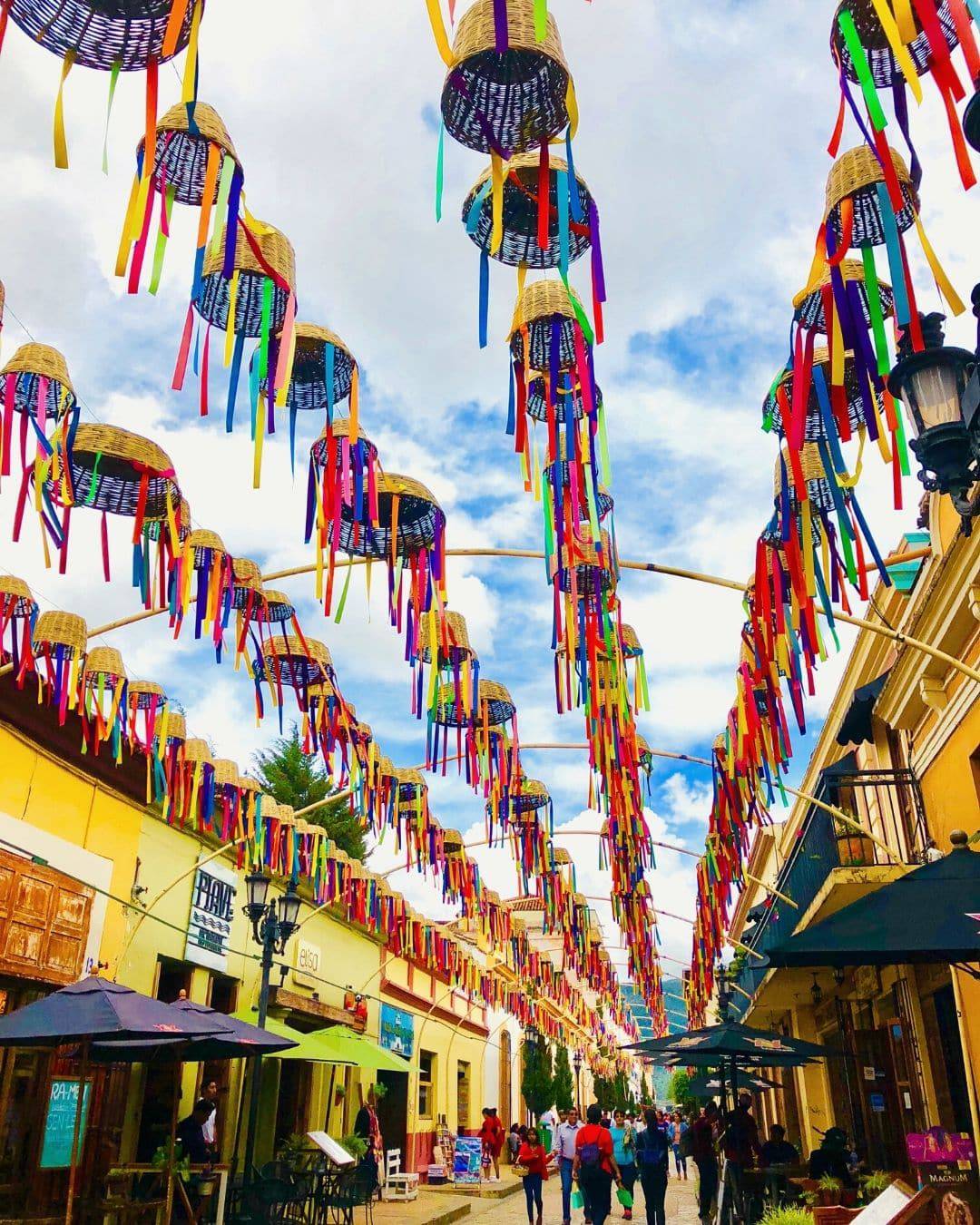
Cities in Chiapas: The best time to visit the cities (including San Cristobal de las Casas , Tuxtla Gutierrez, Comitan and Palenque ) is from November to May , during the dry season. Chiapas is on the cold side, so make sure you’re packing layers if you visit in winter.
Coastal Chiapas: On the coast of Chiapas, the dry season months of November to March are best. Keep in mind that if you visit during other months, it will be quite hot and humid, and mosquitoes are certainly an issue, so don’t forget your eco-friendly bug spray 🦟
Where is Chiapas Mexico located?
Chiapas is a state located in Southern Mexico, and borders the states of Oaxaca and Tabasco, and the country of Guatemala to the east. These two states are popular with culture travelers and backpackers alike.
Those continuing on to Central America from Mexico often have Chiapas as a last stop, as you can do a land crossing into Guatemala from this state.
Chiapas Map
What’s the best airport for Chiapas Mexico?
Tuxtla Gutierrez International Airport (code: TGZ) is the largest airport in Chiapas, located in the state’s capital city of Tuxtla Gutierrez, Mexico.
It is about one hour from San Cristobal de las Casas , the city frequented most by visitors to Chiapas state. ▶︎ BOOK AIRPORT SHUTTLE NOW!
You can also fly into the small Palenque International Airport (code: PQM), located in the Palenque pueblo magico (magic town). Here, you’ll find Palenque Mayan Ruins , a UNESCO World heritage Site, and some of the best Mayan Ruins in Mexico.
What’s the best way to get to San Cristobal de las Casas?
The safest, most-stress free, easiest and best way to get from Tuxtla Gutierrez Airport to your hotel in San Cristobal de las Casas is via private shuttle. ▶︎ BOOK NOW!
You can also rent a car , take a colectivo (small, shared van), or taxi. Note: There’s no Uber in Chiapas Mexico.
If you’re not headed to San Cristobal, you can take connecting ground transportation to other parts of the state via bus .
Where to stay in Chiapas Mexico
The vast majority of visitors stay in San Cristobal de las Casas (usually just called San Cristobal), located in the center of Chiapas state.
From here, you’re about five hours by car from both Palenque and Comitan, two other popular cities to visit outside of San Cristobal. Though the main airport is in Tuxtla Gutierrez, very few visitors stay there.
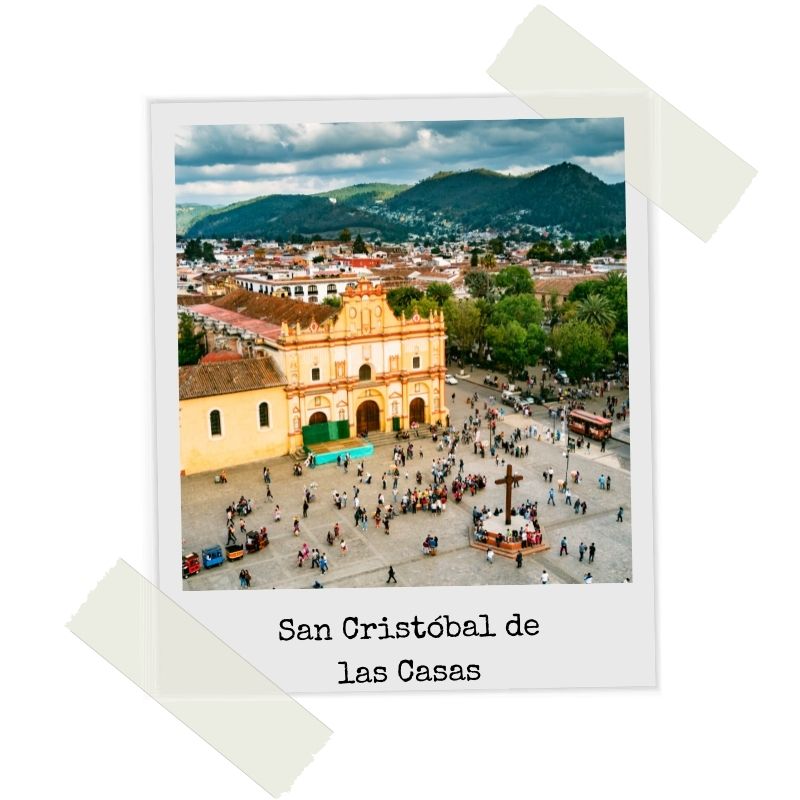
San Cristobal de las Casas
Located way up in the mountains in Chiapas state, you’ll find San Cristobal de las Casas . This pueblo magico (magic town) lives up to its magical name — and is very popular with nature and culture lovers, backpackers and digital nomads.
Is San Cristobal de las Casas worth visiting? This is a popular place for travelers seeking “real” Mexican culture. However, it also has a posh side, with amazing San Cristobal hotels with spas — so San Cristobal appeals to many types of travelers.

Palenque, Chiapas Mexico
There is the pueblo magico (magic town) of Palenque Mexico, and the famous Palenque Mayan Ruins within the town. When people refer to Palenque, they often mean the ruins, and not the town itself.
Is Palenque worth visiting? The Palenque Ruins are a must see in Chiapas! It is nice to stay for the night in the town of Palenque , though there isn’t much to see besides the ruins and the surrounding jungle nature.

Comitan, Chiapas Mexico
Comitan de Dominguez (usually just called Comitan) is a charming town about two hours south of San Cristobal. Enjoy the sounds of marimba music in the air, as you stroll its colonial streets and enjoy the local Chiapas food.
Is Comitan worth visiting? Comitan is the perfect home base to stay in for those who will be exploring southern Chiapas. If you want to see the Bonampak and Yaxchilan Mayan Ruins, they are both near Comitan.
Best things to do in Chiapas Mexico
There is a seemingly endless amount of things to do in Chiapas, one of the best vacation spots in Mexico.
The majority of them are in or near San Cristobal de las Casas, the main tourism hub, but for those who venture off the beaten path, there’s even more to Chiapas! Click on any image below to learn more ⤵
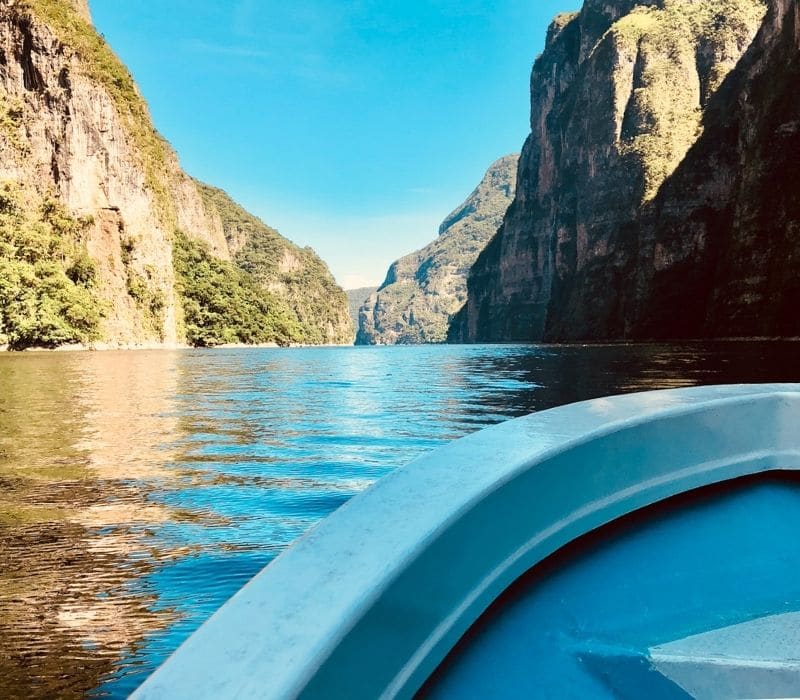
Sumidero Canyon
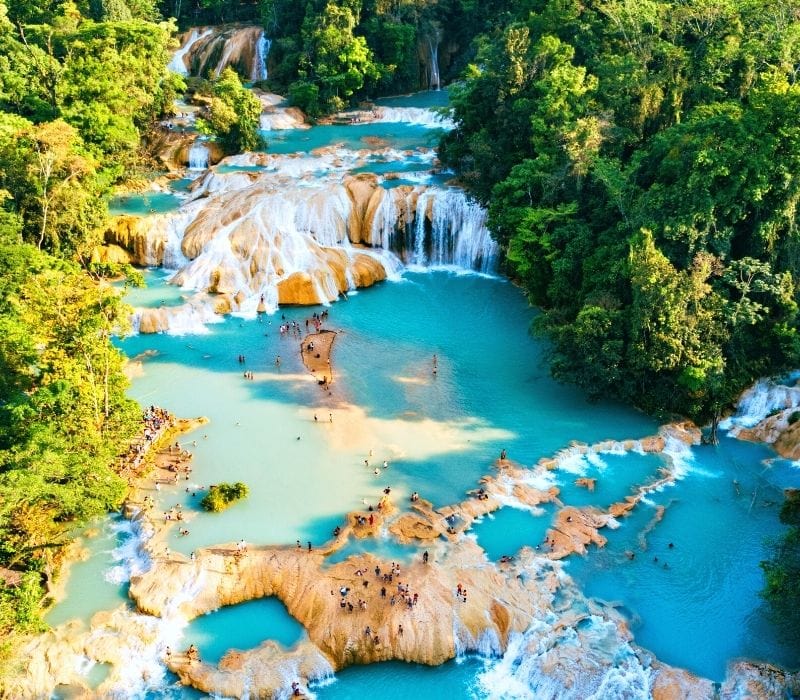
Agua Azul Waterfalls

Bonampak Ruins
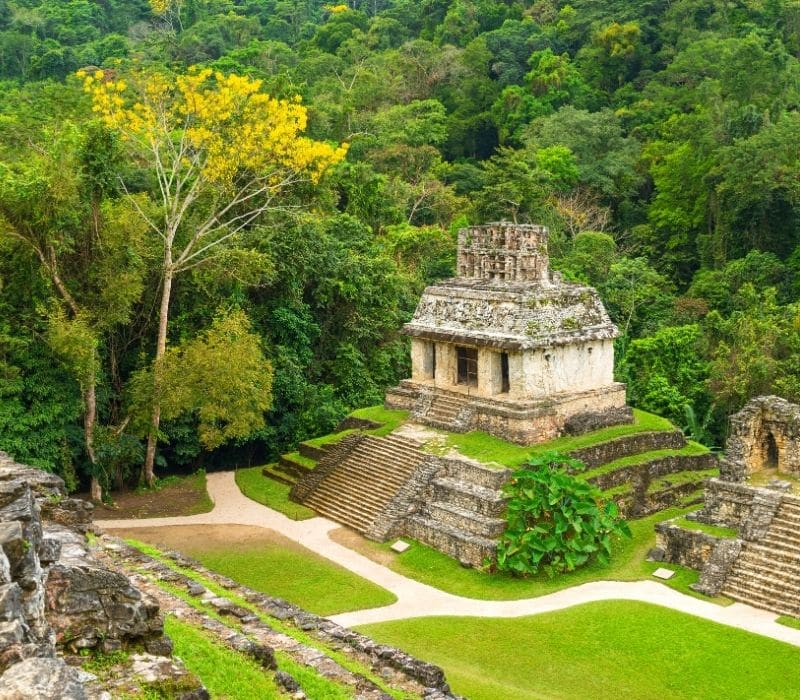
Palenque Ruins

San Juan Chamula

Montebello Lakes

El Chiflon Waterfalls

Chiapa de Corzo
Best chiapas tours.
Tours in Chiapas are a great way to see the main cities and their surrounding areas — and unless you’re planning to rent a car in Chiapas, this is the best way to get around because taxi fees add up quickly! 💡 Note: If you do want to have a car in Chiapas, make sure to check out this guide to Renting a Car in Mexico .
Below, you’ll find the most popular and best tours in San Cristóbal de las Casas and the surrounding areas — including Palenque Mayan Ruins, Sumidero Canyon, Agua Azul and El Chiflon Waterfalls, and more.
Is Chiapas safe for travelers?
According to experts, you are statistically quite safe while visiting Chiapas if you stick to the popular places like San Cristobal de las Casas , San Juan Chamula , and the Chiapas pueblos magicos (magic towns) of Palenque and Comitan de Dominguez.
Millions of Americans go to Mexico on vacation every year, so if we play the numbers game, the number of incidents is very small… When I’m asked if Mexico is a safe place to go travel on vacation, my response is yes . —Carlos Barron, FBI Veteran (source: Forbes )
That’s not to say bad things still don’t happen in those parts of Chiapas; they do. As with traveling anywhere, follow general travel safety like not walking home alone at night, watching your alcohol consumption and staying aware of yourself and surroundings.
For an added safety measure, pack these travel safety items , dress in a way so your Mexico outfits blend in with the locals, and buy a Mexico SIM card .
What’s the best travel insurance for Mexico?

This is a question I get a lot as a Mexico travel writer and Mexico expat. To determine which Mexico travel insurance is best for you , consider factors like the policy’s total cost, your deductible, the coverage you need, your medical benefits, etc.
🏆 In general, I only ever recommend three companies to purchase Mexico travel insurance from:
- World Nomads — For general travelers and adventure travelers.
- SafetyWing — For general travelers and digital nomads in Mexico.
- Travel Insurance Master — Mexico travel insurance search tool, for those who want to compare policies.
- 👉 Click on any of the links above to get a FREE quote on your policy!
Chiapas Travel: Frequently Asked Questions
Can you drink the water in mexico.
No — Unfiltered Mexico tap water is not safe for human consumption. However, you will need to keep drinking water and to stay extra hydrated, as Mexico is quite close to the Equator. In fact, dehydration is one of the most common ways people get sick in Mexico. So what can you do?
- If you’re renting a home with a kitchen, you can boil the water before drinking it.
- You can keep buying bottled water — Though this gets expensive, and is horrible for the planet!
- Use the Water-To-Go Filterable Bottle . This refillable bottle not only keeps you hydrated, but also filters your water so you don’t get sick in Mexico, and is good for the planet ♻️ Get 15% OFF with code SOLO15!

The Water-To-Go Bottle has a built-in, three-stage filtration system that removes 99.9999% of all water-borne contaminants. These include bacteria, microplastics, viruses, heavy metals, chemicals and more. I personally own one, as you can drink Mexico water from any source (even the tap), and be completely safe.
What’s the Chiapas weather like?
The main travel destinations in Chiapas are located in the northern and central part of the state — in the Central Highlands. These cities have temperatures that hover around 60-70°F (15-21°C) all year long.
However, the jungle and rainforest areas like Palenque, and the coast of Chiapas, see much hotter temperatures and high humidity.
☀️ san cristobal de las casas weather

Is Chiapas expensive?
No — Chiapas is actually one of the most budget-friendly places to live and cheap places to travel in Mexico.
It has been popular with backpacker and budget travelers for decades, but in the last few years, Mexico digital nomads have begun flocking to San Cristobal de las Casas for its low prices and good quality of life.
How many days do I need in Chiapas Mexico?
If you’re sticking to San Cristóbal de las Casas and the surrounding areas, four full days would suffice. With that amount of time, you can see the main sites including Palenque Mayan Ruins, the Agua Azul waterfalls, Sumidero Canyon and more.
For those who want to do some Chiapas off the beaten path travel, plan for at least one full week in Chiapas and venture to the coast. The best beaches in Chiapas — Puerto Arista and Boca del Cielo — are often empty, and you can really get away from it all.
Is Chiapas worth visiting?
Yes — Chiapas is a unique Mexico destination that many types of travelers will love. Nature enthusiasts will adore the waterfalls, lakes, caves and mountains, while artists and fashionistas can shop in the Chiapas mercados (markets) to buy colorful Mayan textiles and handicrafts.
If you’re interested in Mexican and Mayan culture, you must visit Chiapas Mexico!
Is there political unrest in Chiapas Mexico?
For the most part, Chiapas is safe for travelers, though Chiapas locals have a history of clashes with the Mexican government (for very justifiable reasons, btw).
However, tensions have been quiet for over a decade — though there are often bloqueos , which are protests where locals shut down the roads.
If you stick to the most visited places in Chiapas — San Cristobal de las Casas , San Juan Chamula , Tuxtla Guitierrez, Zinacantan, and the Chiapas pueblos magicos (magic towns) of Palenque , Comitan de Dominguez and Chiapa de Corzo, you should be safe while traveling to Chiapas.

Chiapas Mexico podcast
🎧 Love podcasts? Have a listen to Episode #782 of The Amateur Traveler Podcast, where I was featured to speak about my experiences and best tips for traveling to Chiapas Mexico! It may just be the only Chiapas podcast out there.
🗣 Mexico Language
Mexico Fun Fact : There’s actually no official language of Mexico!
Spanish is the most widely-spoken, so some mistakenly say Spanish is the official language of Mexico. However, the government actually recognizes 68 national languages, including the Nahuatl Aztec language, and the Maya language.
💰 Mexico Currency
Mexican Peso — Exchange rates vary, but have hovered around $18-21 pesos to $1 USD for about the last decade. You will find some places that take U.S. dollars, but usually at an unfavorable rate, so stick to using pesos in Mexico .
☀️ Mexico Weather
Mexico is a big country — the 7th largest on Earth, in fact! It’s hard to generalize the weather in Mexico, because it will vary greatly by where you’re traveling.
In general, temperatures are mostly mild everywhere all year long, though summers on the coast are hot and humid, and winters in Central and Northern Mexico are on the colder side. Throughout the whole country, the rainy season runs from (about) April through September.
✈️ Mexico Busy Season & Slow Season
• Mexico Busy Season: The busy season in Mexico runs October to March, as this is the dry season and you’ll get the best weather. December is the busiest month for tourism in Mexico.
• Mexico Slow Season : If you don’t mind some rain, you’ll often find the best travel deal during the Mexico slow season of April to September. Do keep in mind that June 1-November 1 is Hurricane Season, and Mexico beaches are all susceptible.
• Mexico Shoulder Season : The shoulder season is that magical time when prices are still low and the weather is good. The Mexico shoulder season is from about mid-October to November and January to early-April.
🧳 Download your FREE Mexico Packing Checklist here!
Check out this Ultimate Packing List for Mexico — so you know what to pack and what NOT to pack for Mexico! This article offers advice on packing for Mexico cities, and packing for a Mexico beach vacation.
Beyond what Mexico outfits and clothing you’ll want to bring, here are a few extra things to consider:
• Filterable Water Bottle: Mexico is close to the Equator, so you’ll need to stay extra hydrated. In fact, dehydration is one of the most common ways people get sick in Mexico.
A filterable, refillable water bottle not only keeps you hydrated, but also filters your water so you don’t get sick in Mexico.
The Water-To-Go Bottle has a built-in, three-stage filtration system that removes 99.9999% of all water-borne contaminants. These include bacteria, microplastics, viruses, heavy metals and chemicals.
• Mexico SIM Card: Want to be able to use your phone in Mexico?! Of course you do! Pick up a TELCEL Mexico SIM card before your trip, and swap it out on the plane while you’re waiting to exit, so you have phone and data service the second you arrive in Mexico.
• Anti-Hangover Meds: Planning to party hardy?! Make sure you’re not wasting any of your precious travel time with a hangover. Liquid I.V. has about 70,000 reviews on Amazon, and is considered the best defense against a hangover.
• Sun Hat: No matter if you’re headed to the beach or a city, you’ll want to wear a hat to shield yourself from the strong Mexican sun. This cute sun hat is the perfect stylish and practical accessory for your Mexico vacation.
• Sunscreen: As you’ll want to reapply a few times throughout the day, a light, Mineral-Based Sunscreen is ideal.
Headed to the beach? Do your part to practice responsible tourism in Mexico by only using an eco-friendly reef safe sunscreen while swimming. You can even ditch the sunscreen altogether and opt for a long sleeve swimsuit (AKA rash guard) instead.
• Bug Repellent: Mosquitoes are common throughout Mexico — especially on the beaches! REPEL Insect Repellent is an eco-friendly brand that’s DEET-free and plant based, with a pleasant lemon and eucalyptus scent. Don’t want to use a spray? Pick up some Mosquito Repellent Bracelets .
The vast majority of travelers do not need a visa for Mexico — this includes Americans, Canadians, and most Europeans. Head here to see if you need a Mexico travel visa.
🤔 What is the mexico FMM ?
When you go through Customs & Immigration to enter the country, you’ll receive your Forma Migratoria Multiple , or FMM Tourist Card (sometimes listed as FMT). If you’re coming by plane or cruise ship, there is no charge; for those driving across the border, the FMM costs about $30USD.
In most circumstances, all visitors get a 180-day (six month) visa — so you can legally stay up to six months!
🚨 Have your FMM on you at all times
Keep in mind that though it’s called an FMM card , it’s actually just a small piece of paper. Keep your FMM on you at all times in your wallet, as this proves your legal status in Mexico. It’s rare, but if an officer stops you, they can ask to see your FMM.
🎫 Don’t lose your FMM!
You need to have your FMM on you at all times, as proof of your legal status in the country.
Be sure to keep track of your FMM, as you’ll have to give it back to an Immigration officer at the airport, cruise port, or land crossing when you’re leaving the country.
If you lose your FMM, there is a $600 peso ($30 USD) cost to replace it, and some paperwork you’ll need to fill out before you can leave the country.
If you’re flying home, plan to arrive at the airport about one hour earlier than you normally would to do the paperwork and pay the fine.
As this question doesn’t have a yes/no answer ( I wish it did! ), I do my best to answer it in depth in this article, Is Mexico Safe for Travelers Right Now ? However, for the most part, Mexico is actually statistically quite safe for all travelers — including solo travelers.
Check my Solo Female Mexico Travel page for more info.
💃 Mexico solo travel guides
Mexico is a big country, and it has plenty of amazing solo female travel destinations — like the ones featured in this article, Mexico Solo Travel: 20 Safe Destinations for Female Travelers .
In it, you’ll get recommendations of places to visit in Mexico, from solo travelers who have actually been to them.
🎧 solo travel podcasts
• Ep. 34 | Planning your first Mexico solo trip • Ep. 40 | Tips for safe solo travel in Mexico • Ep. 53 | 30 Solo female travel tips, Pt. 1
To answer the question, Is it safe to drive in Mexico? — YES , it’s considered safe to rent a car and drive in Mexico.
As the country is quite large, road trips are a great way to see a lot in a little time, and especially popular in the Yucatan Peninsula and Baja California Peninsula.
The one caveat to Mexico driving safety is that you’ll be in a foreign country, unfamiliar with their laws and customs. Head here for a complete guide to Renting A Car in Mexico: Everything You Need to Know , where you’ll also get 10 useful Mexico driving tips!
🚙💨 Looking for the best Mexico car rental company? Discover Cars works with both local Mexican companies and international companies to get you the best rates. Not only do I recommend them — I also use them!

As a general rule, you’ll want to know at least a few words of Spanish when visiting anywhere in Mexico. This is both a sign of respect, and will also help you have a better, smoother trip.
If you stick to the more touristic places in Mexico, you should be fine with basic Spanish. For those planning to venture off the beaten path, be advised most people in pueblos (small towns) speak little to no English.
🗣 Here are some options:
- Brush up on your Spanish: Use a language-learning program like Rocket Spanish , so you’re confident, and conversational, before your trip.
- Download the Google Translate App: For this to work at all times, you’ll need a Mexico SIM card with data — as the app won’t work when you’re off-WiFi.
- Travel with a Mexico phrasebook: This Lonely Planet Spanish Phrasebook is an Amazon best seller, and a great non-digital language assistant!
- Save this infographic an image on your phone. This way, you have access to these common words, phrases and questions, even when you’re off-WiFi.
Chiapas Travel Guide
Book your individual trip , stress-free with local travel experts
Select Month
- roughguides.com
- North America
- Travel guide
- Itineraries
- Local Experts
- Travel Advice
- Accommodation
Plan your tailor-made trip with a local expert
Book securely with money-back guarantee
Travel stress-free with local assistance and 24/7 support
The company is very good, very friendly people work very seriously and responsibly, recommended.
Although they’re very different states – Chiapas is mountainous, and Tabasco is steamy lowlands – we group them together here, because travellers will usually pass through one or both of them en route to the Yucatán. Endowed with a stunning variety of cultures, landscapes and wildlife, Chiapas has much to tempt visitors, but the biggest draw is how many indigenous traditions survive intact, as well as how much pristine wilderness exists. The state of Tabasco , by contrast, is less aesthetically attractive than its neighbour, and its rural areas see almost no tourists. But its capital, Villahermosa, is a transit hub, and archeology buffs know the region as the heartland of the Olmecs, Mexico’s earliest developed civilization.
The State of Chiapas
Fiestas in chiapas and tabasco, palenque and around, brief history, tours around palenque, olmec culture, south of villahermosa, west of villahermosa, a taste of tabasco, villahermosa, parque-museo la venta.
Chiapas was administered by the Spanish as part of Guatemala until 1824, when it seceded to join newly independent Mexico. The state is now second only to Oaxaca in Indian population: about 25 percent of its four million-plus inhabitants are thought to be indígenas, of some fourteen ethnic groups, most of Maya origin. Tuxtla Gutiérrez is the capital, but travellers usually head straight for the colonial town of San Cristóbal de las Casas, tucked among the mountains in the centre of the state and surrounded by strongholds of Tzotzil and Tzeltal Maya culture. Ancient customs and religious practices carry on in these villages, yet as picturesque as life here may sometimes seem, villagers often live at the barest subsistence level, with their lands and livelihoods in precarious balance. These troubles helped fuel the 1994 Zapatista rebellion, and although that conflict has long subsided, many of the core issues concerning land use remain unresolved. Now illegal immigration is the bigger issue, and a heavy military presence focuses more on the Guatemalan border and the eastern half of the state.
In Tabasco , Villahermosa is the vibrant, modern capital, with a wealth of parks and museums, the best of which is Parque La Venta, where the original massive Olmec heads are on display. In the extreme southwest, bordered by Veracruz and Chiapas, a section of Tabasco reaches into the Sierra de Chiapas up to 1000m high. Here, in a region almost never visited by outsiders, you can splash in pristine rivers in Tapijulapa and explore the astonishing ruins of Malpasito, a city of the mysterious Zoque culture.
Travel ideas for Mexico, created by local experts
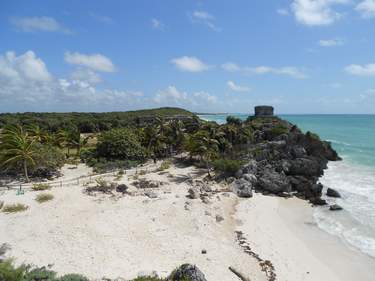
The Magic of the Yucatan and Mexico City
Explore the magic of the Yucatan Peninsula: from colonial towns like Merida to Archaeological sites like Uxmal and Calakmul, close to the Guatemala border, to beaches in Bacalar and Tulum, this itinerary shows you the real Yucatan before heading out to explore Mexico City.

Mexico City, Oaxaca & the Yucatan
Explore Central Mexico with its ever-busy capital Mexico City, visiting Teotihuacan and the famous museums in the city. Further on to Oaxaca City, the gateway to the Archaeological Site Monte Alban. Afterwards, continue to the white beaches of the Yucatan: Cancun and Isla Holbox await.
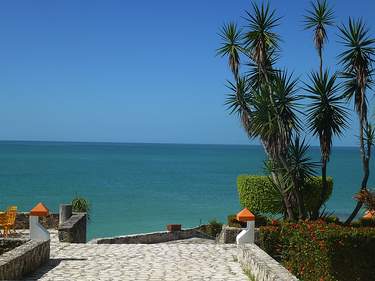
Fascinating Mexico: From Guanajuato to the Yucatan
Discover Mexico from fascinating San Miguel de Allende over busy Mexico City all the way to the Yucatan Peninsula. This itinerary combines public transportation with domestic flights to ensure you can make the most of discovering fascinating Mexico within two weeks.

Marvelous Mexico: From Yucatan to Mexico City
Your trip starts on the wonderful coast of Yucatan, exploring the beaches and archaeological highlights like Chichen Itza and Tulum. From there on continue the exploration to Palenque and Oaxaca before taking a flight to Mexico City - 3 days in the capital await your discovery.
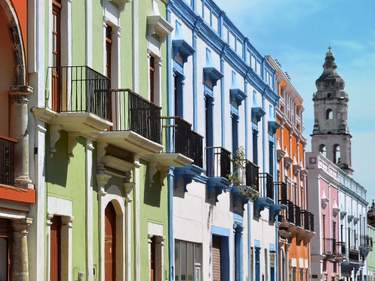
Mexico's Highlands and Coast
Discover Mexico City's historic highlights and the wonders of sites like Teotihuacan, Campeche and Palenque before you jet off to the Central HIghlands. Discover archeological ruins and traditional tribal villages, then fall for the charms of Mexico's old colonial cities and glitzy Caribbean coast.
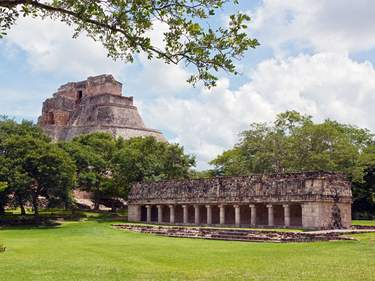
Mexico's Mayan Trail
Follow the Mayan Trail around Mexico on this archaeological adventure. Begin your journey with a refreshing taste of sea and salt air in the Yucatán Peninsula on one of Playa del Carmen's gorgeous Caribbean beaches before heading off to discover magical Mayan ruins and glorious colonial towns.
The state of Chiapas rises from the Pacific coastal plain to the peaks of two ranges, the Sierra Madre de Chiapas and Los Altos de Chiapas. The climate, like the land, varies enormously. The coastal areas can be hot and muggy, while in highland towns like San Cristóbal de las Casas, nights can call for a jumper, even in August.
Chiapas has the greatest biological diversity in North America. Its forests are home to howler monkeys, red macaws and jaguars. Most visitors will likely see these animals only at the zoo in Tuxtla Gutiérrez, but you can venture into the heart of the huge Montes Azules Biosphere Reserve, a section of the largest remaining rainforest in North America. From Ocosingo you can make forays into its heart, Laguna Miramar, a truly isolated wilderness destination. There’s also cloud forest in the south of the state, protected in El Triunfo Biosphere Reserve. From the pretty colonial town of Comitán de Domínguez, the isolated Frontier Highway runs along the Guatemala border and past the beautiful lakes and hills of the Parque Nacional Lagos de Montebello.
On the east side of the mountains, at the edge of the Yucatán plain, the Classic-period Maya city of Palenque is one of Mexico’s finest ancient sites. The limestone hills in this area are pierced by exquisite waterfalls. Palenque is the best starting point for a trip down the Usumacinta valley, to visit the remote ruins of Bonampak and Yaxchilán, where you can cross to Guatemala by boat. This remote eastern half of Chiapas is also the home of the Lacandón Maya, who retreated into the forest when the Spaniards arrived, and shunned all outside contact until some fifty years ago.
The states of Chiapas and Tabasco are extremely rich in festivals. Local tourist offices should have more information on what’s happening.
- New Year’s Day (Jan 1). San Andrés Chamula and San Juan Chamula, both near San Cristóbal, have civil ceremonies to install a new government for the year.
- Día de San Sebastián (Jan 20). In Chiapa de Corzo, a large fiesta with traditional dances (including the masked parachicos) lasts several days, with a re-enactment on Jan 21 of a naval battle on the Río Grijalva.
- Día de la Candelaria (Feb 2). Colourful celebrations at Ocosingo.
- Fiesta de San Caralampio (Feb 11–20). In Comitán, celebrated with a parade to San Caralampio church, where elaborate offerings are made and dances held in the plaza outside.
- Carnaval (the week before Lent; variable Feb & March). Celebrated in hundreds of villages throughout the area, but at its most frenzied in the big cities, especially Villahermosa.
- Anniversary of the foundation of Chiapa de Corzo (March 1). Town fair with kiddie rides, live music and more.
- Semana Santa (Holy Week). Widely observed. There are particularly big ceremonies in San Cristóbal de las Casas. Ciudad Hidalgo, at the border near Tapachula, has a major week-long market.
- Feria de San Cristóbal de las Casas (April 1–7). Festival in San Cristóbal de las Casas celebrating the town’s foundation.
- Feria de Villahermosa (second half of April). Villahermosa hosts its annual festival, with agricultural and industrial exhibits and the election of the queen of the flowers.
- Día de San Pedro (April 29). Celebrated in several villages around San Cristóbal, including Amatenango del Valle and Zinacantán.
- Día de la Santa Cruz (May 3). Celebrated in San Juan Chamula and in Teapa, between Villahermosa and San Cristóbal.
- Día de San Isidro (May 15). Peasant celebrations everywhere – famous and picturesque fiestas in Huistán, near San Cristóbal. There’s a four-day nautical marathon from Tenosique to Villahermosa, when craft from all over the country race down 600km of the Río Usumacinta.
- Día de San Antonio (June 13). Celebrated in Simojovel, near San Cristóbal, and Cárdenas ( Tabasco ), west of Villahermosa.
- Día de San Juan (June 24). The culmination of several days’ celebration in San Juan Chamula.
- Día de San Cristóbal (July 17). Celebrated enthusiastically in San Cristóbal de las Casas and in nearby villages such as Tenejapa and Amatenango del Valle.
- Día de Santiago (July 25). Provokes widespread celebrations, especially in San Cristóbal de las Casas.
- Fiesta de Santo Domingo de Guzmán (last week of July, first week of Aug). Comitán’s fair, with concerts, rodeos and more.
- Fiesta de San Lorenzo (Sun nearest Aug 10). Celebrated in Zinacantán, with much music and dancing.
- Día de Santa Rosa (Aug 30). Celebrated in San Juan Chamula, when the locals don traditional garb and play Tzotzil harps and instruments outside the church.
- Independence Day (Sept 14–16). In Chiapas, independence celebrations are preceded by those in honour of the state’s annexation to Mexico.
- Día de la Virgen del Rosario (first Sun in Oct). Celebrated in San Juan Chamula and Zinacantán with Tzotzil folk music and dances. There’s also a special craft market.
- Día de los Muertos (Day of the Dead; Nov 1–2) The most captivating celebration of the Day of the Dead in Chiapas takes place in Comitán, where the cemeteries overflow with flowers and ornate altars.
- Día de la Virgen de Guadalupe (Dec 12). An important day throughout Mexico. There are particularly good fiestas in Tuxtla Gutiérrez and San Cristóbal de las Casas.
- Feria and cheese expo (Dec 17–22). Held in Pijijiapan, on the coast highway to Tapachula.
San Cristóbal de las Casas and around
The unofficial capital of highland Chiapas, San Cristóbal de las Casas – or Jovel, as many locals call it – is a major stop on the travel circuit. But the city, a clutch of tile-roofed houses huddled together in the bowl of a valley, has held up to tourism well. The modern edges of the city don’t make a good first impression, but the centre has none of this unchecked development: pedestrianized central streets foster a low-key social scene, with a cosmopolitan mélange of small bars and restaurants that thrive on a certain degree of leftist-revolutionary cachet. It’s also a great base for studying at one of the numerous Spanish-language schools.
San Cristóbal is also a prime base for exploring highland Chiapas, perhaps the most scenic part of Mexico. The densely forested mountains give way to dramatic gorges, jungle valleys flush with orchids, vividly coloured birds and raucous monkeys. In addition, the area’s relative isolation has allowed the indigenous population to carry on with their lives little affected by Catholicism and modern commercialism – and this includes clothing and craft traditions as brilliantly coloured and rich as the wildlife (though older people in particular maintain a traditional aversion to photography – be sure to ask permission first, and respect the answer). Villages to the west of San Cristóbal are generally Tzotzil-speaking, and those to the east speak Tzeltal, but each village has developed its own identity in terms of costume, crafts and linguistics.
Just 75km from Tuxtla, up the fast toll highway that breaks through the clouds into pine forests, San Cristóbal is almost 1700m higher, at 2100m. Even in August, the evenings are chilly – be prepared.
San Cristóbal was designed as a Spanish stronghold against an often hostile indigenous population – the attack here by Zapatista rebels in January 1994 was only the latest in a long series of uprisings. It took the Spaniards, led by conquistador Diego de Mazariegos, four years to pacify the area enough to establish a town here in 1528. The so-called Villareal de Chiapa de los Españoles was more widely known as Villaviciosa (Evil City) for the oppressive exploitation exercised by its colonists. In 1544, Bartolomé de las Casas was appointed bishop, and he promptly took an energetic stance in defence of the native population, playing a similar role to that of Bishop Vasco de Quiroga in Pátzcuaro. His name is still held in something close to reverence by the local population. Throughout the colonial era, San Cristóbal was the capital of Chiapas (at that time part of Guatemala), but lost this status in 1892 as a result of its continued reluctance to accept the union with Mexico.
Independent as the indigenous groups are, economic and social status in the mountains around the city lags far behind the rest of Mexico. This is in part due to the long duration of the encomienda system of forced labour, which remained in place here long after the end of Spanish colonialism. Many small villages still operate at the barest subsistence level. It’s worth noting that many indigenous communities and some local transport operators refuse to observe the time change in summer, preferring la hora vieja – the old time, or, as some savvy marketers have dubbed it, ‘Zapatista time’.
Kinta Jimultik in San Juan Chamula
During the annual Kinta Jimultik, the carnival (five days in Feb/March), representatives of all the villages in the area around San Cristóbal attend in traditional dress, marching in circles around Iglesia de San Juan Bautista and up to strategically placed crosses on the hillsides for the first four days. On the final day, which coincides with the last of the five ill-fated days of the Maya calendar, purification rites and fire-walking ceremonies take place in the plaza.
Visiting Chamula and Zinacantán
Almost everyone who stays in San Cristóbal visits the Tzotzil Maya villages of San Juan Chamula and San Lorenzo de Zinacantán. Both places have retained much of their unique cultural identity, including a religion that is a blend of traditional animist belief and Catholicism. The church at Chamula, in particular, is one of the most moving sights in Mexico.
It’s hard not to feel a sense of intrusion in these settings, where you may be a spectator at some intense religious ritual. Though an organized tour (very easy to arrange in San Cristóbal) can feel a little rushed and contrived, paradoxically it may make you feel like less of a gate-crasher – your presence in the church is made a bit more ‘official’, and the guides can explain some of the rituals. Tours depart at 9.30am, visit both villages and return to San Cristóbal around 2pm (there is little difference between companies).
If you do come on your own, you’ll feel less conspicuous in busy tourist times (Aug primarily), when there’s more of a Mexican tourist crowd, and a festive atmosphere. Inexpensive combis leave frequently for Chamula, Zinacantán and other villages from Edgar Robledo, just north of the market in San Cristóbal. There are no combis between Chamula and Zinacantán.
Visiting Chiapas: the legacy of the Zapatista rebellion
On January 1, 1994, the day that the North American Free Trade Agreement (NAFTA) came into effect, several thousand lightly armed rebels calling themselves Zapatistas (after early twentieth-century revolutionary Emiliano Zapata) occupied San Cristóbal de las Casas, the former state capital and Chiapas’ major tourist destination. The Zapatistas declared themselves staunchly anti-globalization, as well as opposed to local efforts by paramilitary groups to force indigenous people off the land. When the Mexican army recovered from its shock, it launched a violent counterattack, but international solidarity with the rebels soon forced the Mexican government to call a halt.
A ceasefire was agreed in 1995, and negotiations have continued over the years, as yet to conclude in a peace treaty. But eventually the issue of indigenous rights spread beyond the state’s borders, with large-scale disturbances in Oaxaca in 2006 making Chiapas seem relatively peaceful.
Twenty years on, the word “Chiapas” is still synonymous with violent revolution, but while the Zapatistas remain nominally “at war” with the Mexican government, the struggle is now largely ideological. The organization still runs its own municipalities, “caracoles”, on land seized from large landowners, and is largely left alone by the government. Tourists have always visited Chiapas with no problems other than delays due to army (and occasional Zapatista) checkpoints. The government is hostile to foreign Zapatista sympathizers, however, as their presence is considered an illegal influence on Mexican politics – so showing obvious Zapatista support in Chiapas can potentially lead to deportation.
Chiapa de Corzo and around
An elegant town of about seventy thousand, CHIAPA DE CORZO overlooks the Río Grijalva. As it’s barely twenty minutes east of Tuxtla, it makes a scenic alternative to the big city. It’s best known as the starting point for boat rides through the Cañón del Sumidero, and has quite a tourist scene during Mexican holiday times. The first Spanish city in Chiapas, it was officially founded in 1528, though it had already been an important centre in pre-Classic times. A stele found here bears the oldest Long Count date yet discovered, corresponding to December 7, 36 BC. The ruins that remain are on private land behind the Nestlé plant, at the far end of 21 de Octubre on the edge of town.
Cañon del Sumidero
On the highway east from Chiapa de Corzo towards San Cristóbal, you catch occasional glimpses of the Río Grijalva and the lower reaches of one of Mexico’s deepest canyons, with walls up to 1000m high in some places. Its rock walls are sprinkled with patches of bright green vegetation and odd rock formations, and carved out with shallow caves. A drive along the rim passes miradores (lookout points) that are unnervingly close to the edge – the most dramatic is at Las Coyotas. A boat ride up the river from Chiapa de Corzo is just as awe-inspiring, snaking through the whole gorge up to the Chicoasén Dam, which forms a lake at the northern end. Along the way are several waterfalls, including the remarkable El Árbol de Navidad, where calcareous formations covered in algae resemble a Christmas tree. Crocodiles and spider monkeys can often be spotted, along with pelicans, egrets and cormorants.
The one drawback to the water-level view from the boat is the undeniable amount of rubbish in the water that collects along the stagnant edges of the canyons. It’s periodically rounded up and disposed of, but it’s particularly bad during the rainy season, when the water is highest. But this shouldn’t deter you from seeing the greatest geological wonder in Chiapas.
Chiapa de Corzo boat tours
In Chiapa de Corzo, several companies offer boat trips down the canyon, all for around the same price. The first office you reach is Turística de Grijalva (961 600 6402), on the west side of the plaza. Or you can head straight south down the street to the embarcadero, where other companies operate. During Mexican vacation times, boats fill with the requisite ten people almost immediately, and it doesn’t matter where you buy your ticket. In slower times, it’s best to show up early and go from company to company to see which boat is closest to full. Tours last a couple of hours.
Comitán de Domínguez
The fourth-largest city in Chiapas, Comitán is 88km from San Cristóbal, southeast along the Panamerican Highway through scintillating scenery. Strategically poised on a rocky hillside, the city is surrounded by rolling farms and wild countryside in which orchids bloom. Once past the scrappier outskirts, the city has an elegant colonial core and a small but absorbing market, as well as a mellow timetable, with many businesses still observing an afternoon siesta. Travellers often pause here before heading for the border with Guatemala or deeper into the wild at the Lagos de Montebello or the Lacandón forest.
Once a major Maya population centre (the ruins of Bonampak and Yaxchilán and even Palenque are not far, as the parrot flies), Comitán was originally known as Balún Canán (“Nine Stars”, or “Guardians”), but was renamed Comitán (“Place of Potters” in Náhuatl) when it came under Aztec control. At 1560m, it’s not as high as San Cristóbal but can still be more refreshing than the sweltering lowlands; make sure your hotel has blankets.
The Usumacinta valley and the Frontier Highway
The Carretera Fronteriza (Frontier Highway) heads south from Palenque into the Lacandón forest and the Río Usumacinta, passing the two great Maya sites of Bonampak and Yaxchilán. The remote highway, which was paved only in 2000, to help delineate the border with Guatemala, has a reputation as a dangerous place. Although tourist convoys are no longer required, it’s still not advisable to drive the road after dark: there is a risk of robbery, a lot of wildlife, and few people to help you if you break down, have an accident or encounter any trouble. Army checkpoints are common, so make sure you have your passport. If you don’t visit with a group, try to pick up an information sheet on the Lacandón community from Casa Na-Bolom in San Cristóbal.
Relatively small compared with other ruined Maya cities, BONAMPAK is unique due to its fascinating murals, evocative memorials to a lost civilization. Bonampak’s actual buildings, most from the eighth century, are small and not the most spectacular, but the murals definitely make it worth the visit – there is very little like them elsewhere in the Maya world, and even in their decayed state, the colours are vivid and the imagery memorable.
Bonampak lies in the small biosphere reserve controlled by the Lacandón on the fringe of the much larger Montes Azules Biosphere Reserve. The site is quite isolated, and the only facilities are toilets and a couple of huts selling crisps and carved-wood souvenirs. The nearest settlement is the village of Lacanjá Chansayab, about 2.5km away – basic cabañas, rented by the Lacandón people, are available here.
The outside world first heard of Bonampak, meaning “painted walls”, in 1946, when Charles Frey, an American who’d dodged the draft by heading to the Mexican forest during WWII, was shown the site (but apparently not the murals) by Lacandón, who still worshipped at the ancient temples. The first non-Maya to actually see these murals – astonishing examples of Classic Maya art – was the American photographer Giles Healey, who arrived shortly after Frey’s visit, sparking a long and bitter dispute over exactly who was responsible for their discovery.
La Gran Plaza
After crossing an airstrip, you are at the northwest corner of the central plaza, 110m long and bounded by low walls that mark the edges of a former palace. In the centre of the plaza Stele 1 shows a larger-than-life Chaan Muan II, the last king of Bonampak, dressed for battle – at 6m, it is one of the tallest steles in the Maya world. You’ll encounter other images of him throughout the site.
The Acrópolis
Ahead of the Gran Plaza, atop several steep flights of steps, lies the Acrópolis. On the lower steps, more well-preserved steles show Chaan Muan with his wife, Lady Rabbit, preparing himself for blood-letting and apparently about to sacrifice a prisoner. From the highest point of the acropolis there’s an impressive sense that you’re surrounded by primeval forest – the Selva Lacandona – with just a small cleared space in front of you.
Edificio de las Pinturas
The highlight is the modest-looking Edificio de las Pinturas, halfway up the steps of the acropolis. Inside, in three separate chambers and on the temple walls and roof, the Bonampak murals depict vivid scenes of haughty Maya lords, splendidly attired in jaguar-skin robes and quetzal-plume headdresses, and equally well-dressed ladies; and bound prisoners, one with his fingernails ripped out, spurting blood. Dating to around 790 AD, these paintings show the Bonampak elite at the height of their power: unknown to them, the collapse of the Classic Maya civilization was imminent. Some details were never finished, and Bonampak was abandoned shortly after the scenes were painted.
Though you can’t enter the rooms fully, the vantage point inside the doorway is more than adequate to absorb what’s inside. No more than three people are permitted to enter at any one time and queues are possible, but you shouldn’t have to wait long. Having said that, time and early cleaning attempts have clearly taken their toll on the murals, and apart from a few beautifully restored sections, it takes some concentration and imagination to work out what you’re looking at.
In Room 1, an infant wrapped in white cloth (the heir apparent?) is presented to assembled nobility under the supervision of the lord of Yaxchilán, while musicians play drums, pipes and trumpets in the background. Room 2 contains a vivid, even gruesome, exhibition of power over Bonampak’s enemies: tortured prisoners lie on temple steps, while above them lords in jaguar robes are indifferent to their agony. A severed head rolls down the stairs and Chaan Muan II grasps a prisoner (who appears to be pleading for mercy) by the hair – clearly about to deal him the same fate. Room 3 shows the price paid for victory: Chaan Muan’s wife, Lady Rabbit, prepares to prick her tongue to let blood fall onto a paper in a pot in front of her. The smoke from burning the blood-soaked paper will carry messages to ancestor-gods. Other gorgeously dressed figures, their senses probably heightened by hallucinogenic drugs, dance on the temple steps.
A larger and more dramatic site than Bonampak, Yaxchilán was an important Classic-period centre. From around 680 to 760 AD, the city’s most famous kings, Escudo Jaguar (Shield Jaguar) and his son Pájaro Jaguar IV (Bird Jaguar), led a campaign of conquest that extended Yaxchilán’s sphere of influence over the other Usumacinta centres and made possible alliances with Tikal and Palenque. The buildings occupy a natural terrace above the river, with others climbing steep hills behind – a superb natural setting.
Not so many people make the trip here, which involves a ride in a narrow lancha with a tin roof for shade, down the broad, fast-flowing river with Mexico on one bank, Guatemala on the other. At the site, it’s easy to be alone in the forest with nothing but moaning howler monkeys around you. Giant trees keep the place shady, but nonetheless the jungle heat can be palpable – bring plenty of water, as there are no services at the ruins.
Pequeña Acrópolis
From the site entrance, the main path leads straight ahead to the Gran Plaza, but if you have the energy for climbing, it’s more rewarding to explore the wilder parts of the site first. Follow the branching path to the right that leads up the hillside to the Pequeña Acrópolis, a set of thirteen buildings. A lintel on the most prominent ruin, known as Edificio 42, depicts Escudo Jaguar with one of his warriors.
Templos del Sur
Walk behind Edificio 42 to find another narrow trail down through the jungle, over several unrestored mounds, until you reach a fork: to the right, the path climbs steeply once again until it reaches, in about ten minutes, Edificios 39 to 41, also called the Templos del Sur, 90m above the river level – buildings that probably had some kind of astronomical significance. High above the main forest, this is also a good spot to look for canopy-dwelling birds like parrots, though the trees also obscure any view.
Retrace your steps back to the main path, and continue on until it emerges at the back of Edificio 33, the most famous building at the site, also known as El Palacio. It overlooks the main plaza from a high terrace. The lintels here are superbly preserved, and inside one of the portals is a headless statue of Pájaro Jaguar IV. In ancient times the building was a political court; more recently, it served as a religious site for the Lacandón Maya.
Descending 40m down the stairs in front of the Palacio brings you to the long Gran Plaza. Turn back to look up at the Palacio: with the sun shining through the building’s roofcomb and tree roots cascading down the stairs, this is what you imagine a pyramid lost in the jungle should look like, especially if you’ve been brought up on Tintin.
To your left, just above the level of the plaza, Edificio 23 has a few patches of coloured stucco around its doorframes – just one patch of many well-preserved paintings and relief carvings on the lintels of buildings surrounding the long green lawn. Some of the very best works were removed in the nineteenth century and are now in the British Museum in London, but the number and quality of the remaining panels are unequalled at any other Maya site in Mexico. Many of these depict rulers performing rituals.
This can also be seen on Stele 1, right in the middle of the plaza, near the base of the staircase. It depicts Pájaro Jaguar IV in a particularly eye-watering blood-letting ceremony, ritually perforating his penis. Stele 3, originally sited at Edificio 41, has survived several attempts to remove it from the site and now lies at the west side of the plaza, where it shows the transfer of power from Escudo Jaguar to Pájaro Jaguar IV.
El Laberinto
Heading back to the entrance, be sure to pass through El Laberinto (The Labyrinth) at the plaza’s northeast corner, the most complex building on the site, where you can walk down through dim passages out onto the main path.
The Lacandón
You may already have encountered the impressively wild-looking Lacandón Maya, dressed in simple white robes and selling exquisite (and apparently effective) bows and arrows at Palenque. Until recently, they were the most isolated of all the Mexican Indian groups. The ancestors of today’s Lacandón are believed to have migrated to Chiapas from the Petén region of Guatemala during the eighteenth century. Prior to that the Spanish had enslaved, killed or relocated the original inhabitants of the forest.
The Lacandón refer to themselves as “Hach Winik” (true people). Appearances notwithstanding, some Lacandón families are (or have been) quite wealthy, having sold timber rights in the jungle, though most of the timber money has now gone. This change has led to a division in their society, and most live in one of two main communities: Lacanjá Chansayab, near Bonampak, a village predominantly made up of evangelical Protestants, some of whom are keenly developing low-impact tourist facilities; and Nahá, where a small group still attempts to live a traditional life, and where it is possible to arrange stays in local homes. The best source of information on the Lacandón in Chiapas is Casa Na-Bolom in San Cristóbal de las Casas, where you can find a manuscript of Last Lords of Palenque, by Victor Perera and Robert Bruce. Hach Winik, by Didier Boremanse, is an excellent recent study of Lacandón life and history.
Parque Nacional Lagos de Montebello
Fifty kilometres southeast of Comitán, along the border with Guatemala, the Parque Nacional Lagos de Montebello is beautiful wooded country studded with more than fifty lakes, sixteen of them very large, and many edged with small restaurants providing local food and basic cabañas. The combination of forest and water is reminiscent of Scotland or Maine, with many kilometres of hiking potential. For the less energetic, roadside viewpoints provide glimpses of various pools, lent different tints by natural mineral deposits and the angle of the sun. The lakes themselves are actually a series of cenotes (sinkholes) formed by the erosion of limestone over millions of years.
San Juan Chamula
Usually referred to as just Chamula, this is the closest indigenous village to San Cristóbal (10km), as well as the most frequently visited. It has a population of fifteen thousand or so, and more than ninety thousand in the surrounding municipality – despite the fact that thousands of residents have been cast out in recent decades for converting to Protestant faiths (these so-called expulsados create many of the crafts sold in San Cristóbal proper).
Chamula and the surrounding indigenous communities are essentially self-governing, and have their own schools, police force, and a small prison with two cells that are semi-open so as to expose the criminals to “public shame”. Over the centuries, the village has been far more resistant to change than neighbouring Zinacantán, putting up fierce resistance to the Spaniards from 1524 to 1528, then acting as the centre of a rebellion described as the second “Caste War” from 1867 to 1870, inspired by the uprising in the Yucatán.
On the north side of the plaza, the two hundred-year-old Iglesia de San Juan Bautista, painted a festive turquoise, is the epicentre of Tzotzil Maya religion in the area, and one of the most intensely sacred spots in all of Mexico. A visit can be a humbling and moving experience. The interior is glorious, the floor covered with pine needles and the light of a thousand candles casts an eerie glow. Lining the walls are statues of the saints adorned with offerings of clothes, food and mirrors (thought to aid communication with the laity), while above the altar, San Juan, patron saint of the village, takes pride of place. The customs practised inside the church incorporate aspects of Christian and Maya beliefs – each villager prays by clearing an area of pine needles and arranging a “message” in candles, and rituals frequently involve tearful chanting, singing, an array of fizzy drinks – locals believe expelling gas through burping helps to release evil spirits – and posh, a sugar-cane alcohol. Eggs, bones and live chickens – which are sacrificed in the church and later eaten or buried – are also used in these ceremonies. There are no priests, masses or marriages here, only baptisms, and the church is open 24 hours (though tourists are welcome only during daylight). It plays a central role in healing ceremonies.
In keeping with Chamula's very traditional atmosphere, photography is generally not appreciated, and it is explicitly banned inside the church.
Chiapas on a plate
While the cuisine of Chiapas is not as famous as that of neighbouring Oaxaca, you can still eat very well while visiting the state. Dishes to look out for include pepita con tasajo (sliced beef marinated in chilli and herbs), tamales flavoured with local herbs like hoja santa and chipilín, pork in a pipian (pumpkin seed) sauce, and (in the coastal regions) dried shrimps in a tomato sauce. The city of San Cristóbal de las Casas is known for its Spanish-style cured hams and sausages, while the area around Ocosingo produces a good range of artisanal cheeses, and Chiapa de Corzo is famous for its suckling pig dishes. In terms of drinks, as well as excellent coffee from the state’s highland regions, there are some more unusual beverages to sample, such as tazcalate (a blend of toasted corn, chocolate and cinnamon) and pozol (a sugary corn and chocolate drink).
Set in thick jungle buzzing with insects, the ancient Maya ruins of Palenque are some of Mexico’s finest Maya sites: less crowded than Chichén Itzá, larger than Uxmal, and with the most spectacular setting. It is a relatively small site – you can see everything in a morning – but a fascinating one, strongly linked to the lost cities of Guatemala while displaying a distinctive style.
Nine kilometres east of the ruins, the rather helter-skelter town of Palenque functions as the base for exploring the ruins and the waterfalls in the nearby hills. With every facility a visitor might need, it’s lively enough, but it has no real intrinsic appeal. As there are a number of excellent camping sites, cabañas and hotels near the ruins, you may prefer not to stay in town at all.
The ruins are located in the Parque Nacional de Palenque, the border of which is just after El Panchán accommodation and restaurant site. The main road first passes a well-stocked artesanía shop, a café and the excellent site museum. You can enter at the gate across the road, hiking up to the main part of the site via the waterfalls trail, but most people will press on to the main site entrance, at the top of the hill another 2km up a winding road. Near this main entrance, there’s a small café and numerous souvenir stalls selling drinks, as well as toilets and some expensive lockers.
The ruins themselves bear a closer resemblance to the Maya sites of Guatemala than to those of the Yucatán, but ultimately the style here is unique – the towered palace and pyramid tomb are like nothing else, as is the abundance of reliefs and inscriptions. The setting, too, is remarkable. Surrounded by jungle-covered hills, Palenque is right at the edge of the great Yucatán plain – climb to the top of any of the structures and you look out over an endless stretch of low, pale-green flatland. If you arrive early enough in the day, the mist still clings to the treetops and the howler monkeys are roaring off in the greenery.
Rough Guides tip: Find tons of ideas for your Mexican adventure in our guide to the best vacation spots in Mexico .
Founded around 100 BC as a farming village, it was four hundred years before Palenque began to flourish, during the Classic period (300–900 AD). Towards the end of this time the city ruled over a large part of modern-day Chiapas and Tabasco, but its peak, when the population is thought to have numbered some one hundred thousand, came during a relatively short period in the seventh century, under two rulers: Hanab Pakal (Jaguar Shield) and Chan Bahlum (Jaguar Serpent). Almost everything you can see (and that’s only a tiny, central part of the original city) dates from this era.
Touts offer a huge variety of tours to local attractions in the vicinity of Palenque, above all the waterfalls at Agua Azul and Misol-Há and the ruins of Bonampak and Yaxchilán. There are also trips to Tikal in Guatemala or to Toniná, and adventure tours, including kayaking and horseriding. Be sure to check what’s included in the price – entrance fees, meals and English-speaking guides most importantly. One of the more reliable agents is Viajes Na Chan Kan (916 345 2154, [email protected] or [email protected]), on Hidalgo at Jiménez.
Few visitors view the state of Tabasco as more than a transit corridor for Palenque. Crossed by numerous slow-moving tropical rivers on their way to the Gulf, the low-lying, humid region is the homeland of the ancient Olmec, Maya and Zoque cultures. You can see the legendary Olmec stone heads in a beautifully done exhibition in state capital Villahermosa, a city otherwise often maligned for its concrete and chaos, yet boasting a historic, lively and pedestrian-friendly downtown.
Hwy-180 runs close to Tabasco’s coast, alternating between estuaries and sand bars, salt marshes and lagoons. Though the sands are a bit insect-ridden, and the views often marred by the offshore oil industry, they do have the virtue of being frequented only by locals, if at all. Much of inland Tabasco is very flat, consisting of the flood plains of a dozen or so major rivers. Boat trips along the Grijalva and the Usumacinta are the best way to glimpse remote ruins and abundant birdlife. You can also travel by river into the Petén in Guatemala, from the far eastern corner of the state.
In the far south of the state, the foothills of the Sierra Puana offer a retreat from the heat and humidity. Waterfalls spill down from the mountains, and a few small spas (balnearios) have developed. Village tracks provide some great hiking trails too.
Throughout the Maya period, Tabasco was a natural crossroads, its great rivers important trade routes to the interior. But its local Maya communities were relatively unorganized, and when Hernán Cortés landed at the mouth of the Río Grijalva in 1519, he easily defeated the Chontal Maya. But the town he founded, Santa María de la Victoria, was beset first by indigenous attacks and then by pirates, eventually forcing a move to the present site and a change of name to “Villahermosa de San Juan Bautista” in 1596.
For most of the colonial period, swampy Tabasco remained a relative backwater. Independence did little to improve matters, as local leaders fought among themselves, and it took the French invasion of 1862 to bring some form of unity, though Tabasco offered fierce resistance to this foreign intrusion. The industrialization of the country under dictator Porfirio Díaz passed Tabasco by, and even after the Revolution it was still a poor state, dependent on cacao and bananas. Though Tomás Garrido Canabal, Tabasco’s socialist governor in the 1920s and 1930s, is still respected as a reformer whose laws regarding workers’ rights and women’s suffrage were decades ahead of the rest of the country, his period in office was also marked by intense anticlericalism. Priests were killed or driven out (a process vividly brought to life in Graham Greene’s The Power and the Glory; he covers the aftermath in The Lawless Roads), all the churches were closed, and many, including the cathedral in Villahermosa, torn down.
The region’s oil, discovered in the 1930s but not fully exploited until the 1970s, provided the impetus to bring Tabasco into the modern world, enabling capital to be invested in the agricultural sector and Villahermosa to be transformed into the cultural centre it is today.
Relatively little is known about the Olmec culture, referred to by many archeologists as the mother culture of Mesoamerica. Its legacy, which includes the Long Count calendar, glyphic writing, a rain deity and probably also the concept of zero and the ball-game, influenced all subsequent civilizations in ancient Mexico. The name Olmec comes from Nahautl (the language of the Aztecs) word “Olmecatl”, meaning “rubber people”; this is a reference to the Olmecs practice of extracting latex from trees growing in the region and mixing it with the sap of local vines to produce rubber.
The fact that the Olmecs developed and flourished in the unpromising environment of the Gulf coast swamps 3200 years ago only adds to their mystery. After emerging around 1200 BC, and eventually spanning across northern Central America and much of central Mexico, the civilization began to decline around 400 BC, and over the subsequent thousand years the plains were gradually absorbed by the great Maya cities to the east, an influence most notable at Comalcalco.
South of Tabasco's capital, the foothills of the Sierra de Chiapas are heavy with banana plantations, while higher up, thick forest remains and the roadside pools and wetlands are as wild as ever. The highlights of this region include numerous caves and grottoes, as well as several accessible spas, created by tectonic activity, in the main town of Teapa.
Fifty-nine kilometres to the south of Villahermosa, the small, friendly town of TEAPA is a lovely base for visiting nearby caves and hot-spring spas. The springs are sulphuric but soothing, and popular on weekends; during the week, they’re often empty. At the spectacular Grutas del Coconá, 4km northeast of Tepea, eight chambers are open to tourists, as is a small museum displaying pre-Hispanic artefacts found inside. A stroll through takes about 45 minutes. The caves are surprisingly humid, and lined with oddly shaped stalactites and stalagmites.
To escape the humidity of the lowlands, head up the valley of the Río Oxolotán to the Sierra Puana, Tabasco’s “hill country”. This is an extraordinarily picturesque area, with quiet colonial towns set in beautiful wooded valleys, and a turquoise river laden with sulphur. The main destination is TAPIJULAPA, a beautiful whitewashed village with narrow cobbled streets that could, at first glance, be mistaken for a mountain town in Spain. Dubbed a Pueblo Mágico by the federal government, it’s celebrated for wicker craftspeople, who have workshops all over town, and it’s the starting point for a beautiful natural park. From the edge of the village, the main street, López Portillo, leads downhill to a pretty little plaza. At weekends, local women serve exceptionally delicious tamales and other inexpensive food in the large civic building.
The main attractions west of the city is a series of isolated ruins, the most famous being the Olmec site at La Venta, although, with the best pieces now residing in Villahermosa, the site itself is a bit empty. The little-known ancient Zoque people also flourished in this area, and the ruins at Malpasito reflect that unique culture.
This small town on the border between Tabasco and Veracruz, 128km from Villahermosa, would be of little interest were it not for the nearby archeological ruins. This ancient city, the name of which remains unknown, was occupied by the Olmecs between 1200 and 400 BC and is regarded as their most important centre. Most of the finest pieces found here, including the famous basalt heads, were transferred to Villahermosa’s Parque La Venta in 1957 and 1958. The museum at the entrance to La Venta itself (800m north of the bus station) has a model of the grounds, as well as glass cases with rather confusing displays of unlabelled pottery.
The site itself retains some replicas of the sculptures and heads now displayed in Villahermosa, and a few weathered steles and monuments, but the highlight is the huge grass-covered mound, about 30m high, clearly a pyramid, with fluted sides believed to represent the ravines on the flanks of a sacred volcano. The climb up is worth the effort for the views and the breeze. Paths below take you through the jungle – fascinating for its plants and butterflies, but haunted by ferocious mosquitoes.
Some 100km southwest of Villahermosa, between the borders of Veracruz and Chiapas, a narrow triangle of Tabasco thrusts into mountains known as the Sierra Huimanguillo. These rugged peaks are not that high, only up to 1000m, but in order to appreciate them fully, you’ll need to do some hiking: not only to canyons and waterfalls, but also to the ruins of MALPASITO, with their astonishing petroglyphs.
The post-Classic Zoque ruins are overshadowed by jagged, jungle-covered mountains, the highest point in Tabasco. Though the ruins bear a certain resemblance to Palenque, the Zoque were not a Maya group – one of the few facts known about them. On the way into the site you pass terraces and grass-covered mounds, eventually arriving at the unique ball-court. At the top of the stone terraces forming the south side of the court, a flight of steps leads down to a narrow room, with stone benches lining either side. Beyond this, and separate from the chamber, is a square pit more than 2m deep and 1.5m wide. This room may have been used by the ball-players to make a spectacular entrance as they emerged onto the top of the ball-court.
But the most amazing features of this site are its petroglyphs. More than three hundred have been discovered so far: animals, birds, houses and more, etched into the rock. One large boulder is covered in enigmatic flat-topped triangles surmounted by a square or rectangle, and shown above what look like ladders or steps – stylized houses or launching platforms for the chariots of the gods, depending on your viewpoint.
The food of Tabasco state relies heavily on seafood and tropical fruits such as pineapple and passion fruit, which are both cultivated here, along with coffee and cacao. A freshwater fish, the skinny pejelagarto, is particularly prized: the green-fleshed, pike-like fish is usually barbecued and served with chile, lime and a salsa of deadly, caper-size chiles. Other typical dishes to look out for include smoked oysters, coconut tortillas, banana bread, and chirmol, a rich mole sauce flavoured with pumpkin seeds and local herbs that works particularly well with fish. In terms of drinks, hot (or cold) chocolate and iliztle, a sugar-cane alcohol flavoured with pear or peach, are popular. But note that Tabasco Sauce isn’t actually a speciality: although Tabasco peppers are named after the state, they don’t grow here, and the celebrated condiment is in fact an American product made from peppers grown in Louisiana.
Huge, hot, noisy and brash as only a Mexican city can be, VILLAHERMOSA – or “Beautiful Town” – could at first sight hardly be less appropriately named. For travellers in this area, though, it’s something of an inevitability, as a junction of road and bus routes. But it’s also a distinct place, and it can grow on you. Quite apart from the sudden vistas of the Río Grijalva’s broad sweep, there are attractive plazas, quiet old streets, impressive ultramodern buildings and several art galleries and museums.
Most sights are in or around the pedestrianized downtown core (called the Zona Luz ), though some tourist services are 2km or so northwest, in the modern commercial centre called Tabasco 2000. Between the two areas are the spires of a half-built Gothic cathedral , begun in 1973 – a fine symbol of the city’s new-old aesthetic.
A visit to this archeological park and museum 2km northwest of the centre could easily fill half a day. The most important artefacts from the Olmec site of La Venta, some 120km west of Villahermosa, were transferred here in the late 1950s, when they were threatened by Pemex oil explorations.
Just inside the entrance, a display familiarizes you with what little is known about the Olmecs, as well as the history of the discovery of La Venta. The most significant and famous items in the park are the four gigantic basalt heads , notable for their African-looking features. They’re also extraordinary because the material from which they were hewn does not occur locally in the region, so they must have been imported from what is now Veracruz, Oaxaca or Guatemala. Additionally, there’s a whole series of other Olmec stone sculptures.
To conjure a jungle setting, monkeys, agoutis (large rodents) and coatis (members of the racoon family) wander around freely, while crocodiles, jaguars and other animals from the region are displayed in sizeable enclosures. At night, there’s a rather good sound-and-light show that involves strolling from monument to monument, dramatically illuminated amid the shadowy trees. Parque La Venta is actually set on the edge of the much larger Parque Tomás Garrido Canabal, stretching along the shore of an extensive lake, the Laguna de Ilusiones . There are walking trails here and boats to rent, or you can climb the Mirador de los Águilas, a tower in the middle of the lake.
If you're planning a trip to Mexico, don't miss our Mexico itineraries and information on how to get there .
The Rough Guides to Mexico and related travel guides
In-depth, easy-to-use travel guides filled with expert advice.

Find even more inspiration here

Planning your own trip? Prepare for your trip
Use Rough Guides' trusted partners for great rates

written by Andy Turner
updated 06.06.2024
Ready to travel and discover Mexico?
Get support from our local experts for stress-free planning & worry-free travels.
- Where to stay
- Travel advice
¿Qué estás buscando?
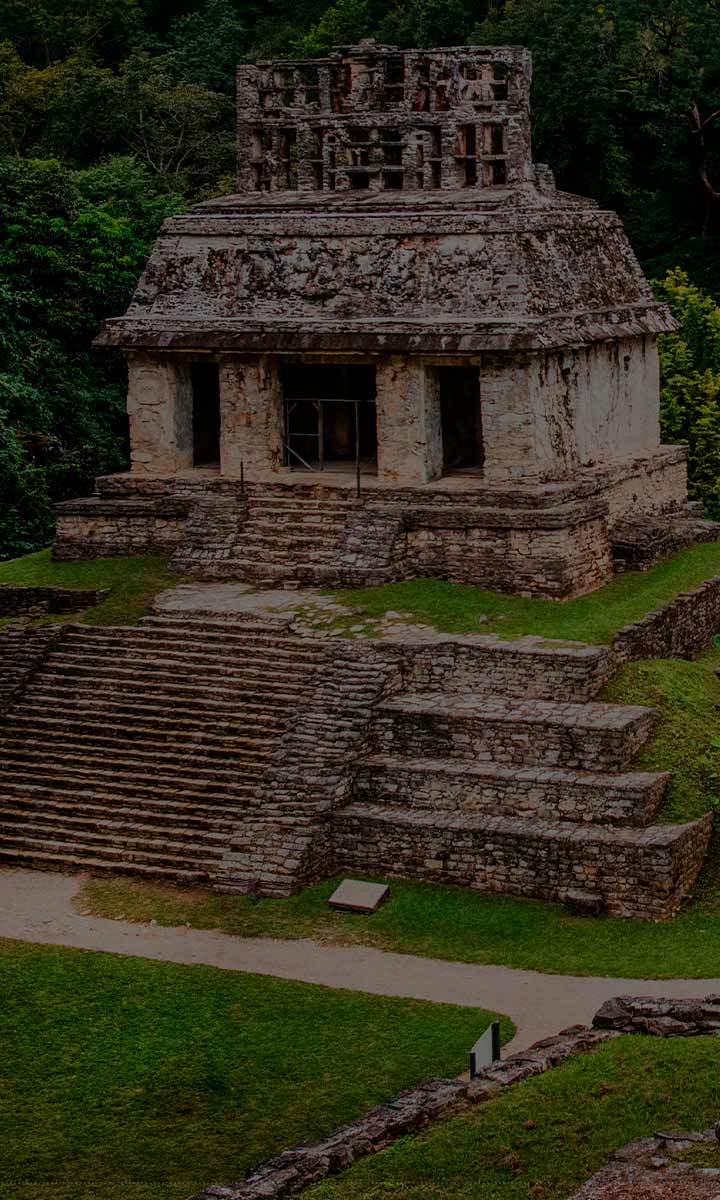
Spirit of freedom, conscience, mysticism and adventure
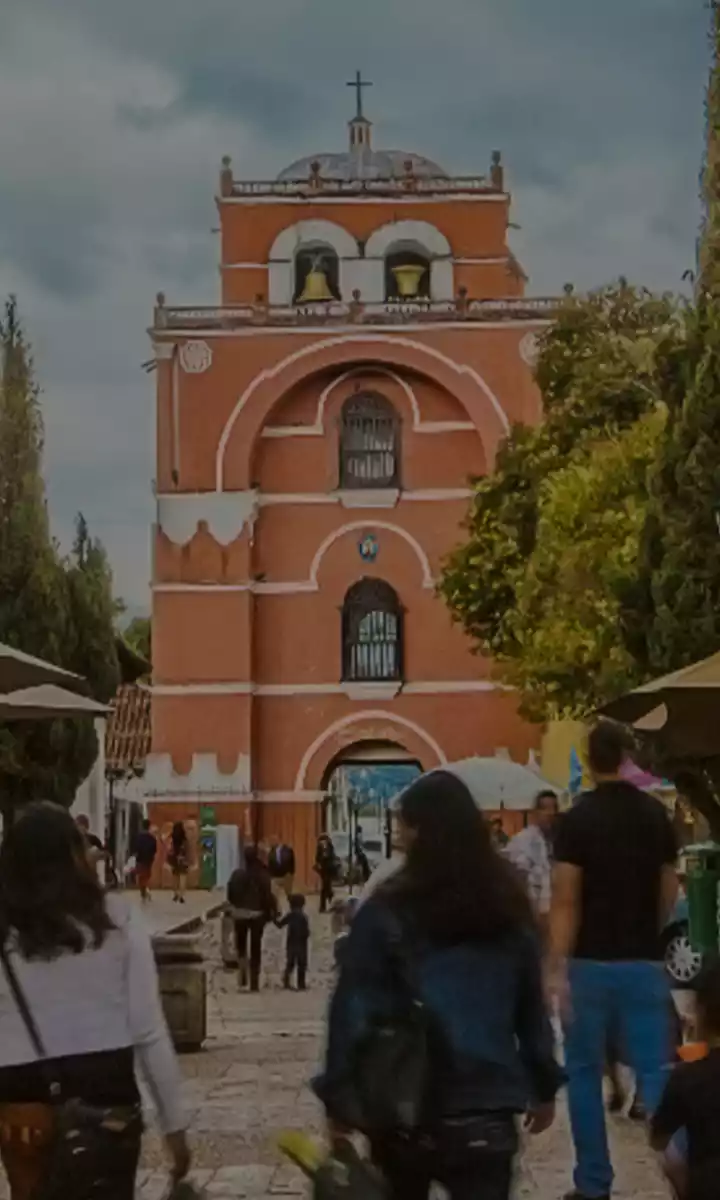
Main Destinations
Your journey begins in our most emblematic cities and ecotourism centers with all the services you need to explore Chiapas.

Tourist Routes
We have designed different routes for you that will take you through the most exciting places in Chiapas.
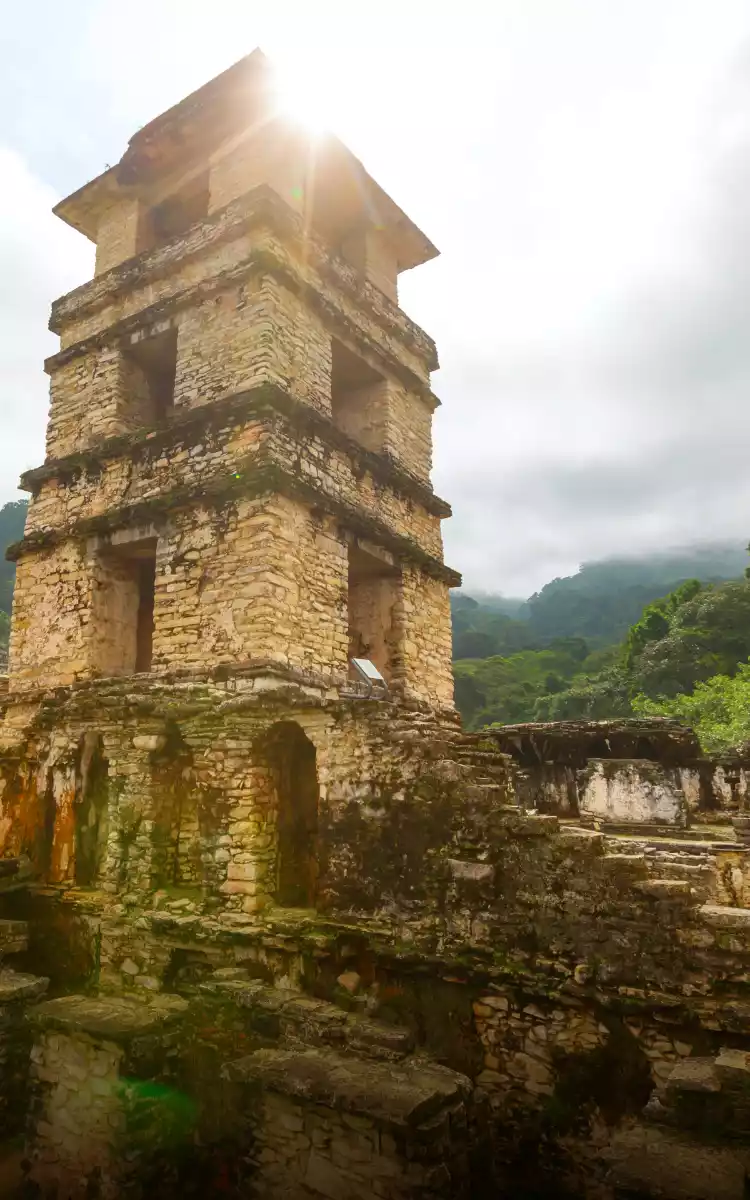
Travel Blog
Chiapas is a parade of colors, smells, flavors, traditions and culture. Find out through our blog.
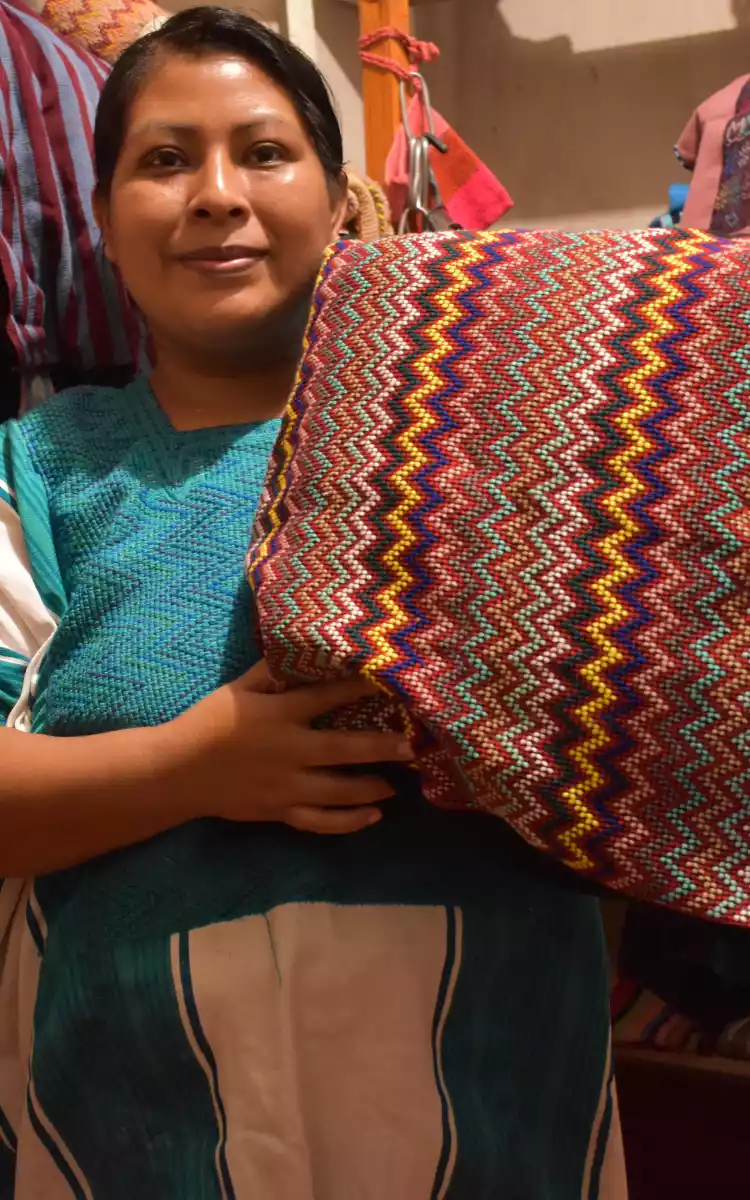
Chiapas Spirit
You will always find the best experience: unique, sensorial, fun.
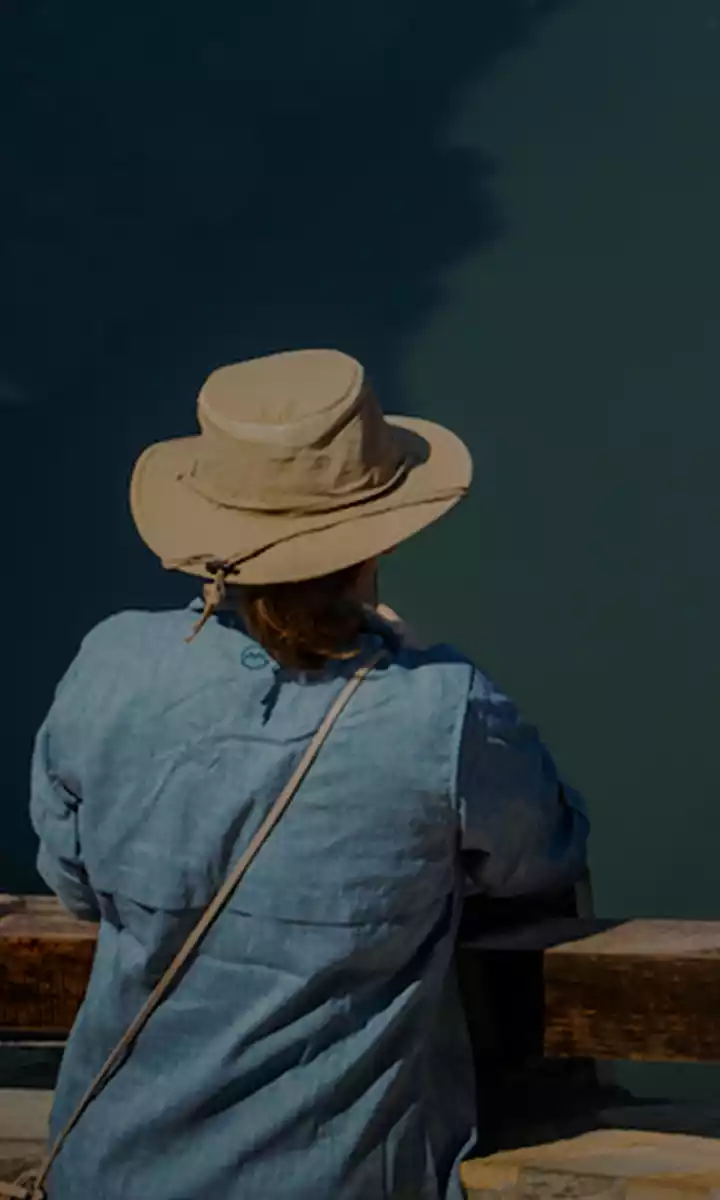
Find restaurants, travel agencies and all the service providers that will make your trip more comfortable.
Interactive Map
Visit the tourist destinations of Chiapas, hover over the illustrations on the map and click to learn more about the destination.

Chiapas Private Tours & Local Tour Guides
Discover things to do and plan a trip to chiapas, mexico with a local guide, popular chiapas tour guides.

Hi guys, it's Alex here! ✌️ For over 5 years, I and my colleagues have been organizing tours to some of the most incredible places in and around Mexico City. As a team of local guides, we aim to help travelers discover our beautiful city and its surroundings in the most interactive, authentic, and fun way. In our tours, we strive to do things differently: avoid tourist traps, go off-the-beaten paths, interact with locals, learn about their traditions, and connect with their core values. So, if you want wanna discover Mexico from a local perspective, and get to know its history, culture, gastronomy, and nature, consider hiring us as your guides. Be sure, we will make your experience in Mexico City unforgettable!
Chiapas private tour guide, mexico must read articles.
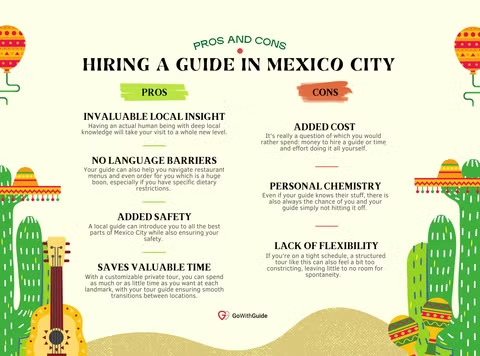
Hiring a Guide in Mexico City - Pros & Cons
Mexico City, Mexico
Mexico City is a huge metropolis known for its vibrant culture, rich cuisine, innovative art scene, theatrical wrestling matches - and so much more. With so much to see and even more to do, planning an itinerary can feel like a task of epic proportions...

5 Popular Destinations In Mexico With GoWithGuide's Private Tours
Mexico is one of those destinations that really offers something for everyone. whether you're a beach-goer or a history buff, a nature lover or a city slicker, this vibrant and beautiful country has an area that's sure to tickle your fancy. so, which p....

Why Hiring a Private Tour Guide in Mexico is Worth Every Peso
there’s always this perfect storm of thrilling excitement and feeling overwhelmed whenever you decide to travel to a new country. on one end, you just want to book your ticket and go, but genuine concerns about comfort, convenience, quality, and safety....

Tourism In Mexico Statistics 2023: All You Need To Know
thanks to its stunning beaches, rich history and incredible cuisine, mexico is a dream destination for many a traveler. with so much to see and do, it can feel overwhelming to plan your visit to mexico. we're here to help whether you're planning to ....

Tourism In Mexico City Statistics 2023: The Ultimate Guide
if mexico is a feast of electrifying culture, lavish history, and artistic flair, mexico city is the centerpiece, weaving all 31 states into a dense collection of stories waiting to be discovered. you probably can't wait to hop on a plane, touch down a....
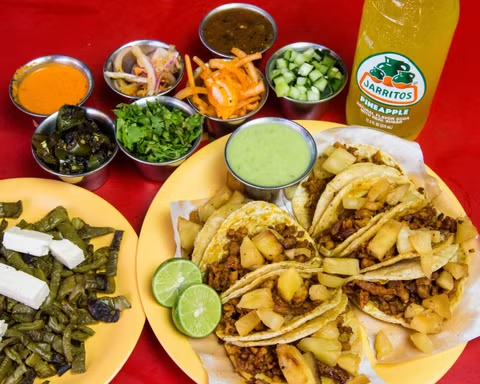
Top 8 Most Popular Foods In Mexico City
Foodies rejoice mexico city is a culinary paradise that's ready to delight you with rich flavors and fresh local ingredients. mexican food is routinely ranked as one of the most delicious in the world, so what better place to sample it than the country's....
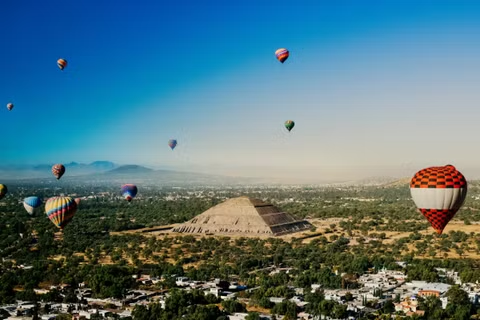
Travel Like A Celebrity - Luxury Tours In Mexico City
For travelers who appreciate the finer things in life, mexico city offers the full package. with its innovative art circuit, high-end shopping opportunities, and five-star hotels to die for - mexico city is the perfect destination for living it up in styl....
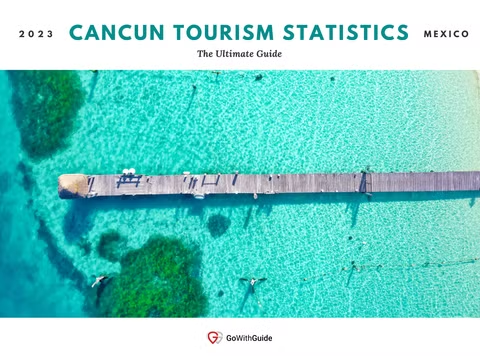
Tourism In Cancun Statistics 2023: The Ultimate Guide
Cancun, Mexico
Are you having fun right now? Seriously. I’m sure we can all agree that the most un-fun thing about planning a trip to Cancun is the part where you sift through millions of tabs looking for the information you need. Alarming stories and random resort r...
The best tours and activities.
With a real local of your choice
The option to personalize your tour
Just contact your favorite local
Only private tours!
So no group tours with strangers

Connect with a Chiapas Local Guide
Read reviews and chat with the best local tour guides in chiapas. get a free itinerary and plan your private tour today., book a customizable chiapas private tour, browse chiapas tour itineraries by our local professionals and book your favorite chiapas tour., related chiapas tour guide pages.
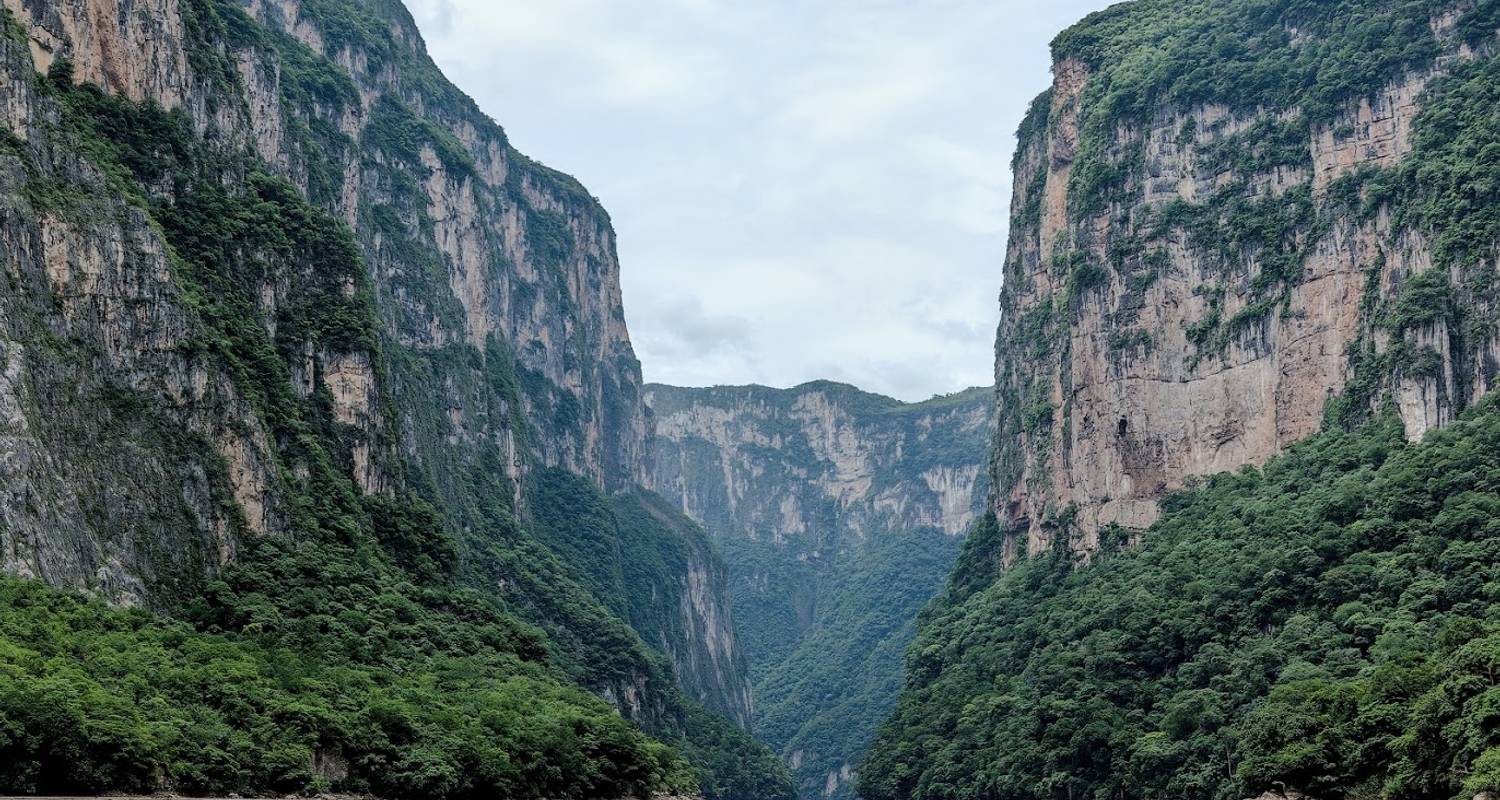
Chiapas Tours & Trips
- Choose from 21 Chiapas tours
- 5 verified reviews from TourRadar travelers
- 24/7 customer support
10 best Chiapas tour packages
Compiled by

Melissa Chiapas travel expert at TourRadar
Chiapas Experience
Chiapas explorer, the mayan trail, westbound edition, escape to paradise in the heart of chiapas, chiapas icons: a journey through history and nature, mexico - natural chiapas, palenque tour: explore wonderful chiapas and beauty waterfalls, san cristobal de las casas city break, private 8-day immersive cultural tour in chiapas with day trips, magic chiapas.
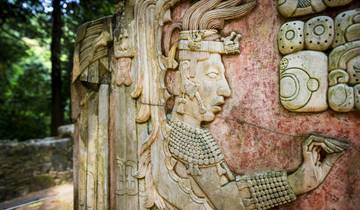
- In-depth Cultural
- Sightseeing
- Swim under Chiflón's waterfall
- Embark on a boat tour of Sumidero Canyon
- Tour the ancient Mayan temples of Palenque
“Wonderful experience of the lesser known parts of Mexico. I do wish we would have had time to wander Palenque on our own.”
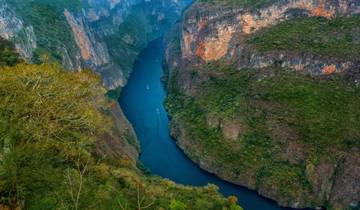
- Explore indigenous villages with a local guide
“Very good. I enjoy it very much.”

- Discover ancient Chichén Itzá and Mayan traditions
- Explore the pristine beaches of Puerto Morelos
- Snorkel at the vibrant Puerto Morelos Reef
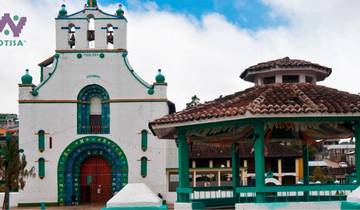
- Christmas & New Year
- Sail through the majestic Sumidero Canyon
- Visit the Olmec artifacts at La Venta Museum
- Swim near the stunning Agua Azul waterfalls

- Tour the ancient Mayan city of Palenque
- Visit Chamula and Zinacantán indigenous towns
- Explore the Lakes of Montebello region

- Visit indigenous Tzotzil communities
- Tour the Parque Museo de la Venta in Villahermosa
- Discover ancient ruins in Palenque and Yaxchilán

- Explore Sumidero Canyon by boat
- Experience a traditional Mayan temazcal
- Ride ATVs on Puerto Arista's beaches

- Transfer to Villahermosa Airport
- Swim at the turquoise Agua Azul waterfalls
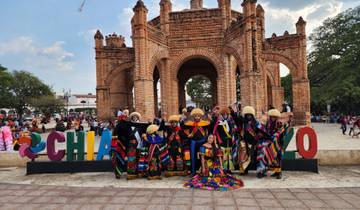
- Boat through the majestic Sumidero Canyon
- Explore indigenous customs in Zinacantán
- Discover the Mayan ruins of Palenque

- Swim in the refreshing Agua Azul waterfalls
Other Regions in Mexico
Discover TourRadar
Chiapas Tour: a Fascinating Trip from Mexico City to San Cristobal (9 Days)
Mexico Tours Chiapas Chiapas Tour: a Fascinating Trip from Mexico City to San Cristobal (9 Days)
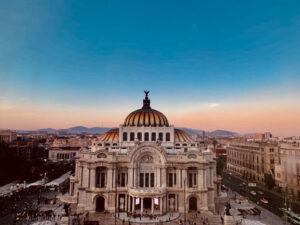
On the Chiapas Tour, discover the vibrant heart of Mexico! Begin in the sprawling metropolis of Mexico City, where ancient and modern coexist harmoniously. Explore UNESCO-listed historic sites, including Teotihuacan’s monumental pyramids, and soak up the city’s cultural richness. Venture to gorgeous Puebla with its colonial charm, and then delve into the Tehuacan-Cuicatlan Biosphere Reserve ‘s natural beauty. Oaxaca City’s cultural splendor awaits, along with the ancient ruins of Monte Alban and the spectacular landscapes of Hierve el Agua . Relax on Puerto Arista ‘s golden sands, cruise Sumidero Canyon ‘s dramatic cliffs, and explore Chiapa de Corzo’s colorful streets. Immerse yourself in the traditions of San Juan de Chamula and savor the loveliness of San Cristobal de las Casas . This tour is a feast of history, culture, and natural wonders!
- Explore huge Pyramids of the Sun and Moon in UNESCO-listed Teotihuacan.
- Have a swim and see the sunset in Hierve el Agua, a series of spectacularly sited mineral springs in Oaxaca.
- Take a boat trip in awe-inspiring Sumidero Canyon.
- Witness fascinating ancient rituals blended with modern Christianity in San Juan de Chamula.
- Fall in love with Chiapas, one of the most colorful and splendid states in Mexico.
How is this tour different?
Authentic how this tour provides an actual image of the destination, life, and practices of the host community..
We do our best to make our trips educative and fulfilling, in which travelers can interact with local populations, learn about their traditions, and culture, and connect with their core values.
A tour with impact ? How this tour positively affects the destination and local communities on economic, socio-cultural, and environmental dimensions.
We support the UN's Sustainable Development Goals. Our tours are aligned with SDG 8 and 12, focusing on empowering local communities and promoting sustainable consumption and production practices. We take tourists to underdeveloped regions, creating opportunities for economic growth while respecting local traditions and educating communities on sustainable approaches.
Other ? Other advantages this tour offers to travelers.
- Small groups of up to 12 travelers: closer communication, easier coordination, more adventures and fun!
- Off-the-beaten-track tours with maximum immersion in local nature, culture, and traditions.
- The easy-going atmosphere of our tours is perfect for informal travel and making new friends among co-travelers and locals.
Day 1: Mexico City
Bienvenidos a la Ciudad de Mexico – the largest city in Latin America where ancient and modern coexist in harmony. The city is a world-class cultural hub that offers a huge variety of museums, galleries, and architectural gems, along with bustling nightlife and diverse gastronomic culture. Arrive on Saturday or some days before and take your time to explore this diverse city before meeting your group and Tour Leader on Saturday evening: informational meeting, welcome dinner and optional get-together with the rest of the group.
- Transportation : walking
- Accommodation : conveniently located, locally-owned hotel/B&B in Mexico City
- Meals Included : dinner
- Activities Included : welcome meeting

Day 2: Mexico City
Join your Tour Leader and start the Chiapas Tour with a walking tour around the UNESCO-listed historic center of Mexico City and a visit to the National Museum of Anthropology. Then, choose by yourself what to do next – your Tour Leader will be happy to give suggestions. Optional dinner and get-together with the group in the evening.
- Transportation : walking, public transportation
- Accommodation : conveniently located, locally-owned hotel/B&B in Mexico City
- Meals Included : breakfast
- Activities Included : walking in of the Historic Center of Mexico City; guided visit to the National Museum of Anthropology
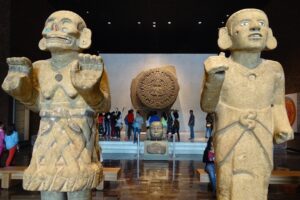
Day 3: Mexico City - Teotihuacan - Puebla
In the morning go to UNESCO-listed Teotihuacan , a fabulous archaeological zone that lies in a mountain-ringed offshoot of the Valle de México . The site of the huge Pyramids of the Sun and Moon, it was Mexico’s biggest ancient city and the capital of what was probably the country’s largest pre-Hispanic empire.
In the afternoon, after walking and lunch in Teotihuacan, continue our Chiapas Tour in Puebla. Once a bastion of conservatism and tradition, the city has come out of its colonial-era shell. Puebla retains a fantastically well-preserved center, a stunning cathedral, and a wealth of beautiful churches, while younger poblanos (people from Puebla ) are embracing the city’s increasingly thriving art and nightlife scenes. Optional dinner and get-together with the group in the evening.
- Accommodation : conveniently located, locally-owned hotel/B&B in Puebla
- Meals Included : breakfast, lunch
- Activities Included : guided visit to Teotihuacan Archeological Zone, walking tour in Puebla
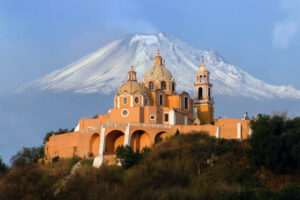
Day 4: Puebla - Tehuacan-Cuicatlan Biosphere Reserve - Oaxaca
After breakfast and checkout, go to Tehuacan-Cuicatlan Biosphere Reserve . Located in a complex system of mountain ranges and valleys, this UNESCO-listed area generates great biodiversity and different ecosystems. The region has played an important role in the development of agriculture in Mesoamerica . Exploration by car and walking.
In the afternoon, move to Oaxaca City . A cultural colossus that fits to rival anywhere in Latin America for history, gastronomy, and colorful manifestations of indigenous culture, Oaxaca is a complex but intensely attractive city whose majestic churches and refined plazas have deservedly earned a UNESCO World Heritage badge.
Optional dinner and get-together with the group in the evening.
- Accommodation : conveniently located, locally-owned hotel/B&B in Oaxaca
- Activities Included : guided visit to Tehuacan-Cuicatlan Biosphere Reserve, walking tour in Oaxaca
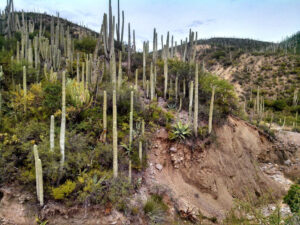
Day 5: Oaxaca - Monte Alban - Hierve el Agua - Mitla
In the morning, go to Monte Alban . Now an illustrious ruin, this former capital of the Zapotec empire served as the second-largest ceremonial site in Mesoamerica after Teotihuacan for over a thousand years. Thereafter, you’ll move to Hierve el Agua. The location for some of the Top posts on Instagram, this series of spectacularly sited mineral springs is a great place to enjoy the impressive landscapes and sunsets.
Afterward, transfer to the nearby Magical Town of Mitla . Orientation walk of the historic center, check-in, optional dinner, and get-together with the group in one of the local restaurants.
- Accommodation : conveniently located, locally-owned hotel/B&B/guest house near Hierve el Agua
- Activities Included : guided visits to Monte Alban Archeological Zone and Hierve el Agua; orientation walk of Mitla
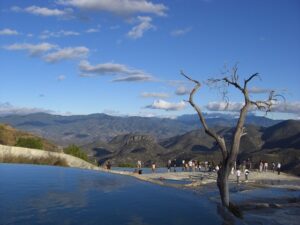
Day 6: Mitla - Puerto Arista
In the morning, move to Puerto Arista, a quiet regional beach town famous for its extensive golden-sand beaches. Once there, ride an ATV and enjoy the stunning sunset on the beach. Finally, join an optional dinner and get-together with your group in one of the local restaurants.
- Transportation : private vehicle
- Accommodation : conveniently located, locally-owned hotel/B&B/guest house in Puerto Arista
- Activities Included : ATV ride on the beach in Puerto Arista
Day 7: Puerto Arista - Sumidero Canyon - Chiapa de Corzo
Enjoy the sea and sun in the morning and immerse yourself in the awe-inspiring Sumidero Canyon on a boat trip to enjoy the sight of impressive waterfalls. Enter mystical caves and see the cliff where Chiapanec Warriors committed suicide instead of being forced to surrender to the Spanish Conquistadores. After that, head to Chiapa de Corzo , one of the most beautiful towns in Chiapas, well known for its warm people and colorful Renaissance architecture. In January, you can enjoy the Fiesta Grande, one of the most attractive events in the country, declared a UNESCO Intangible Heritage. Accommodation, orientation walk in a historic center, optional dinner, and get-together with the group.
- Accommodation : conveniently located, locally-owned hotel/B&B/guest house in Chiapa de Corzo
- Activities Included : boat tour in Sumidero Canyon; walking tour in Chiapa de Corzo
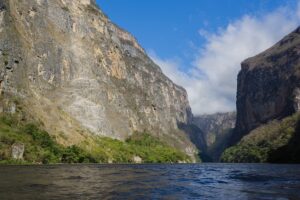
Day 8: Chiapa de Corzo – San Juan de Chamula – San Cristobal de las Casas
In the morning, move for an orientation walk and optional lunch to San Juan de Chamula , the center of the strongly independent Tzotzil ethnic group famous for their unique religious practices. In the evening, arrive at San Cristobal de las Casas. Set in a gorgeous highland valley surrounded by pine forests, this beautiful colonial city has been a popular travelers’ destination for decades. Check-in, orientation walk, optional dinner, and get-together with the group in the evening.
- Accommodation : conveniently located, locally-owned hotel/B&B/guest house in San Cristobal de las Casas
- Activities Included : orientation walks in San Juan de Chamula and San Cristobal de las Casas
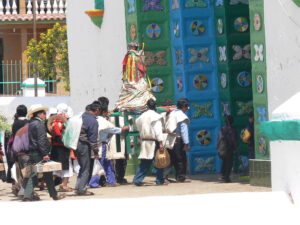
Day 9: San Cristóbal de las Casas - Tuxtla Gutierrez
Last day of our tour. After breakfast, get transferred to a local bus station and take a comfortable intercity bus to Tuxtla Gutierrez (1 hour 15 min approx). Once there, explore some of the city’s attractions or take a taxi directly to the Tuxtla Gutierrez International Airport (~30-40 min).
- Transportation : private transfer to the bus station in San Cristóbal de las Casas, intercity bus from San Cristóbal de las Casas to Tuxtla Gutierrez
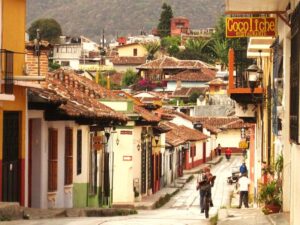
- This tour is private : only your group will participate.
- The price per person is variable and depends on the size of your group (please choose the number of participants in the booking calendar ➡️ to see the final price).
Local Expert Guides
English/Spanish Tour Leader service
Accommodation
8x nights in conveniently located hotels/B&Bs
Transportation
Transportation in a private vehicle throughout the tour (except for Day 9: intercity bus)
8x breakfasts, 1x lunch, 1x dinner
Walking Tours and Orientation Walks: Mexico City, Puebla, Oaxaca, Mitla, Chiapa de Corzo, Puerto Arista, San Juan de Chamula, San Cristobal de las Casas History and Culture Experiences: guided visits to the National Anthropology Museum (Mexico City); 2x archeological zones – Teotihuacan, Monte Alban Nature Experiences: Tehuacan-Cuicatlan Biosphere Reserve (hiking); Canyon Sumidero (boat tour); Hierve el Agua Gastronomic Experiences: guided visit to the artisanal mezcal factory with tastings Other activities: ATV ride in Puerto Arista
Personal expenses
Flights are not included: check our partner deals .
Travel insurance is not included: find insurance tailored for you.
Cancellations
Most of our 1-day tours can be canceled up to 48 hours prior to the departure.
Please see our Cancellation Policy for more info.

Frequently Asked Questions:
How to book.
To reserve the tour, please choose the date and complete the booking form. Once finished, you will receive a booking confirmation in your email.
How can I contact the tour organizer?
You can find the contact phone number and email of the tour organizer in the confirmation email.
Can I talk to someone?
Except for the information on this page, you can see full terms & conditions from each tour organizer before completing your booking.
About Vibe Adventures
Unless expressly stated otherwise, the tour and activity providers (“Organizers”) listed on vibeadventures.com are independent third parties and are not agents or affiliates of Vibe Adventures. Therefore, Vibe Adventures shall not be held liable for any injuries, sickness, accidents, delays, neglect, fraud, poor weather conditions, negative consequences, or expenses arising from or associated with the Organizers, their tours and activities, or those of their affiliates. If the tour does not include insurance, the travelers are responsible for obtaining travel insurance, as well as passports, appropriate visas, and necessary vaccinations.
Cancellations & Modifications
To cancel or modify your booking, please contact the Organizer directly using the email or phone number provided in the booking confirmation. Cancellations and modifications are subject to availability and the approval of the Organizer in accordance with their booking terms and conditions, which are made available to you during the booking process.
If you have any other questions please contact us .
Related tours
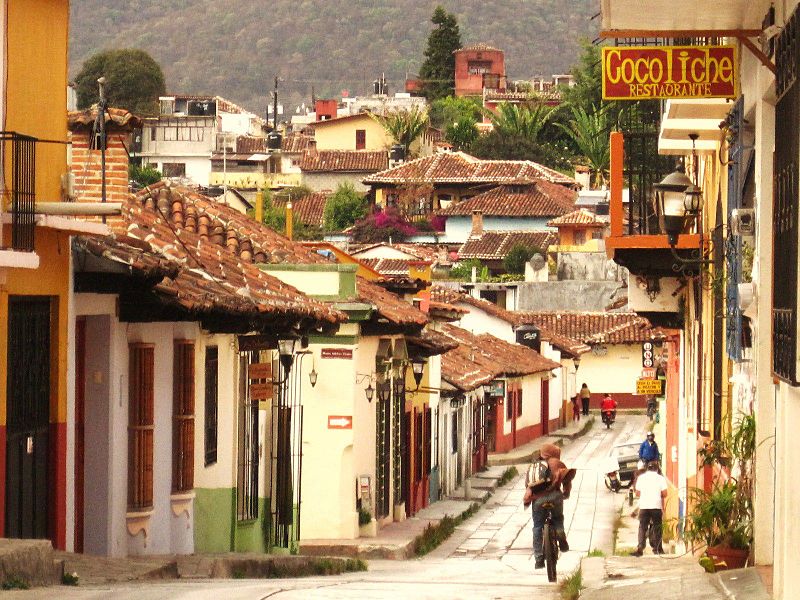
Nevado de Toluca Hike: Volcano Hiking Tour and Temazcal (12 h)
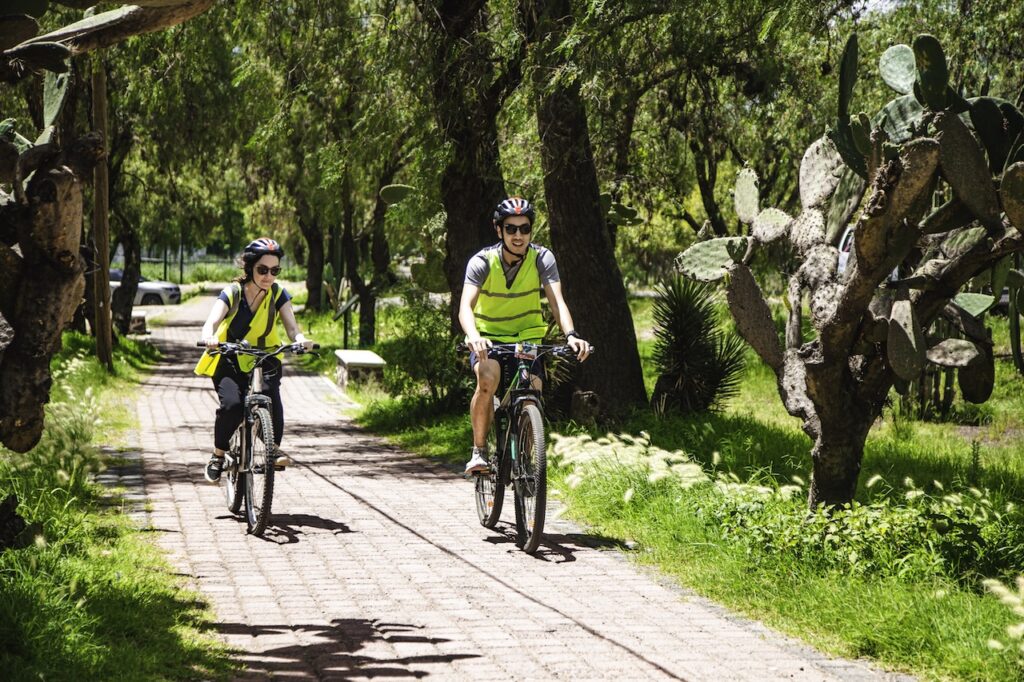
Bike Tour Teotihuacan: History, Culture and Pulque Tasting (8 h)

Chocolate Tour Mexico City: Mexican Coffee, Chocolate and Desserts (4 h)
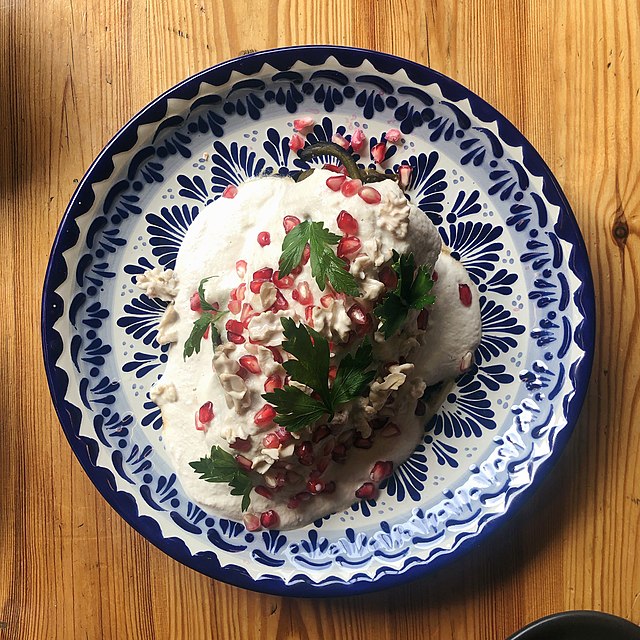
Cooking Class Mexico: Culinary and Cultural Tour to Puebla (12 h)
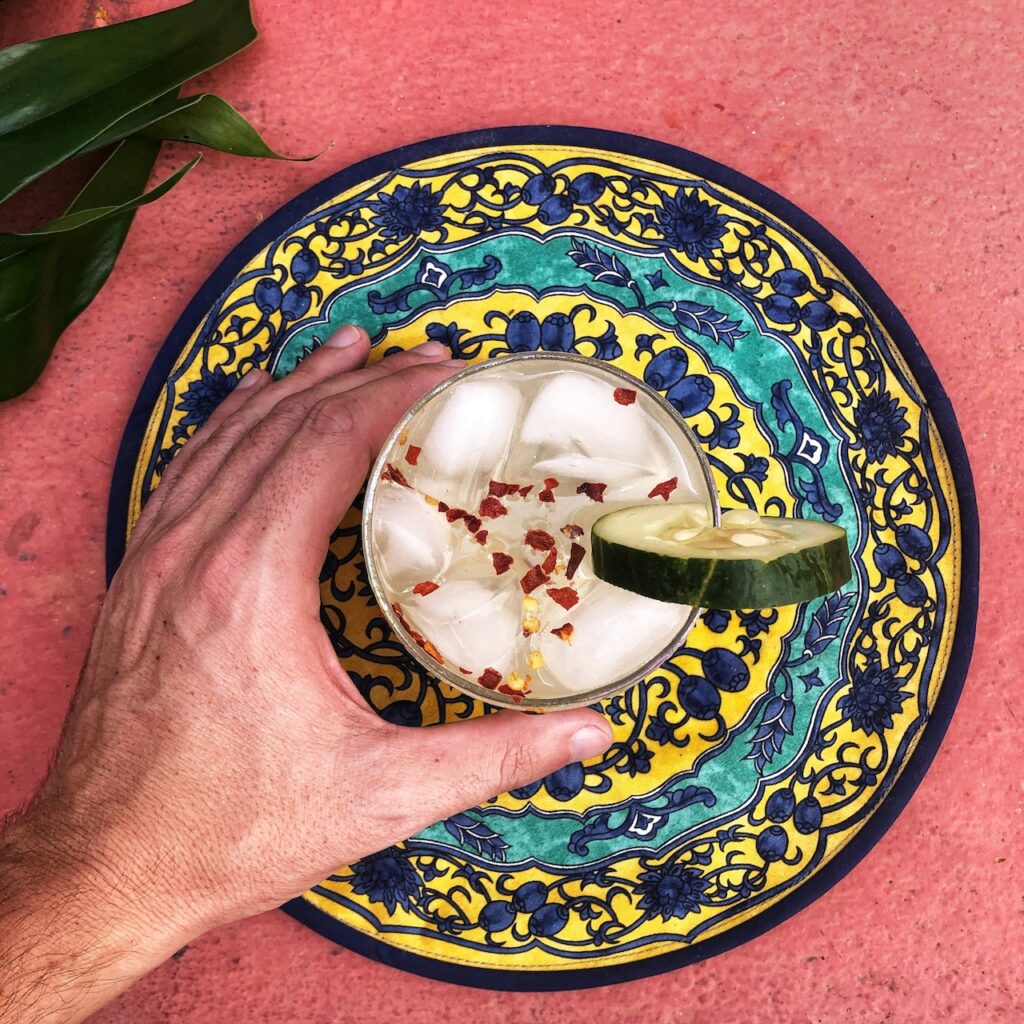
Mezcal Tour Mexico: Discover Atlixco, Local Food and Beverages (12 h)
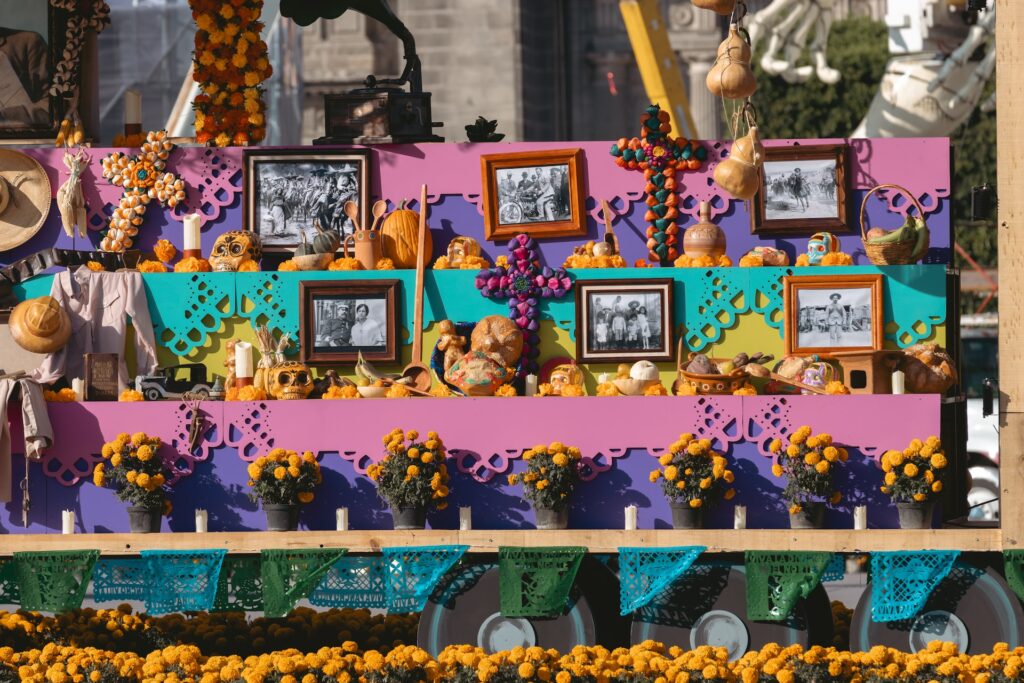
Day of the Dead Tour: Cultural Heritage of Humanity in Ocotopec (12 h)
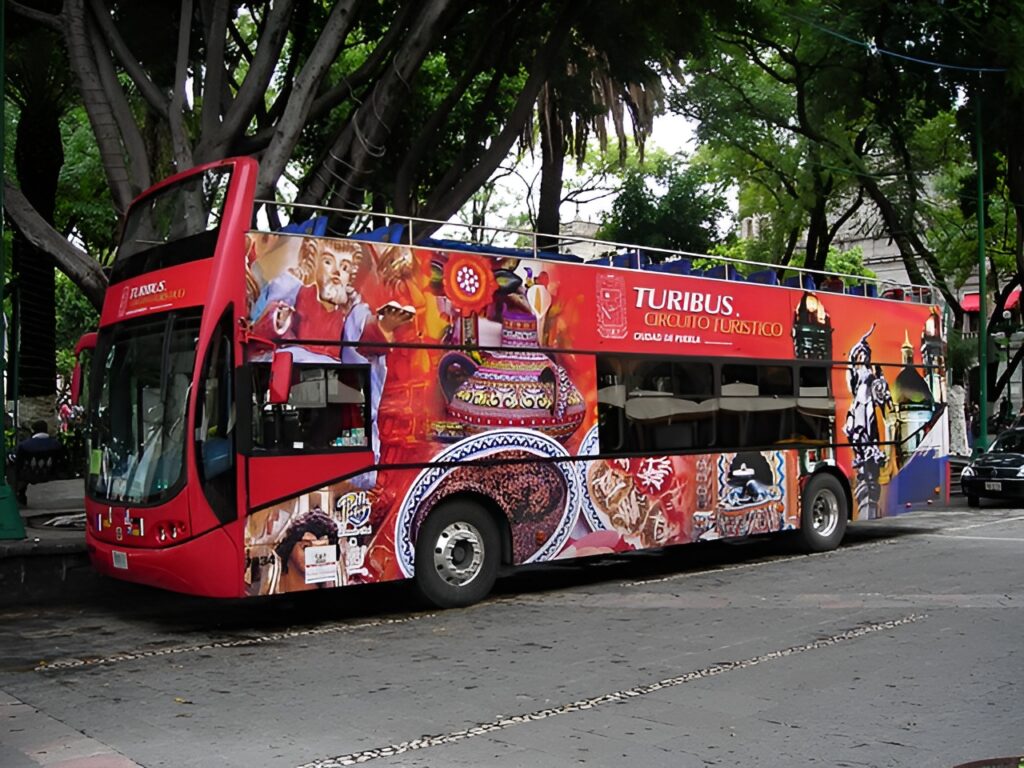
Bus Tour Mexico City: See All Major Landmarks In One Day (9 h)
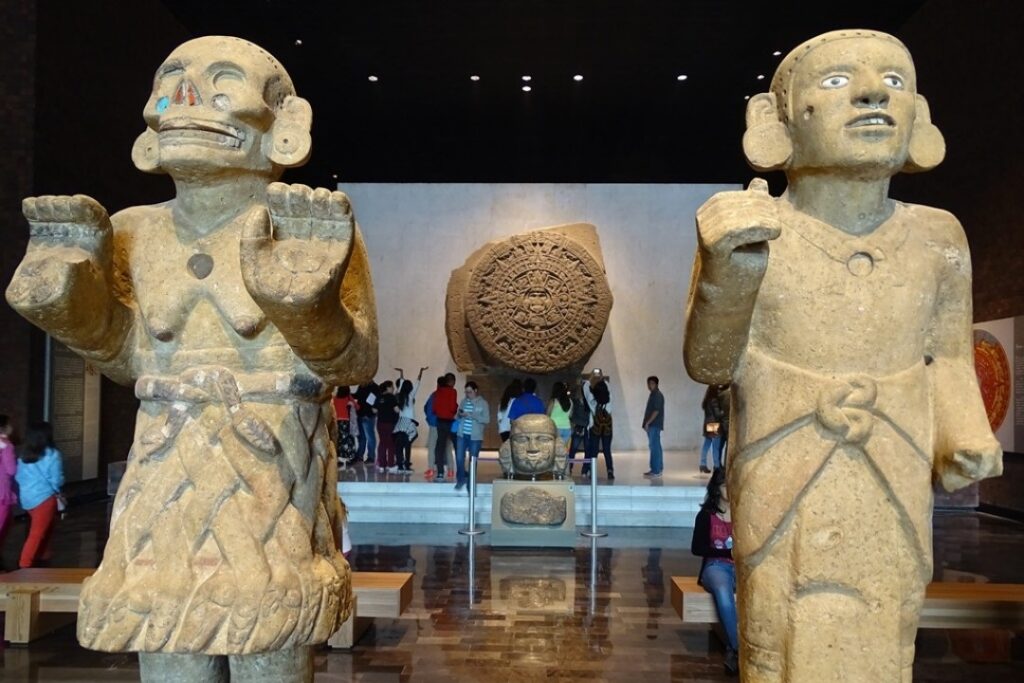
Guided Tour Mexico City: Learn All About Mesoamerica to Metropolis (7 h)
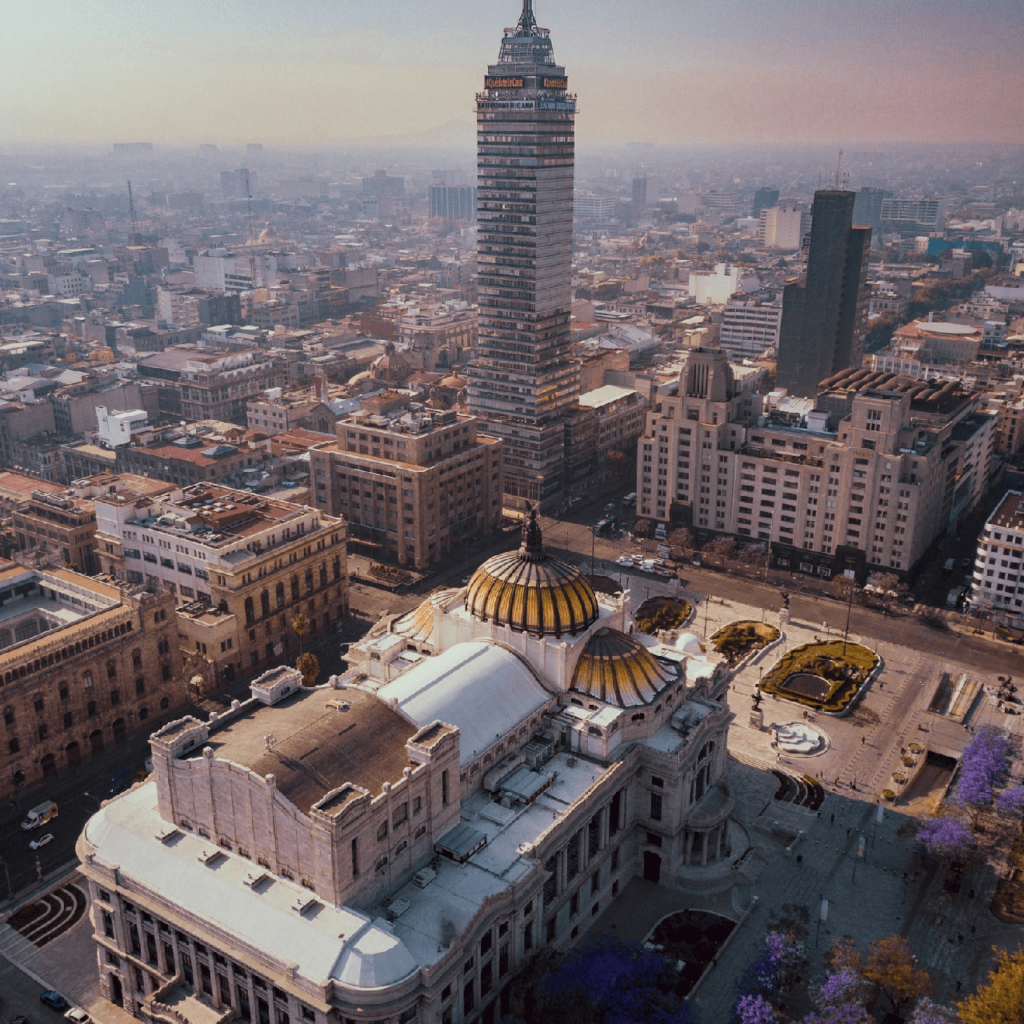
Mexico City Day Tour: History, Tastings and Stunning Views (4 H)
See all Chiapas tours
Get 5% off this tour with "Back2Travel" promo code or check similar tours 🌎 Keep safe & travel soon!
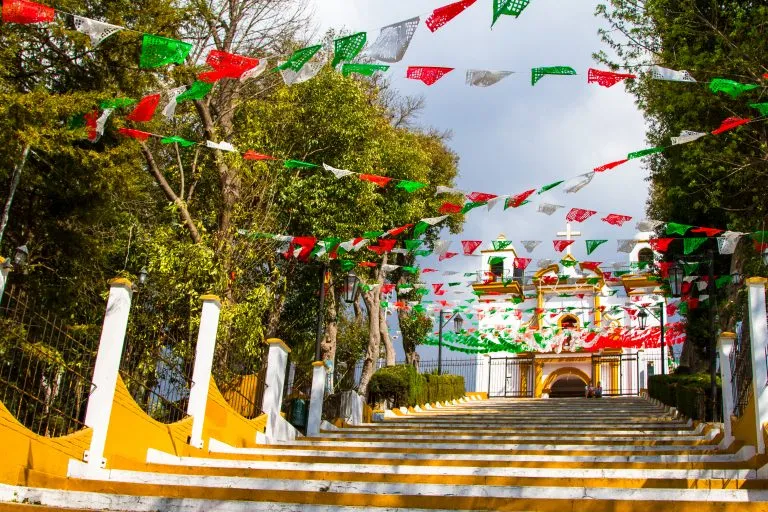
11 Cool Things to Do in Chiapas, Mexico
There were a lot of things that we were expecting from the southern Mexican state of Chiapas: fun things to do, low prices, a colorful city in San Cristobal, and mountain views.
What we weren’t expecting was to discover a destination that appears to be designed for outdoor lovers like us.
If you love waterfalls, wildlife, and bargains, here are are the best things to do in Chiapas–and why you need to visit immediately!
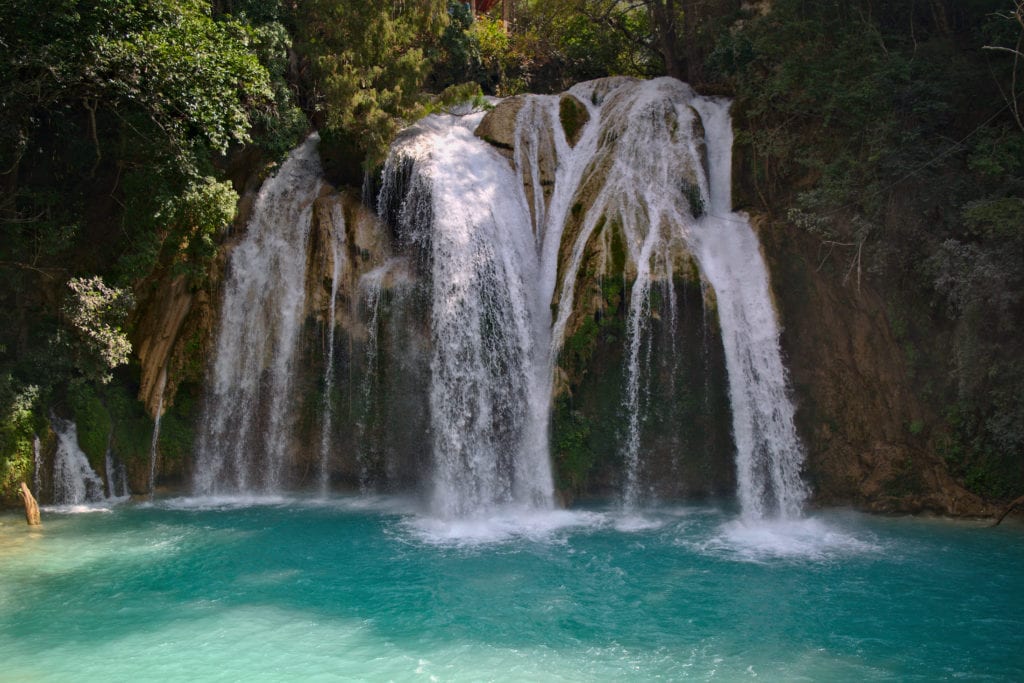
Some links in this post may be affiliate links. If you make a purchase through one of these links, we may earn a small commission at no extra cost to you. Please see our disclosure policy for more detail.
The Best Things to Do in Chiapas
Stare in wonder at el chiflon..
Rainbow Falls at El Chiflon became our new favorite waterfall the second that we laid eyes on it.
Enormous and cascading into a beautiful turquoise pool, one of our favorite aspects of the Rainbow Falls is that rather than falling in one giant bucket of water, it falls along the cliff it runs over–the effect is beautiful.
Some of the smaller waterfalls at the park were also beautiful, and reminded me forcibly of the Plitvice Lakes in Croatia.
Hike to El Chilfon and don’t want to head back down?
Don’t worry: as long as you didn’t go up the “wrong” (left) side like us, you can zipline most of the way back down!
Our wrong turn worked to our benefit, however–looking at where the viewing platform is on the opposite side of the waterfall, I think that we got the better view.
When we head back to this area at some point in the future, visiting El Chilfon again will be one of our first things to do in Chiapas, Mexico.
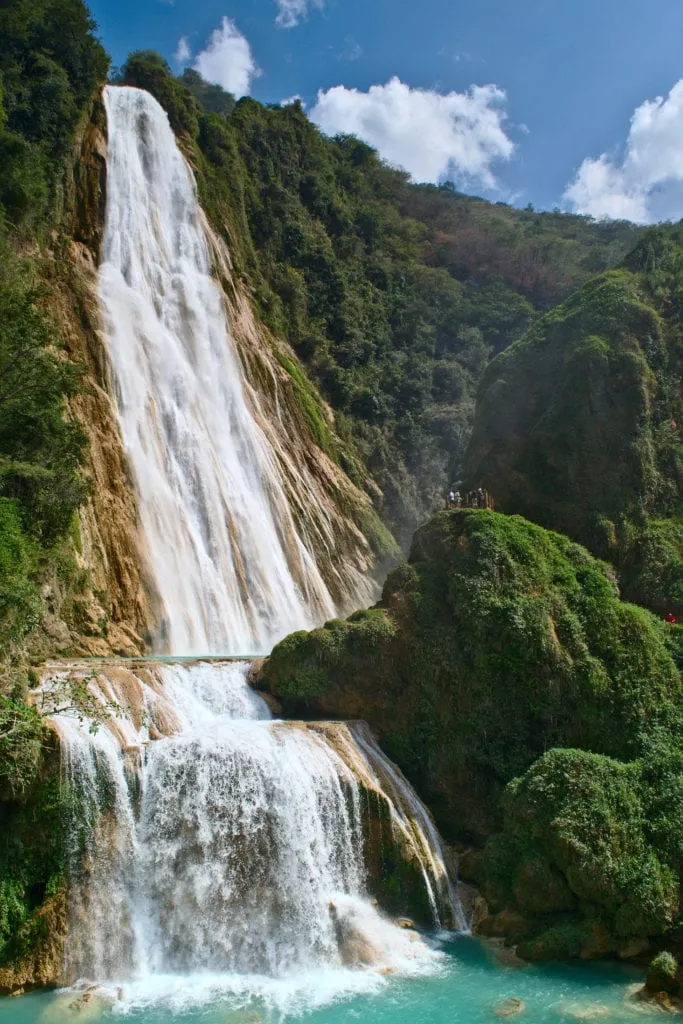
Enjoy the beauty of the Lagos de Montebello.
I never expected to find a view that reminded me of the karst cliffs of Thailand while in Mexico–but the Lagos de Montebello fit the bill.
These lakes are said to often be covered in mist, which held true for when we visited, but they were still beautiful (even if we didn’t feel up for the kayaking, which is one of the most popular Chiapas travel experiences there).
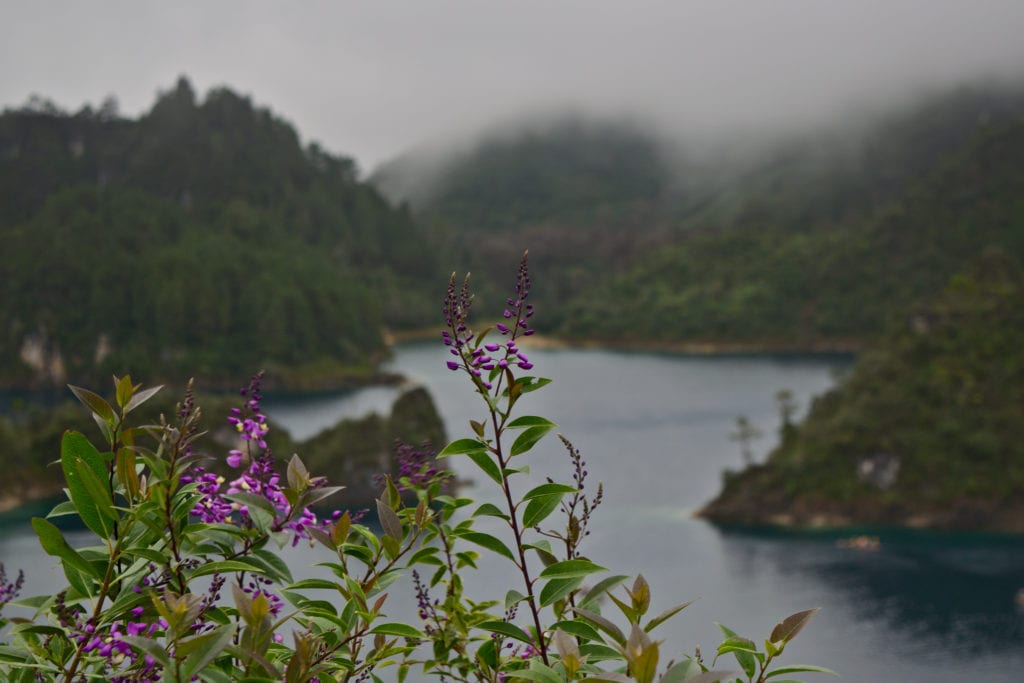
Go horseback riding in the countryside.
I have always loved to ride horses and took several years of lessons as a teenager, and Chiapas is the perfect place to explore on horseback.
Our three-hour tour took us through farmland, forest, and small villages–and most notably, the Templo de San Juan (more on that below).
Both a plus and a minus: the guides were very hands-off, and let us essentially do what we want, including trotting and cantering at will.
As an experienced rider, I adored the experience, but as many of our group members had never been on a horse before, I also found it fairly risky.
Make sure that you stay safe and know your own limits because you’ll need to set them yourself.
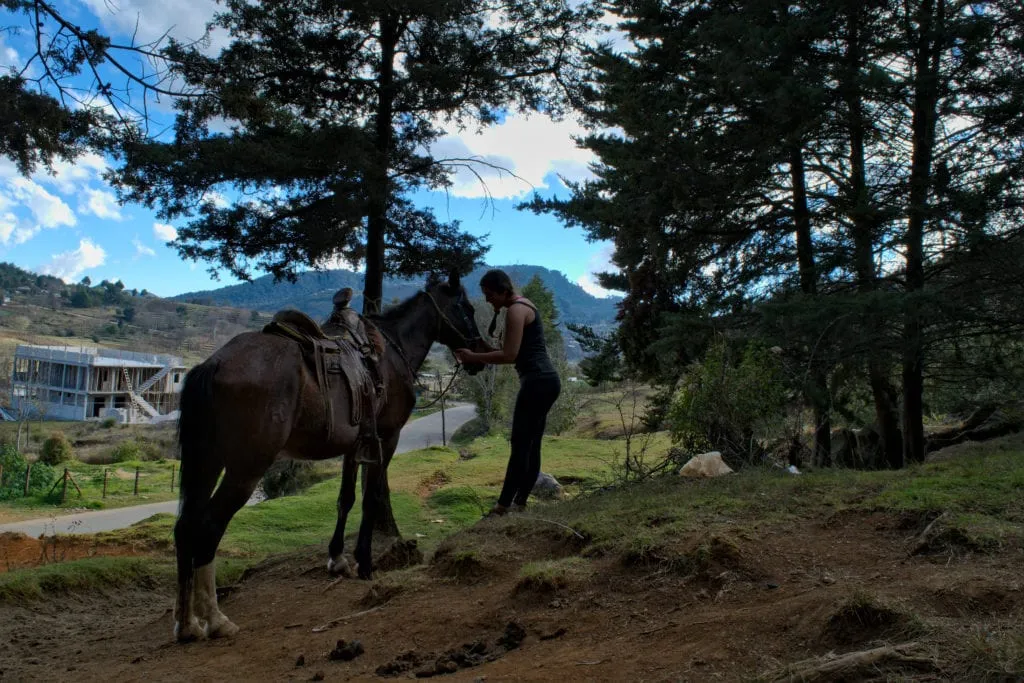
Visit the unforgettable Templo de San Juan.
Enormous amounts of incense. Chanting in a language that was not Spanish or Latin (it’s Tzotzil, the local indigenous language).
No pews. Straw all over the floor.
Hundreds of candles burning directly onto the ground, no candle holders in sight. A chicken in a box, waiting to be sacrificed at the end of a ritual.
No priests. Very few crucifixes. Plenty of statues of saints. One small Jesus statue off to the side of the altar.
Is this a Catholic church?
That’s what the Templo de San Juan, considers itself, but it is, without a doubt, the most unique house of worship that I’ve ever entered.
The church, which is located in the village of Chamula, strictly bans all photography inside and was vehement about enforcing it–and yet I have never wanted to take photos so badly in my life.
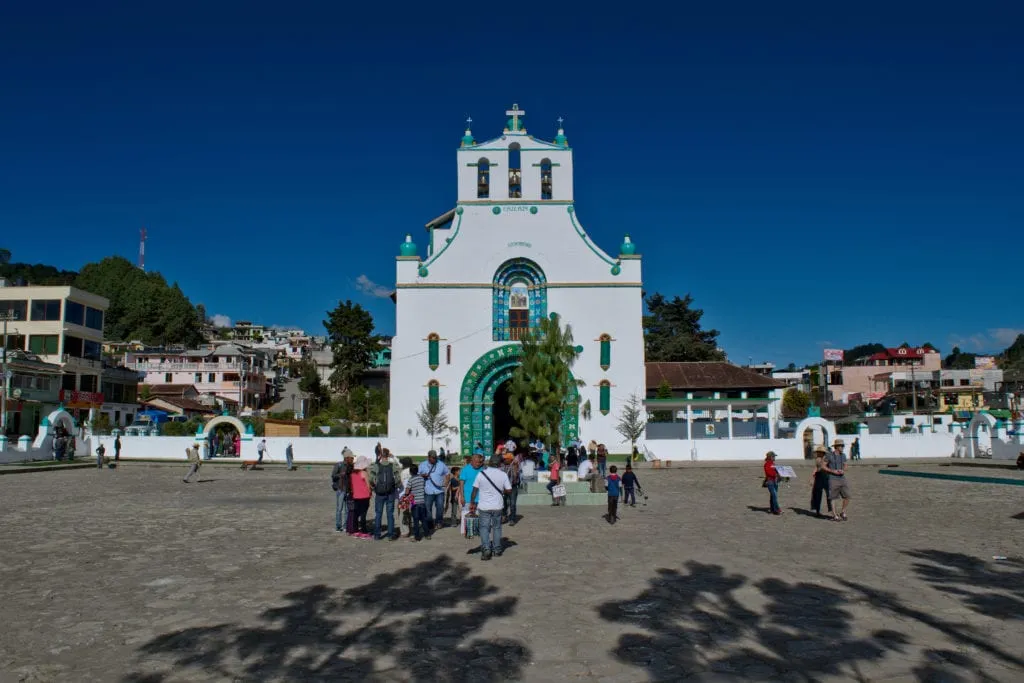
Climb the ruins of Palenque.
Not all of the incredible ruins in Mexico are available to climb anymore, including the famous pyramids at Chichen Itza.
That is for the best– Angkor Wat is a great example of a world-class site that is being damaged by its numerous visitors.
That being said… it’s still incredibly fun to climb ruins, and when you find sites (usually lesser-known ones) that let you scramble over them, it’s a blast.
Palenque is a perfect example of this–the best views of the city are from sitting on top of some of its buildings.
Admiring this view was one of our favorite things to do in Chiapas!
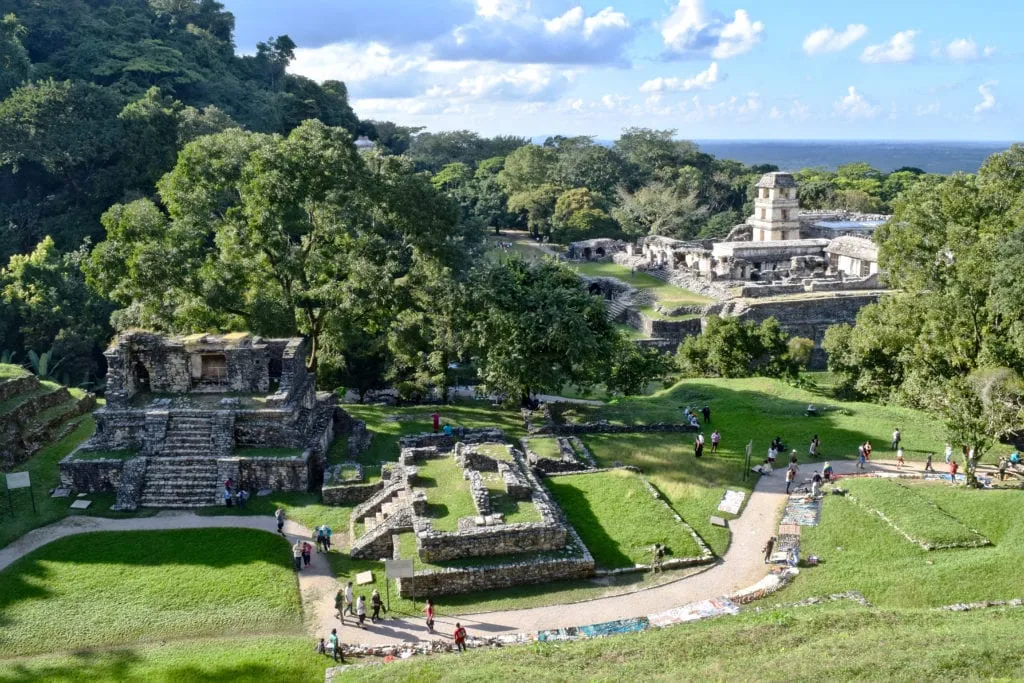
Discover the colors of San Cristobal.
It’s easy to overlook the city of San Cristobal in all of the nature that surrounds it, but there are plenty of things to do in San Cristobal , and the city itself is also worthy of some attention.
San Cristobal makes a perfect base for travelerss visiting Chiapas, Mexico.
The city is reasonably priced has plenty of transportation and tourism companies available to arrange excursions, there are tons of food and dining options.
This is where ee had our first Pad Thai since Asia–definitely not as good as on Koh Tao, but still great!
Most strikingly, San Cristobal de las Casas is so colorful , making it a joy to explore.
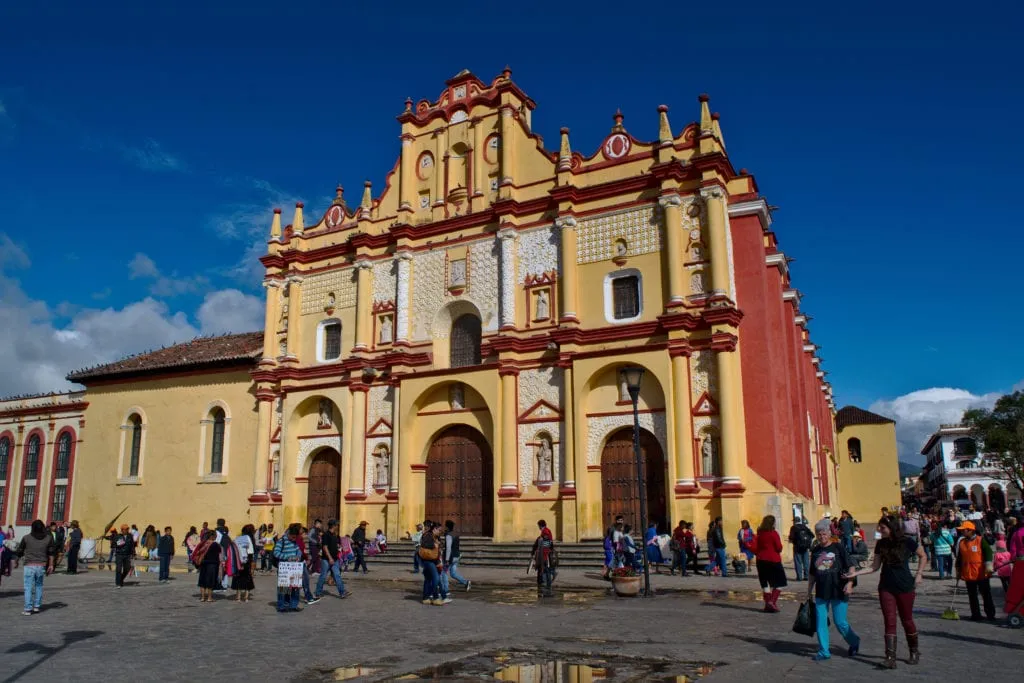
Climb behind beautiful Misol-Ha.
Sitting at the base of Misol-Ha is like sitting at the bottom of a cavern: there’s so much beauty above you.
Want to explore an actual cave?
For 10 pesos, you can explore the cave situated behind Misol-Ha–just be prepared to get very wet on your way there!
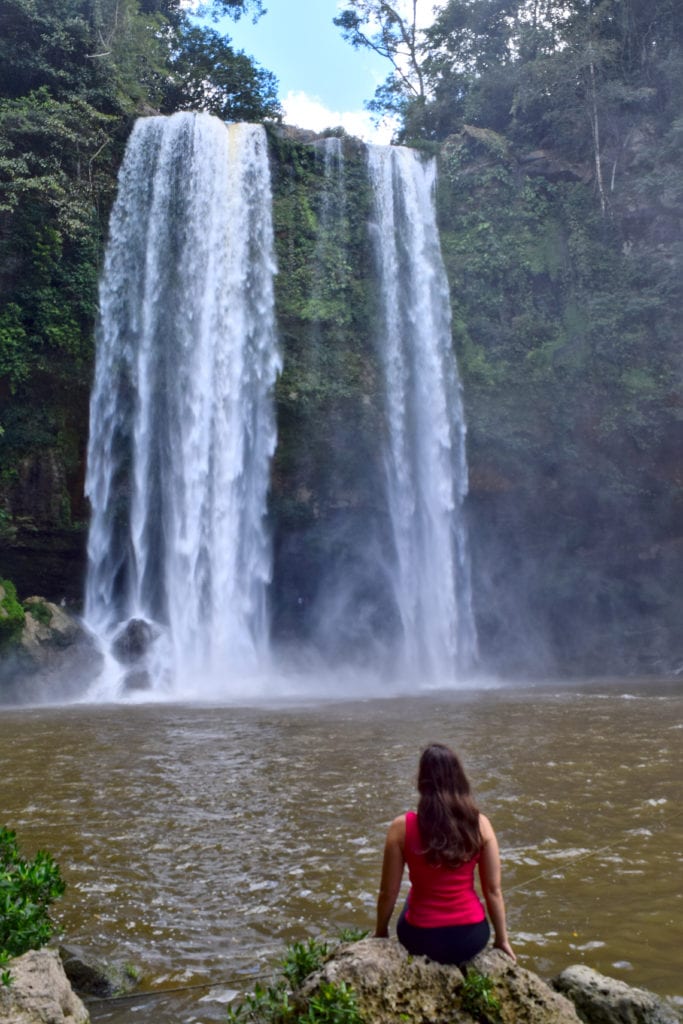
Take a boat ride through Sumidero Canyon.
I love canyons–they’re a great reminder of how enormous the Earth really is.
The walls of Sumidero Canyon reach over a kilometer high in some points, and there’s nothing more relaxing than enjoying a slow boat ride through it.
… As long as you’re not scared of alligators, that is!
We spotted a couple of adults and one baby sunning themselves during our cruise through the most famous canyon in Chiapas.
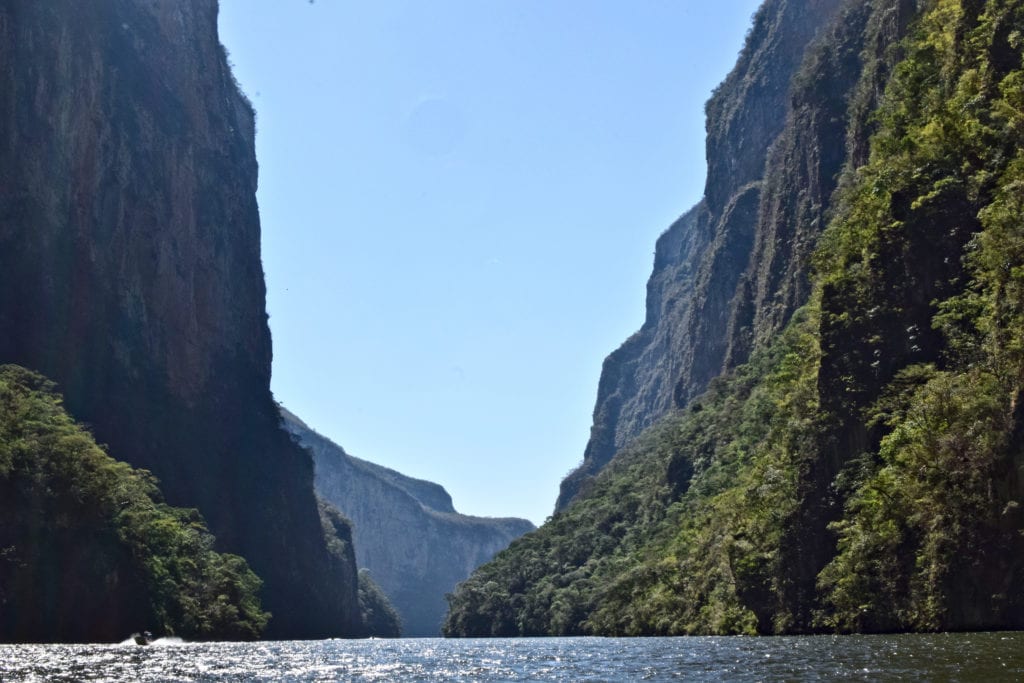
Get underground at the Grutas de Rancho Nuevo.
This striking cavern is beautiful enough for the first 350 meters–but if you want to have an unforgettable (if potentially terrifying) adventure, you can continue into the cave further than the light will follow you.
That’s right: armed with a flashlight and helmet, you can continue a bit further into the cavern to experience absolute darkness.
If you’ve never experienced the absolute complete darkness that a cave offers before, it’s definitely a memorable experience!
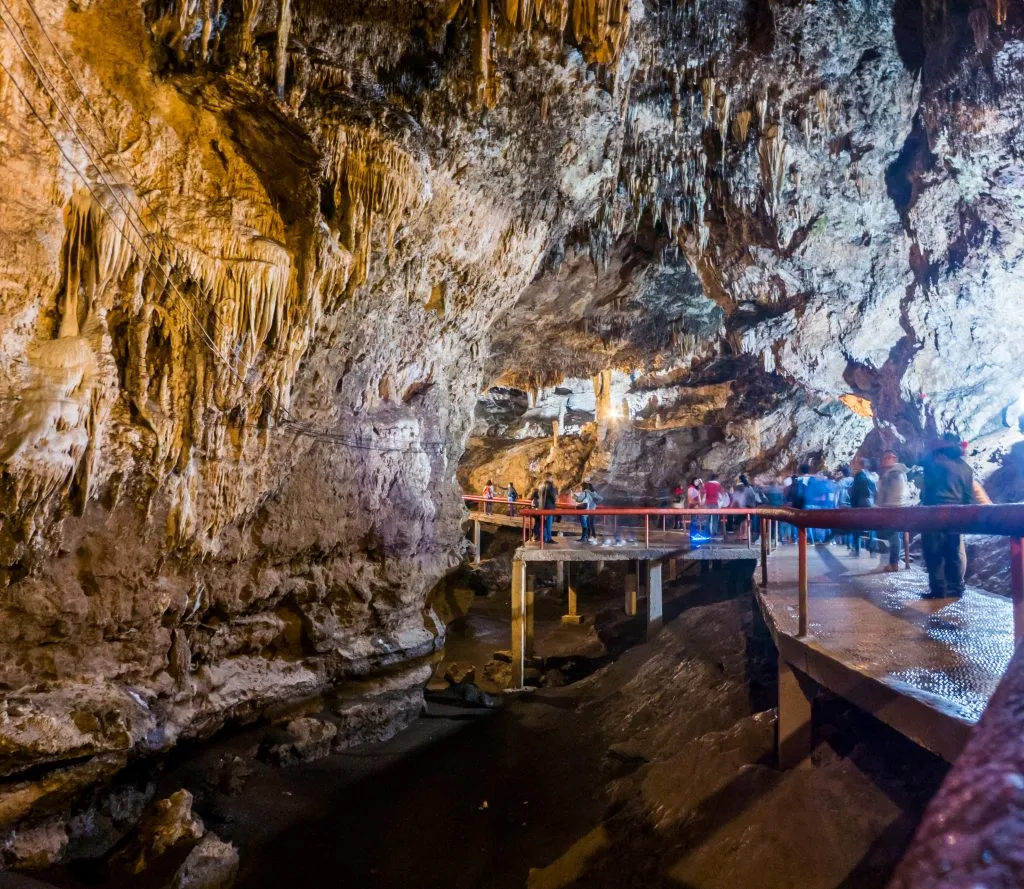
Visit El Arcotete Eco Park.
Whether you want to explore caves, try your hand at ziplining, or even go rock climbing or rappelling, you can find it at El Arcotete Eco Park, which is located an easy 15-20 minute ride from San Cristobal.
Go swimming at Agua Azul.
Just like the smaller waterfalls at El Chiflon, Agua Azul gave me Croatia flashbacks–this time to Krka National Park , complete with the option to swim at the bottom of the falls.
Keep in mind that you can’t swim just anywhere: some areas are much more dangerous than others, so be sure to follow the signs!
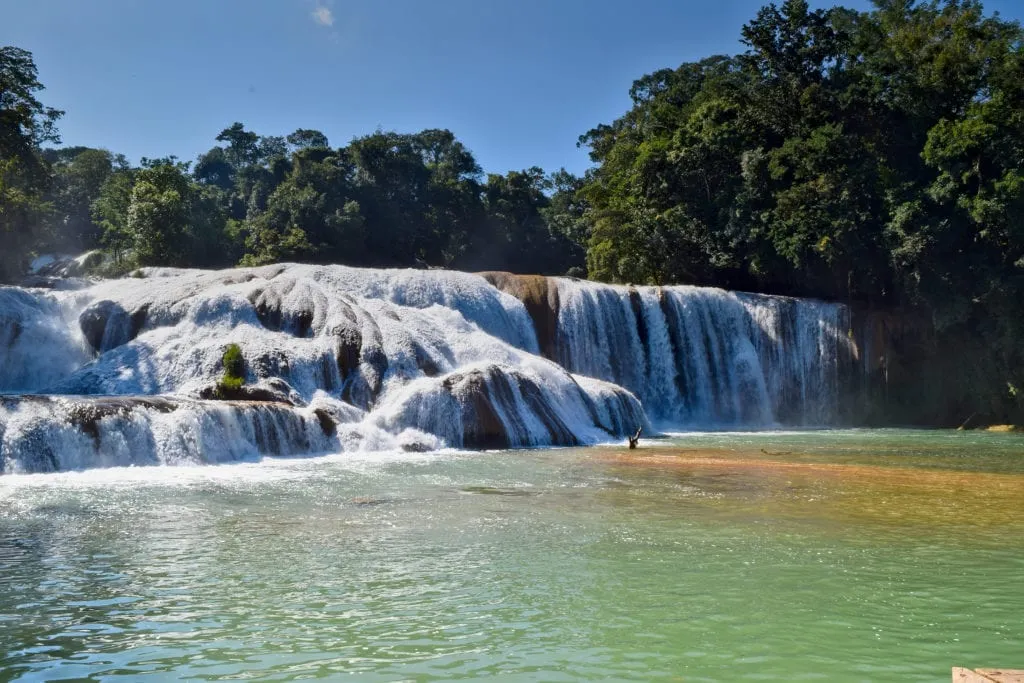
How much does it cost to visit Chiapas, Mexico?
Chiapas is one of the most affordable states in Mexico for travelers hoping to backpack Mexico on a budget .
Three-hour horseback riding tour? $10 USD.
A full-day trip to El Chiflon and Lagos de Montebello, including entrance fees? $16 USD.
Tour of the Sumidero Canyon, including transportation there and back? $15 USD.
The prices here are so low that with a moderate budget, you can easily do an excursion a day without breaking a sweat.
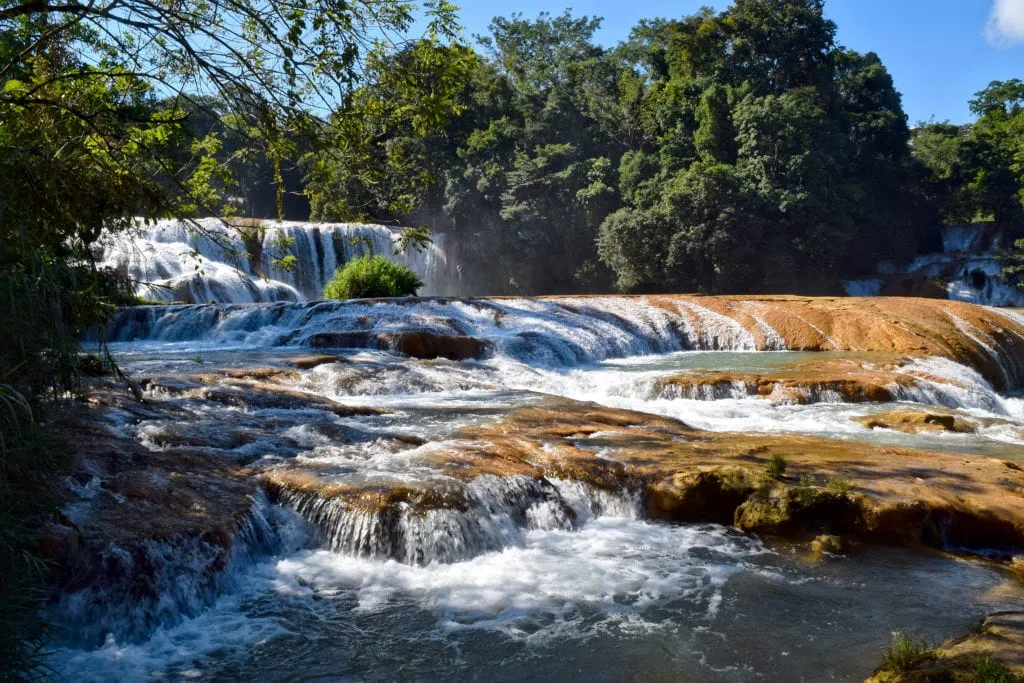
Don’t start checking off the best things to do in Chiapas without travel insurance! We use and recommend Safety Wing for their affordability, ease of purchasing & the clarity of their contract!
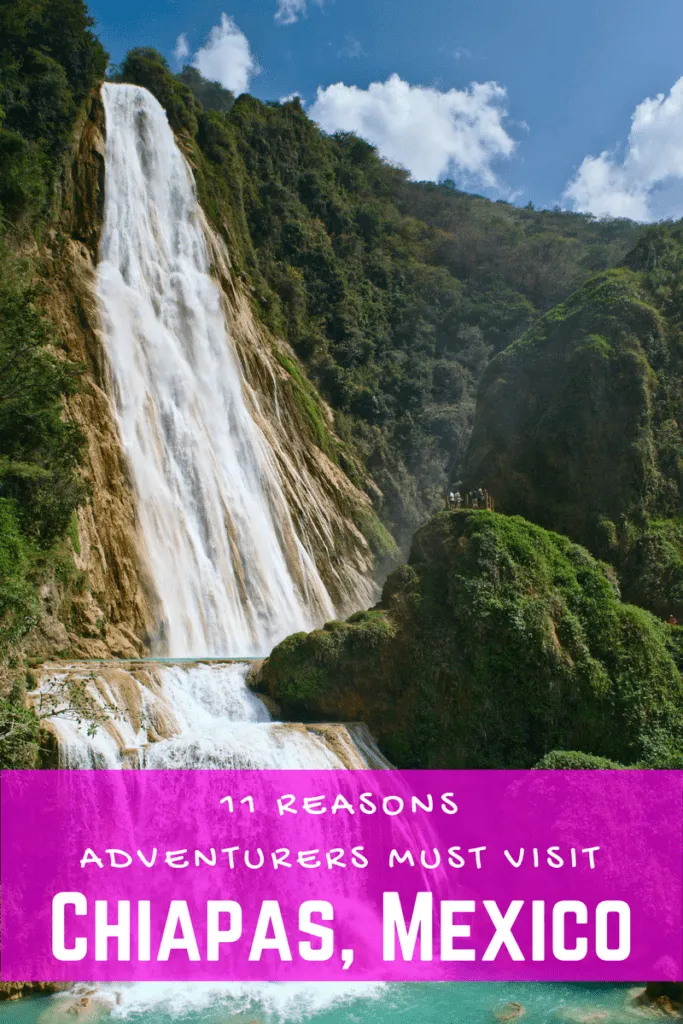
About Kate Storm

In May 2016, I left my suburban life in the USA and became a full-time traveler. Since then, I have visited 50+ countries on 5 continents and lived in Portugal, developing a special love of traveling in Europe (especially Italy) along the way. Today, along with my husband Jeremy and dog Ranger, I’m working toward my eventual goal of splitting my life between Europe and the USA.
23 thoughts on “11 Cool Things to Do in Chiapas, Mexico”
Grandpa enjoyed looking at your pictures on his new IPad. Have a lot to learn using the new toy.
Oh, we’re so glad to hear that! We love you and miss you. Looking forward to calling as soon as we can get strong enough Wifi.
I loved this blog post! found it on pinterest when I typed in Chiapas. Where all did yall stay during your trip?
Thanks, Calle! We stayed in an Airbnb in San Cristobal de las Casas. I definitely recommend San Cristobal–it’s the perfect place for exploring Chiapas, and a great city in its own right.
I was wondering the same thing – good to know! Pretty easy and affordable taking taxis around to all of your destinations?
Very! We used a combination of taxis and group tours in shuttle buses/vans to get around. All were easy to use and very affordable.
Hi, great post…I will be reading a lot more of your blog…I am planning a 3 week trip to Mexico in August, and 4-5 days in Chiapas (do you think it’s enough to explore Chiapas?). Are the tour prices really that cheap? I can see you’ve been there just this year? What is the best way to get there from Mexico city? Are the buses ok, or is it better to fly? Thanks, Everton
Hey Everton! 4-5 days is definitely enough to get a solid taste of the area, though you’ll be leaving some things undone–all the more reason to come back later!
Yes, the tour prices really are that cheap, at least as of January 2017.
We took a bus from Puerto Escondido to San Cristobal, so didn’t come directly from Mexico City. ADO buses should be able to get you between the two points fairly easily (though it’s a long ride!). We had nothing but good experiences with ADO buses–they were all clean, modern, and efficient, included a/c and some even had charging stations in the seats. I don’t see any reason to fly unless you are very worried about time.
Hope you have an awesome time!
That’s great Kate, thanks for the tips. One more thing. Do you know if the tours from San Cristobal to Palenque allow you to take your luggage? I was thinking to do a tour to Palenque, but then stay in Palenque instead of returning to San Cristobal, which means we’ll have to take the lugagges. I couldn’t find any info on this on the internet…Thanks
Anytime, Everton!
Our tour guide let us bring our luggage and didn’t even bat an eye when we asked, and I imagine most others will react similarly. We were in a sedan, and they just through our bags in the trunk. Chiapas is a pretty casual place–if you tell the tour company what you’re looking for, I’d say the odds of them turning your money away are very slim!
Thats awesome to know, my plans should work then…Thanks Kate
Happy to help, Everton!
where did you stay ? thank you !
Hi Paul! We stayed in this Airbnb: https://www.airbnb.com/rooms/13079917
The layout was a bit odd–half of it was separated by a private outdoor space–but we liked it well enough. :-)
what company did you use for your horseback riding tour
Honestly, I have no idea! We just booked from one of the many tourist agencies in town. The people in our group came from several different agencies/hotels/hostels–essentially, they just combined us into one tour. Not sure if the horseback riding team had an official company name or not.
Jeremy and Kate ..I am a Scotsman who lives in Chiriqui Panama, was thinking of a trip to Chiapas and other places in Mexico ..I’m a seasoned traveller and use hostels etc
My question is when you done the trip to Panama did you use the TICA BUS , THEY GO FROM Panama to Chiapas ..if you did how did you find it, there web site is quite good and I like the idea that you can plan some time in other countries as well ,they seem quite flexable.
Thanks in Advance Donald
Nope, I’m not familiar with Tica Bus. We used local buses in some areas and booked shuttles through tourist agencies on the ground in others, but we booked everything as we went!
Hi, thanks for your post. My husband, daughters (11 & 13) and I are spending two weeks in Chiapas in July. We’re planning on spending a few days each, in about 4 or 5 cities, and visiting many of the places you listed. I’m not sure when you were there last, but I was wondering whether the Central American migrants are impacting traffic (e.g. walking on the highways) or whether you encountered blockades? We’ll have rental car. I speak Spanish and have driven in Mexico City and other cities in Mexico, but I’m a little anxious about the state of the roads (narrow? pot-hole ridden?). It seems to make more sense for us to rent a car (cost and flexibility) vs. taking a bus everywhere. Did you make it to Frontera Corozal or Yaxchilan? Thanks!
Hi Norma! We were in Chiapas in early 2017, so I’m not sure if there are any incredibly recent issues, but I suspect the odds of running into an issue with travelers on foot/blockades in Chiapas is minimal. I’d recommend asking a local before you arrive (maybe at your hotel or your Airbnb host?) and seeing if they know of anything recent.
Best I can remember, the roads weren’t incredibly well maintained (LOTS of speed bumps, and yes narrow in places), and there weren’t street lights everywhere, so things got very, very dark on the road. If you’re used to driving in Mexico I wouldn’t rule out driving as a possibility, but just go in with caution.
We didn’t make it to Frontera Corozal or Yaxchilan on our last trip, but maybe next time! We’d love to return to Chiapas.
It’s probably too late for your own trip, I was back in Chiapas around 2008, Commandante Zero was running for president in a balaclava. There were blockades of a sort, Mostly stop and searches on the buses. But the agents kept well away from me, in a way that was almost awkward. Near the border, taxi cab drivers fought over taking north, because the minute the immigration agents see a white person in the taxi, they’ll leave it alone. Many local Mestizo Mexicans HATE immigrants from Guatemala and further south. I had a conversation in Spanish with a local man who complained that the “Indios guatemaltecos” didn’t know Spanish (many only speak dialects of Mayan and other indigenous people) and didn’t want to learn, they were only there to take their jobs! Sound familiar? When migrants on the trains go through towns in Guatemala, children throw candies, when they pass the border, children throw rocks at them. You will not run into immigrants on the roads, because they rightfully fear the locals and the federales. It gets much worse, I was naive and thought Mestizos could not be racist against the indigenous people. I was very wrong. Maybe things have changed, but I doubt it. Be prepared to encounter barefoot children offering to shine your shoes. Heartbreaking.
Thanks for this informative blog post! Do you remember the tour company you used for the horseback riding to the indigenous villages & San Juan Chamula church?
Not only do I not remember, but I’m also pretty sure I never got a name in the first place! We booked it through an agency in town (not sure which one), but like in many places around the world, our actual tour group was composed of people who had booked at different places around town.
I have no doubt you’ll be able to find plenty of agencies in town offering the tour. We definitely recommend taking it! :-)
Leave a Comment Cancel reply

IMAGES
COMMENTS
The Ultimate Chiapas Travel Guide. Chiapas is a hidden gem and bucket list adventure that offers a truly immersive and authentic travel experience for visitors looking to get off the beaten path. It's an enchanting land with acres of pristine wilderness, over a dozen prehispanic cultures and languages, and some of the most iconic ...
Heading to Chiapas, Mexico? Discover the best Chiapas tours that you can take from San Cristobal de las Casas, Tuxtla Gutiérrez, or Palenque.
Top Chiapas Tours: See reviews and photos of tours in Chiapas, Mexico on Tripadvisor.
By taking in three very different Maya communities, this tour offers a great perspective on life in Chiapas, with a guide to help you understand the things you see and connect with local people.
In this travel guide, we'll give you 10 excellent Chiapas tour options, ensuring you'll see the absolute best of this beautiful Mexican state, with complete ease and peace of mind. Read 15 Wonderful Things To Do In Chiapas, Mexico guide.
Find the top-rated and best-reviewed tours and activities in Chiapas for 2024. From prices and availability to skip-the-line options and mobile tickets, get all the information you need to make the most of your trip to Mexico.
Explore the natural wonders and cultural treasures of Chiapas, Mexico, with our comprehensive travel guide. From the colonial charm of San Cristobal de las Casas to the ancient ruins of Palenque and Yaxchilán, and the breathtaking waterfalls of Misol Ha and Agua Azul, discover the best of Chiapas for your next adventure.
Chiapas, Mexico's southernmost state, is steeped in Mayan heritage and an under-the-radar place for history, adventure, and crafts.
This ultimate Chiapas travel guide will walk you through everything you need to know about exploring this amazing Mexican state!
Your guide to Chiapas Mexico's best waterfalls, Mayan ruins, historic towns, and coffee tasting spots.
An overview of the best things to do in Chiapas Mexico - from cultural and historical highlights to nature hikes and gastronomy
Here's everything you need to know for Chiapas travel! Home to San Cristobal de las Casas and Palenque, you'll love this Mexico travel destination.
Plan your visit to Chiapas, Mexico: find out where to go and what to do in Chiapas with Rough Guides.
Interactive Map Visit the tourist destinations of Chiapas, hover over the illustrations on the map and click to learn more about the destination.
Book the most popular Guided tours in Chiapas. Best price and money back guarantee! Read the reviews of your fellow travelers.
Top Chiapas Tours: See reviews and photos of the best Chiapas private tours and licensed local guides. Plan a day trip and request an itinerary.
Browse 21 tours from the best tour operators in Chiapas with 5 reviews visiting places like Palenque and Tuxtla Gutierrez. Compare & book now!
Day 2: Mexico City Join your Tour Leader and start the Chiapas Tour with a walking tour around the UNESCO-listed historic center of Mexico City and a visit to the National Museum of Anthropology. Then, choose by yourself what to do next - your Tour Leader will be happy to give suggestions. Optional dinner and get-together with the group in the evening.
Discover Chiapas on a private tour with a local tour guide. Book our guided tours in Chiapas now & experience the best things to do in the city.
Here's EVERYTHING you NEED to know about visiting Chiapas, Mexico including the best things to do, where to stay, and more.
Chiapas, Mexico is home to waterfalls, caves, colorful cities, and rock bottom prices. Don't miss these amazing things to do in Chiapas!
Book the most popular Tours in Chiapas. Best price and money back guarantee! Read the reviews of your fellow travelers.
Here is the ultimate Chiapas road trip itinerary covering all the best highlights in Chiapas, Mexico. Ideal for road tripping in Chiapas for 1, 2, or 3 weeks.